5.4: Japan
- Page ID
- 67050
\( \newcommand{\vecs}[1]{\overset { \scriptstyle \rightharpoonup} {\mathbf{#1}} } \)
\( \newcommand{\vecd}[1]{\overset{-\!-\!\rightharpoonup}{\vphantom{a}\smash {#1}}} \)
\( \newcommand{\id}{\mathrm{id}}\) \( \newcommand{\Span}{\mathrm{span}}\)
( \newcommand{\kernel}{\mathrm{null}\,}\) \( \newcommand{\range}{\mathrm{range}\,}\)
\( \newcommand{\RealPart}{\mathrm{Re}}\) \( \newcommand{\ImaginaryPart}{\mathrm{Im}}\)
\( \newcommand{\Argument}{\mathrm{Arg}}\) \( \newcommand{\norm}[1]{\| #1 \|}\)
\( \newcommand{\inner}[2]{\langle #1, #2 \rangle}\)
\( \newcommand{\Span}{\mathrm{span}}\)
\( \newcommand{\id}{\mathrm{id}}\)
\( \newcommand{\Span}{\mathrm{span}}\)
\( \newcommand{\kernel}{\mathrm{null}\,}\)
\( \newcommand{\range}{\mathrm{range}\,}\)
\( \newcommand{\RealPart}{\mathrm{Re}}\)
\( \newcommand{\ImaginaryPart}{\mathrm{Im}}\)
\( \newcommand{\Argument}{\mathrm{Arg}}\)
\( \newcommand{\norm}[1]{\| #1 \|}\)
\( \newcommand{\inner}[2]{\langle #1, #2 \rangle}\)
\( \newcommand{\Span}{\mathrm{span}}\) \( \newcommand{\AA}{\unicode[.8,0]{x212B}}\)
\( \newcommand{\vectorA}[1]{\vec{#1}} % arrow\)
\( \newcommand{\vectorAt}[1]{\vec{\text{#1}}} % arrow\)
\( \newcommand{\vectorB}[1]{\overset { \scriptstyle \rightharpoonup} {\mathbf{#1}} } \)
\( \newcommand{\vectorC}[1]{\textbf{#1}} \)
\( \newcommand{\vectorD}[1]{\overrightarrow{#1}} \)
\( \newcommand{\vectorDt}[1]{\overrightarrow{\text{#1}}} \)
\( \newcommand{\vectE}[1]{\overset{-\!-\!\rightharpoonup}{\vphantom{a}\smash{\mathbf {#1}}}} \)
\( \newcommand{\vecs}[1]{\overset { \scriptstyle \rightharpoonup} {\mathbf{#1}} } \)
\( \newcommand{\vecd}[1]{\overset{-\!-\!\rightharpoonup}{\vphantom{a}\smash {#1}}} \)
\(\newcommand{\avec}{\mathbf a}\) \(\newcommand{\bvec}{\mathbf b}\) \(\newcommand{\cvec}{\mathbf c}\) \(\newcommand{\dvec}{\mathbf d}\) \(\newcommand{\dtil}{\widetilde{\mathbf d}}\) \(\newcommand{\evec}{\mathbf e}\) \(\newcommand{\fvec}{\mathbf f}\) \(\newcommand{\nvec}{\mathbf n}\) \(\newcommand{\pvec}{\mathbf p}\) \(\newcommand{\qvec}{\mathbf q}\) \(\newcommand{\svec}{\mathbf s}\) \(\newcommand{\tvec}{\mathbf t}\) \(\newcommand{\uvec}{\mathbf u}\) \(\newcommand{\vvec}{\mathbf v}\) \(\newcommand{\wvec}{\mathbf w}\) \(\newcommand{\xvec}{\mathbf x}\) \(\newcommand{\yvec}{\mathbf y}\) \(\newcommand{\zvec}{\mathbf z}\) \(\newcommand{\rvec}{\mathbf r}\) \(\newcommand{\mvec}{\mathbf m}\) \(\newcommand{\zerovec}{\mathbf 0}\) \(\newcommand{\onevec}{\mathbf 1}\) \(\newcommand{\real}{\mathbb R}\) \(\newcommand{\twovec}[2]{\left[\begin{array}{r}#1 \\ #2 \end{array}\right]}\) \(\newcommand{\ctwovec}[2]{\left[\begin{array}{c}#1 \\ #2 \end{array}\right]}\) \(\newcommand{\threevec}[3]{\left[\begin{array}{r}#1 \\ #2 \\ #3 \end{array}\right]}\) \(\newcommand{\cthreevec}[3]{\left[\begin{array}{c}#1 \\ #2 \\ #3 \end{array}\right]}\) \(\newcommand{\fourvec}[4]{\left[\begin{array}{r}#1 \\ #2 \\ #3 \\ #4 \end{array}\right]}\) \(\newcommand{\cfourvec}[4]{\left[\begin{array}{c}#1 \\ #2 \\ #3 \\ #4 \end{array}\right]}\) \(\newcommand{\fivevec}[5]{\left[\begin{array}{r}#1 \\ #2 \\ #3 \\ #4 \\ #5 \\ \end{array}\right]}\) \(\newcommand{\cfivevec}[5]{\left[\begin{array}{c}#1 \\ #2 \\ #3 \\ #4 \\ #5 \\ \end{array}\right]}\) \(\newcommand{\mattwo}[4]{\left[\begin{array}{rr}#1 \amp #2 \\ #3 \amp #4 \\ \end{array}\right]}\) \(\newcommand{\laspan}[1]{\text{Span}\{#1\}}\) \(\newcommand{\bcal}{\cal B}\) \(\newcommand{\ccal}{\cal C}\) \(\newcommand{\scal}{\cal S}\) \(\newcommand{\wcal}{\cal W}\) \(\newcommand{\ecal}{\cal E}\) \(\newcommand{\coords}[2]{\left\{#1\right\}_{#2}}\) \(\newcommand{\gray}[1]{\color{gray}{#1}}\) \(\newcommand{\lgray}[1]{\color{lightgray}{#1}}\) \(\newcommand{\rank}{\operatorname{rank}}\) \(\newcommand{\row}{\text{Row}}\) \(\newcommand{\col}{\text{Col}}\) \(\renewcommand{\row}{\text{Row}}\) \(\newcommand{\nul}{\text{Nul}}\) \(\newcommand{\var}{\text{Var}}\) \(\newcommand{\corr}{\text{corr}}\) \(\newcommand{\len}[1]{\left|#1\right|}\) \(\newcommand{\bbar}{\overline{\bvec}}\) \(\newcommand{\bhat}{\widehat{\bvec}}\) \(\newcommand{\bperp}{\bvec^\perp}\) \(\newcommand{\xhat}{\widehat{\xvec}}\) \(\newcommand{\vhat}{\widehat{\vvec}}\) \(\newcommand{\uhat}{\widehat{\uvec}}\) \(\newcommand{\what}{\widehat{\wvec}}\) \(\newcommand{\Sighat}{\widehat{\Sigma}}\) \(\newcommand{\lt}{<}\) \(\newcommand{\gt}{>}\) \(\newcommand{\amp}{&}\) \(\definecolor{fillinmathshade}{gray}{0.9}\)From Shinto shrines and Buddhist gardens to the images of Hiroshige and Mariko Mori.
6th century C.E. - present
A beginner's guide
A brief history of the arts of Japan: the Jomon to Heian periods
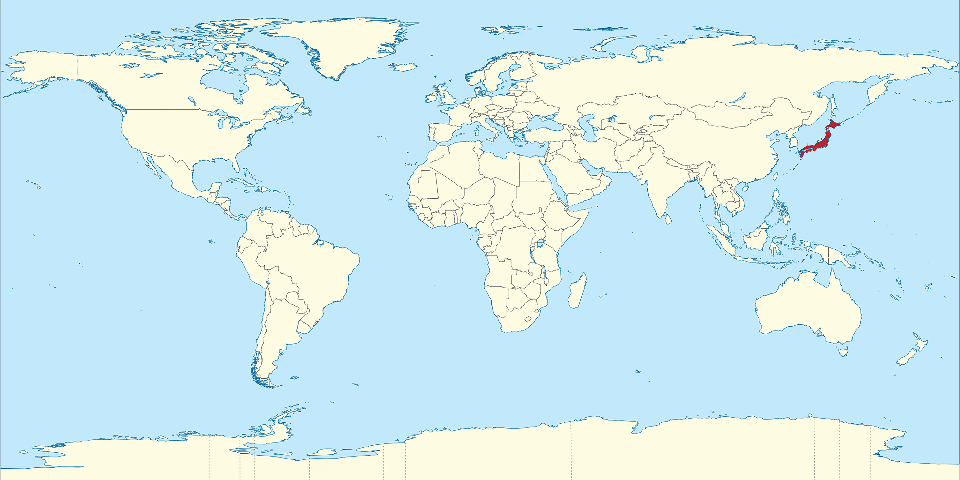
The arts of Japan are profoundly intertwined with this country’s long and complex history. They are also often in dialogue with artistic and cultural developments in other parts of the world. From the earliest aesthetic expressions of the Neolithic period to today’s contemporary art—here is a brief survey to get you started.
Please note that while the material is organized chronologically, it highlights major themes and introduces makers and objects recognized as especially influential.
Jōmon period (c. 10,500 – c. 300 B.C.E.): grasping the world, creating a world
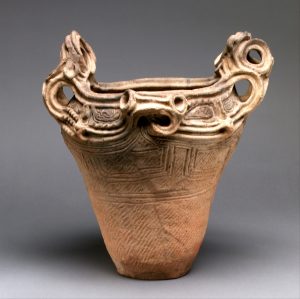
The Jōmon period is Japan’s Neolithic period. People obtained food by gathering, fishing, and hunting and often migrated to cooler or warmer areas as a result of shifts in climate. In Japanese, jōmon means “cord pattern,” which refers to the technique of decorating Jōmon-period pottery.
As in most Neolithic cultures around the world, women made pots by hand. They would build vessels from the bottom up from coils of wet clay, mixed with other materials such as mica and crushed shells. The pots were then smoothed both inside and out and decorated with geometric patterns. The decoration was achieved by pressing cords on the malleable surface of the still moist clay body. Pots were left to dry completely before being fired at a low temperature (most likely, just reaching 900 degrees Celsius) in an outdoor fire pit.
Later in the Jōmon period, vessels presented ever more complex decoration, made through shallow incisions into the wet clay, and were even colored with natural pigments. Jōmon-period cord-marked pottery illustrates the remarkable skill and aesthetic sense of the people who produced them, as well as stylistic diversity of wares from different regions.
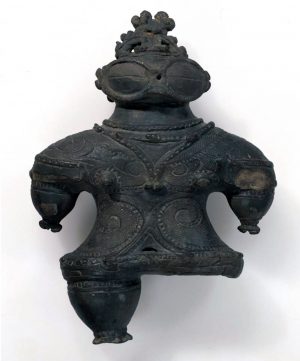
Also from the Jōmon period, clay figurines have been found that are known in Japanese as dogū. These typically represent female figures with exaggerated features such as wide or goggled eyes, tiny waists, protruding hips, and sometimes large abdomens suggestive of pregnancy. They are unique to this period, as their production ceased by the 3rd century B.C.E. Their strong association with fertility and mysterious markings “tattooed” onto their clay bodies suggest their potential use in spiritual rituals, perhaps as effigies or images of goddesses. Besides dogū, this period also saw the production of phallic stone objects, which may have been a part of the same fertility rituals and beliefs.
Images of the female body as symbols of fertility are encountered in many parts of the world in the Neolithic period, presenting features unique to the regions and cultures that produced them. The preoccupation with fertility was increasingly twofold, namely the fertility of women and that of the land, as people began cultivating it and transitioning to a settled agricultural society.
Yayoi period (300 B.C.E. – 300 C.E.): influential importations from the Asian continent (I)
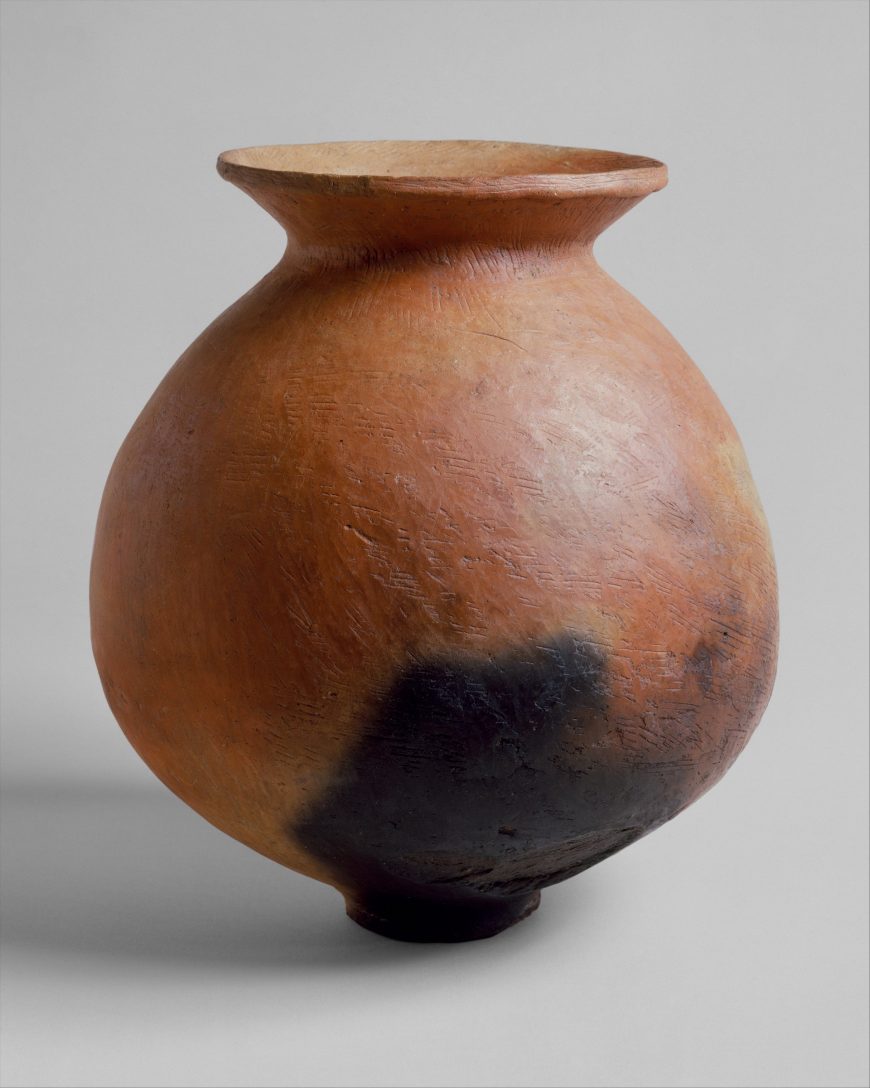
People from the Asian continent who were cultivating crops migrated to the Japanese islands. Archaeological evidence suggests that these people gradually absorbed the Jōmon hunter-gatherer population and laid the foundation for a society that cultivated rice in paddy fields, produced bronze and iron tools, and was organized according to a hierarchical social structure. The Yayoi period’s name comes from a neighborhood of Tokyo, Japan’s capital, where artifacts from the period were first discovered.
Yayoi-period artifacts include ceramics that are stylistically very different from the cord-marked Jōmon-period ceramics. Although the same techniques were used, Yayoi pottery has sharper and cleaner shapes and surfaces, including smooth walls, sometimes covered in slip slip, and bases on which the pots could stand without being suspended by rope. Burnished surfaces, finer incisions, and sturdy constructions that suggest an interest in symmetry are characteristic of Yayoi pots.
Slip is a liquid clay mixture used in the production and decoration of pottery.
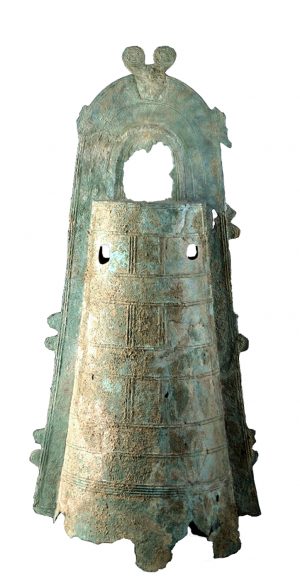
Some studies suggest that Yayoi pottery is linked to Korean pottery of the time. The Korean influence extends beyond ceramics and can be seen in Yayoi metalwork as well. Notably, Yayoi period clapper-less bronze bells closely resemble much smaller Korean bells that were used to adorn domesticated animals such as horses.
These bells, together with bronze mirrors and occasionally weapons, were buried on hilltops. This practice was seemingly linked to ritual and may have been considered auspicious, perhaps for the fertility of the land in this primarily agricultural society. The magical or ritualistic function of the bells is further suggested by the fact that the bells were not only clapper-less, but they also had walls that were too thin to ring when hit.
The bells became larger later in the Yayoi period, and it is believed that the function of these larger bells was ornamental. Across regions and over the span of a few centuries, such bells varied in size from approximately 10 cm to over 1 meter in height.
Kofun period (ca. 3rd century – 538): influential importations from the Asian continent (II)
The Kofun 古墳 period is so named after the burial mounds of the ruling class. The practice of building tomb mounds of monumental proportions and burying treasures with the deceased arrived from the Asian continent during the 3rd century. Originally unadorned, these tombs became increasingly ornate; by the 6th century, burial chambers had painted decorations. The burial mounds were encircled with stones; hollow clay earthenware, known in Japanese as haniwa 埴輪, were scattered for protection on the land surrounding the mounds. Kofun were typically keyhole-shaped, had several tiers, and were surrounded by moats. The resulting structure amounted to an impressive display of power, advertising the control of the ruling families. The largest kofun is the Nintoku mausoleum, measuring 486 meters!

The hollow clay objects, haniwa, that were scattered around burial mounds in the Kofun period, have a fascinating history in their own right. Initially simple cylinders, haniwa became representational over the centuries, first modeled as houses and animals and ultimately as human figures, typically warriors. The later pieces have been of great help to anthropologists and historians as tokens of the material culture of the Kofun period, offering a glimpse into that society. Whether offerings for the dead or protective barriers meant to guard the tombs, haniwa have a strong aesthetic identity that continues to be a source of inspiration for Japanese ceramists.
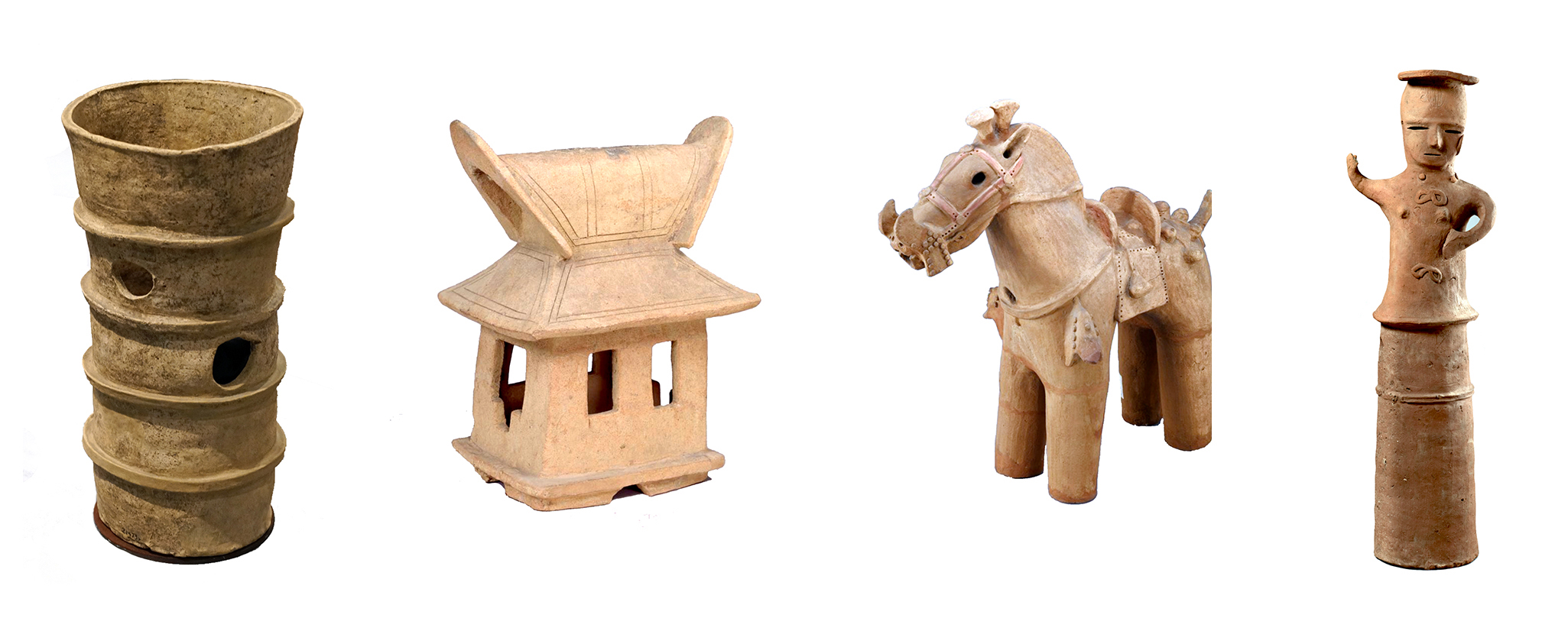
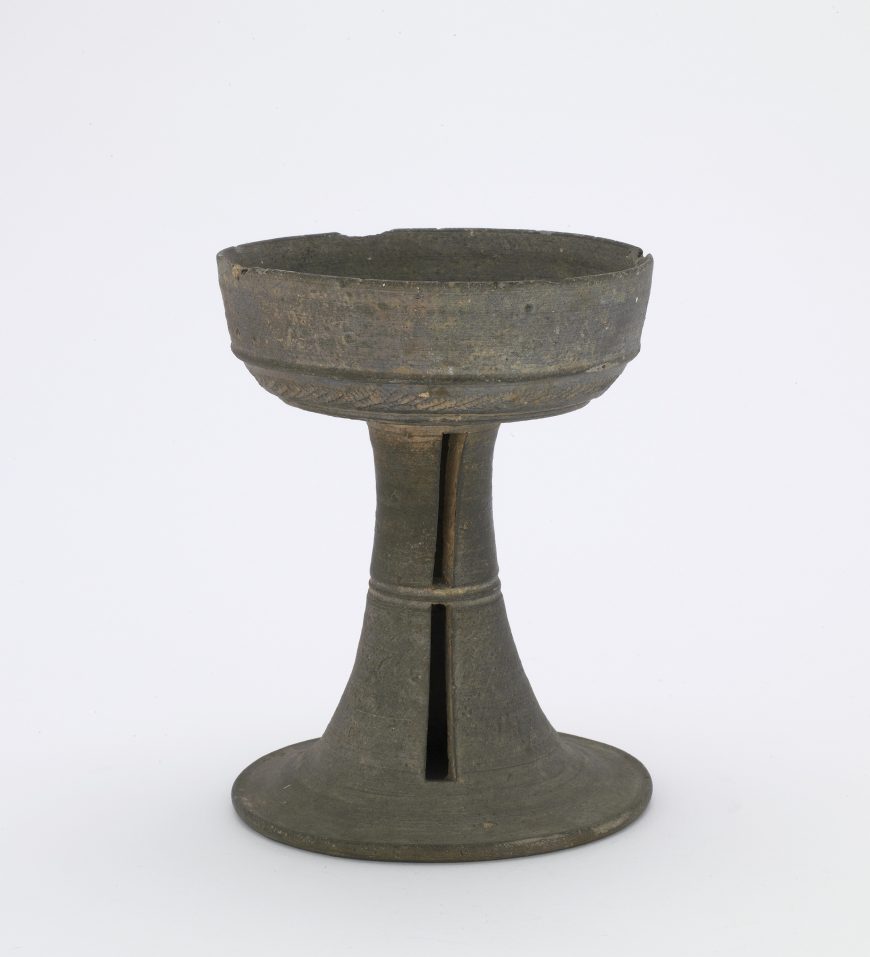
Through gradual consolidation of political power, the Kofun-period Yamato clan became a kingdom with seemingly remarkable control over the population. In the 5th century, its center moved to the historical Kawachi and Izumi provinces (on the territory of present-day Osaka prefecture). It is there that the largest of the kofun burial mounds testify to a thriving Yamato society, one that was increasingly more secular and military.
Simultaneously, the potter’s wheel was used for the first time in Japan, likely transmitted from Korea, where it had been adopted from China. This new technology was used to produce what is known as Sue ware—typically bluish-gray or charcoal-white footed jars and pitchers that had been fired in sloped-tunnel, single-chamber kilns (anagama 穴窯) at temperatures exceeding 1,000 degrees celsius. Like other types of ancient Japanese pottery, Sue ware continues to be a source of inspiration for ceramists, in Japan and beyond.
Asuka period (538-710): the introduction of Buddhism
The Asuka period is Japan’s first historical period, different from the prehistoric periods reviewed so far because of the introduction of writing via Korea and China. With the Chinese written language also came standardized measuring systems, currency in the form of coins, and the practice of recording history and current events. Standardization and record-keeping also encouraged the crystallization of a centralized, bureaucratic government, modeled on the Chinese.
All this was imported when a new religion—Buddhism—was introduced in Japan, significantly changing Japanese culture and society. Unlike Japan’s indigenous “way of the gods” (Shintō), Buddhism had anthropomorphic representations of deities. After the introduction of Buddhism, we see a shift in the visual and material culture of Shintō. If, before Buddhism, Shintō gods were associated with sacred objects such as mirrors and swords (the imperial insignia), after the introduction of the new religion they began to be represented in anthropomorphic images, although such images were hidden in the inner sanctuaries of Shintō shrines.
Japan’s indigineous religion, Shintō entails belief in the sacred power of animate and inanimate things, as well as ritual practices for the worship of ancestors and gods, known as kami.
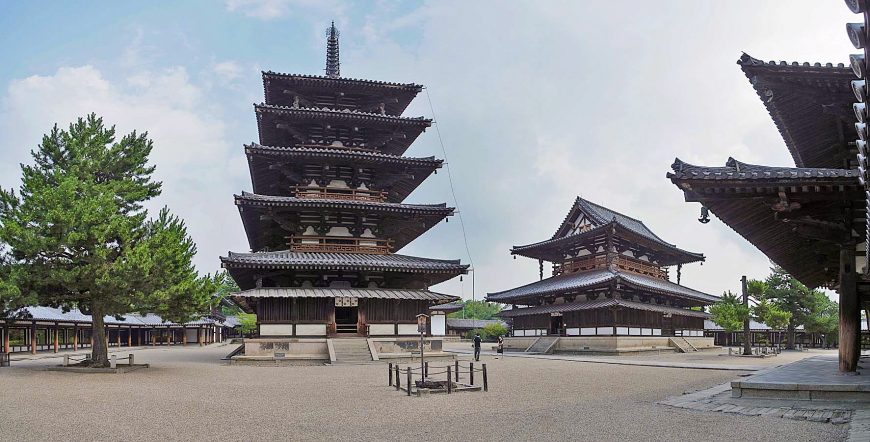
By the time Buddhism reached Japan, it had spread from India to China and had undergone several changes in imagery and styles. In Japan, Buddhism profoundly influenced indigenous culture, but it was equally shaped by it, resulting in new forms and modes of expression. The imperial household embarked on major Buddhist commissions. One of the earliest and most spectacular is a temple in Nara, Hōryūji or the “temple of flourishing law.” The founding of Hōryūji is attributed to the ailing emperor Yomei, who died before seeing the temple completed; Yomei’s consort, empress Suiko, and regent Prince Shōtoku (574-622) carried out the late emperor’s wishes. Given the influence of empress Suiko’s Buddhist patronage, the Asuka period is also referred to as the Suiko period. Prince Shōtoku, too, is celebrated as one of the earliest champions of Buddhism in Japan. In fact, a century after his death, he began to be worshipped as an incarnation of the historical Buddha.
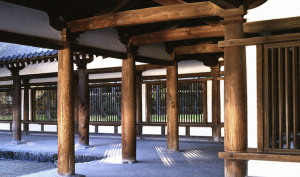
Like the enduring legend and legacy of Prince Shōtoku, Hōryūji has had a long and complex life well past the Asuka Period. With structures that vanished in fires and earthquakes as early as the 7th century to the temple’s pagoda that was dismantled and reassembled during World War II, Hōryūji underwent numerous changes and its buildings currently date from the Asuka period to the late 16th century! A complex site with some of the world’s oldest wooden structures, Hōryūji exemplifies ancient Japanese architectural techniques and strategies, including the slight midpoint bulging of round columns, which has been compared to the similar practice of entasis in ancient Greek architecture.
Entasis refers to a slightly convex curve in the shaft of a column, used to correct the visual illusion of concavity that occurs with straight shafts.
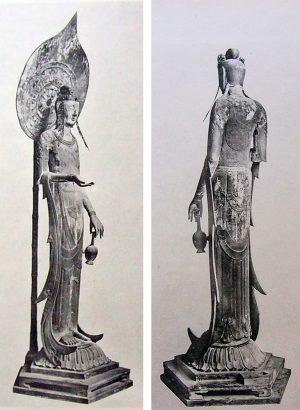
Hōryūji houses one of the best known, albeit mysterious, Buddhist representational sculptures of the Asuka period—the so-called Kudara Kannon 百済観音, a slim and life-size image of the bodhisattva of compassion, sculpted in camphor wood. The first cultural property in Japan to be designated as a “national treasure,” this sculpture first appeared in Japanese records in the 17th century. The “Kudara” in its name, assigned well after the Asuka period, is the Japanese term for Baekje, one of the three historical kingdoms of Korea. The sculpture’s astounding grace derives from its slight smile, slim frame, and flowing lines.

Hōryūji was not the only major temple developed in the Asuka period. When the capital was transferred from Asuka to Nara, a temple known as Hōkōji was relocated as well. In its new location, the temple grew significantly under the name of Gangōji. One of the temple’s treasures is the Asuka daibutsu 飛鳥大仏 or the Great Buddha of Asuka—a devotional image that testifies to the early Buddhist representational tradition in Japan. It is also the oldest of the daibutsu or ‘great Buddhas’—large sculptural devotional images of the Buddha.
Of the original, cast in 609 and attributed to a sculptor of Korean descent, only the face and the fingers of the right hand remain. These details, however, reveal the Chinese-inspired style of Tori Busshi, with soft features, smooth surfaces, and simple and elegant lines.
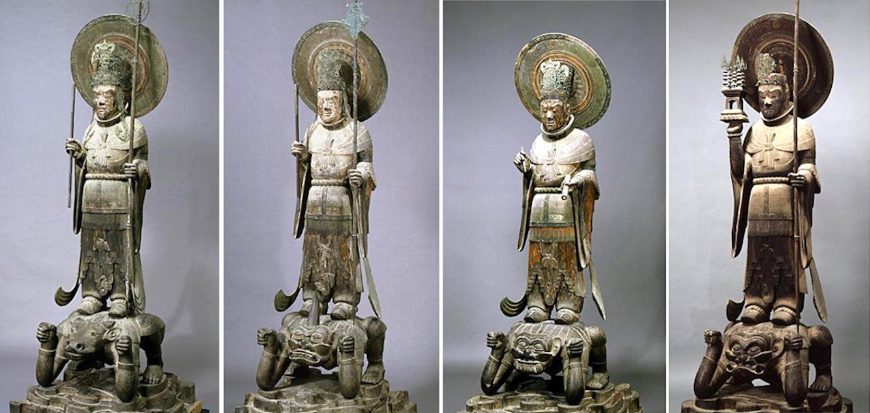
The late Asuka period, also referred to as the Hakuhō period (late 7th century), saw a momentous transformation of Japanese society, prompted by the so-called Taika reforms. Implemented after the death of Prince Shōtoku, these reforms were modeled on the Chinese system of government and led to a greater centralization of Japanese imperial power. In the realm of Buddhist sculpture, the Hakuhō period marked a rapid expansion and dissemination of Buddhist imagery across Japan. Full-bodied sculptures, like the four Heavenly Kings at Hōryūji, are more visually assertive than the Kudara Kannon and announce the influence of Tang-dynasty Chinese culture. In that, the Hakuhō period can also be considered the first segment of the subsequent era—the Nara period.
Nara period (710-794): the influence of Tang-dynasty Chinese culture
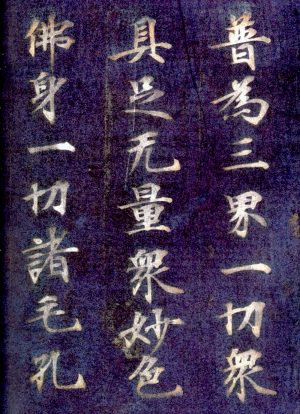
China’s Tang dynasty concentrated such a diverse range of foreign influences that its artistic and cultural characteristics are often referred to as the “Tang international style.” This style had a major impact in Japan as well. Featuring an eclectic and exuberant mix of Central Asian, Persian, Indian, and Southeast Asian motifs, Tang-dynasty visual culture comprised paintings, ceramics, metalware, and textiles.
As these foreign imports were shaping Chinese artistic expression at home, Tang-dynasty artifacts and techniques spread beyond China to neighboring states and along the Silk Road. In Japan, the lavish Tang style was intertwined with Buddhist devotional art.
Elegantly transcribed sutras, calligraphed in silver ink on indigo-dyed paper, exemplify this form of Tang-inspired Nara-period art. The painstaking practice of copying Buddhist sacred texts by using precious materials was deemed to earn spiritual merit for everyone involved, from those preparing the materials to the patrons.
The intermingling of political power and Buddhism in the Nara period found its utmost expression in the building of the “great eastern temple” or Tōdaiji and, within this temple, in the casting of the “great Buddha”—a gigantic bronze statue that stood approximately 15 meters/ 16 yards tall and necessitated all available copper in Japan to produce the casting metal.
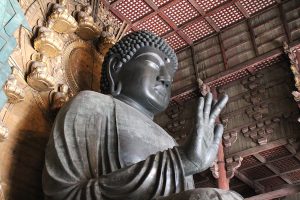
Although the current statue is a later replacement of the Nara-period artifact, it nonetheless suggests the effect of opulence and awe that it must have achieved in its day. Tōdaiji continued to transform and adapt through the centuries, but its identity is still inextricably linked to the grand scale and commensurate ambition of Nara-period culture.
Sociopolitical power was concentrated, during the Nara period, in the new Heijō capital (today’s city of Nara). Surrounded by Buddhist temples, the Heijō palace was the primary site of imperial power. It also housed subsidiary ministries, modeled on the Chinese centralized government. Generous spaces characterized the palace complex. These spaces accommodated outdoor celebrations, like those of the New Year, but also served to emphasize a sense of distance and therefore the due reverence to the emperor. The palace complex was designed to separate the realm of the emperor from the outside world. That principle of separation was reflected within the palace compound itself, where the emperor’s living quarters were set apart from government buildings. The architectural configuration of the palace reflected the hierarchical configuration of power.
Little of the palace survives today, as various structures within the complex suffered the vicissitudes of nature and history, while others were transferred to the new capital, Heian, for which the next period was named.
Heian period (794-1185): courtly refinement and poetic expression
The new capital, Heian or Heian-kyō, was the city known today as Kyoto. There, during the Heian period, a lavish culture of refinement and poetic subtlety developed, and it would have a lasting influence on Japanese arts. The approximately four centuries that comprise the Heian period can be divided into three sub-periods, each of which contributed major stylistic developments to this culture of courtly refinement. The sub-periods are known as Jōgan, Fujiwara, and Insei.
The so-called Jōgan sub-period, spanning the reigns of two emperors during the second half of the 9th century, was rich in architectural and sculptural projects, largely spurred by the emergence and development of the two branches of Japanese esoteric Buddhism. Two Buddhist monks, Saichō and Kūkai (also known as Kobo Daishi), traveled to China on study missions and, upon their respective returns to Japan, went on to found the two Japanese schools of esoteric Buddhism: Tendai, established by Saichō, and Shingon, established by Kūkai.


Among the many ideas and objects that they had brought back from China was the Mandala of the Two Worlds, a pair of mandalas that represent the central devotional image of Japan’s schools of esoteric Buddhism. Comprised of the “Womb World Mandala” (mandala of principle) and the “Diamond World Mandala” (mandala of wisdom), the Mandala of the Two Worlds was first assembled as a pair by Kūkai’s teacher in China. One such pair, still housed in Kūkai’s temple in Kyoto (Tōji, the “eastern temple”) represented a blueprint for countless mandalas made in Japan over the centuries.
Mandalas are diagrams of the universe in Hindu and Buddhist symbolism.
It is believed that the consequential trip to China of Saichō and Kūkai was enabled by a member of the Fujiwara, the family that gives the name of one of the Heian sub-periods. The influence of the Fujiwara clan was paramount in the Japanese political and artistic world of the 9th and 10th centuries. Their power was bolstered by the ever-growing shōen system and ensured by their control of the imperial line, as Fujiwara daughters were married to imperial heirs.
Shōen were tax-exempt private estates that undermined state control.
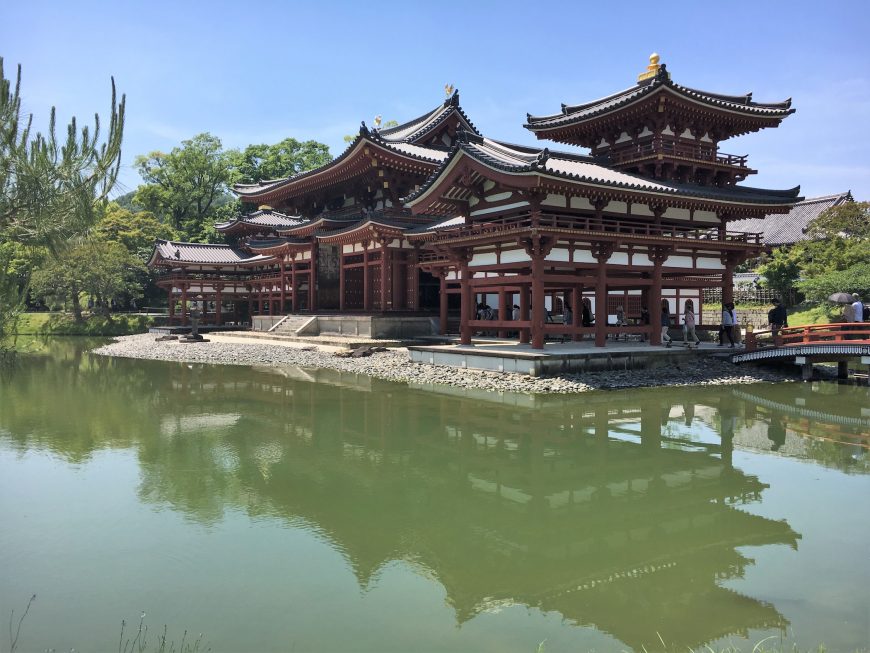
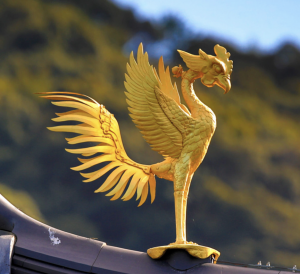
One of the only surviving structures from the Fujiwara period, the Phoenix Hall of the Byōdō-in (a Buddhist temple in Uji, outside Kyoto) is one of Japan’s most valuable cultural assets, with a fascinating, multi-layered story. The Phoenix Hall derives its name from the statues of phoenixes—auspicious mythological birds in East Asian cultures—on its roof.
Completed in 1053, the Phoenix Hall was sponsored by a member of the Fujiwara family—Fujiwara no Yorimichi—a pious believer in yet another type of Buddhism, known as Pure Land. This occurred at a time when many imperial villas like the Byōdō-in were converted into Buddhist temples. Having spread to Japan through the efforts of the monk Hōnen, the Pure Land School of Buddhism taught that enlightenment could be achieved by invoking the name of Amida, the Buddha of infinite light. Practitioners engage in the ritualistic invocation of Amida’s name—the nenbutsu 念仏—hoping to be reborn in Amida’s Pure Land, or the Western Paradise, where they can continue their journey towards enlightenment undisturbed.
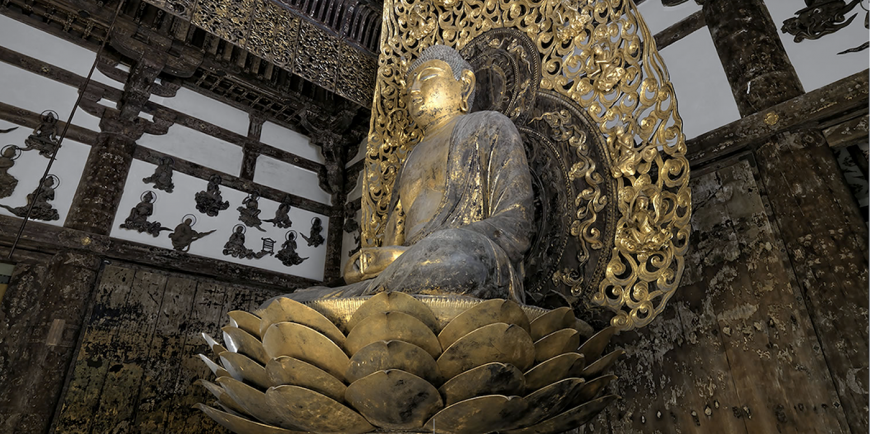
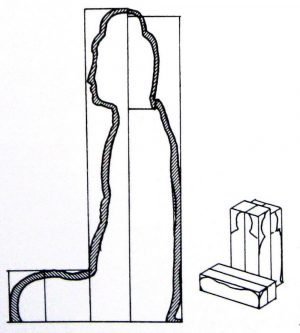
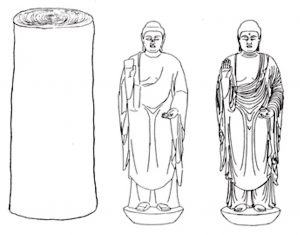
The Amida sculpture in the Phoenix Hall at Byōdō-in is the only work still extant by Jōchō, an influential sculptor who was awarded remarkable distinctions, worked on various commissions from the Fujiwara family, and organized fellow sculptors into a guild. Jōchō’s Amida at Byōdō-in reflects the sculptor’s yosegi-zukuri 寄木造 technique, in which the sculpture is formed from multiple joined pieces of wood. This technique was different from the ichiboku-zukuri 一本造 technique, according to which the sculpture is carved out of a single block of wood.
During the Heian period, the style known as yamato-e (大和絵 or 倭絵) is born. Understood as “Japanese” as opposed to “Chinese” or otherwise “foreign,” yamato-e encompasses a wide range of technical and formal characteristics but refers to specific formats—folding screens (byōbu 屏風) and room partitions (shōji 障子)—and specific choices of subject matter—landscapes with recognizably Japanese features and illustrations of Japanese poetry, history, mythology, and folklore.
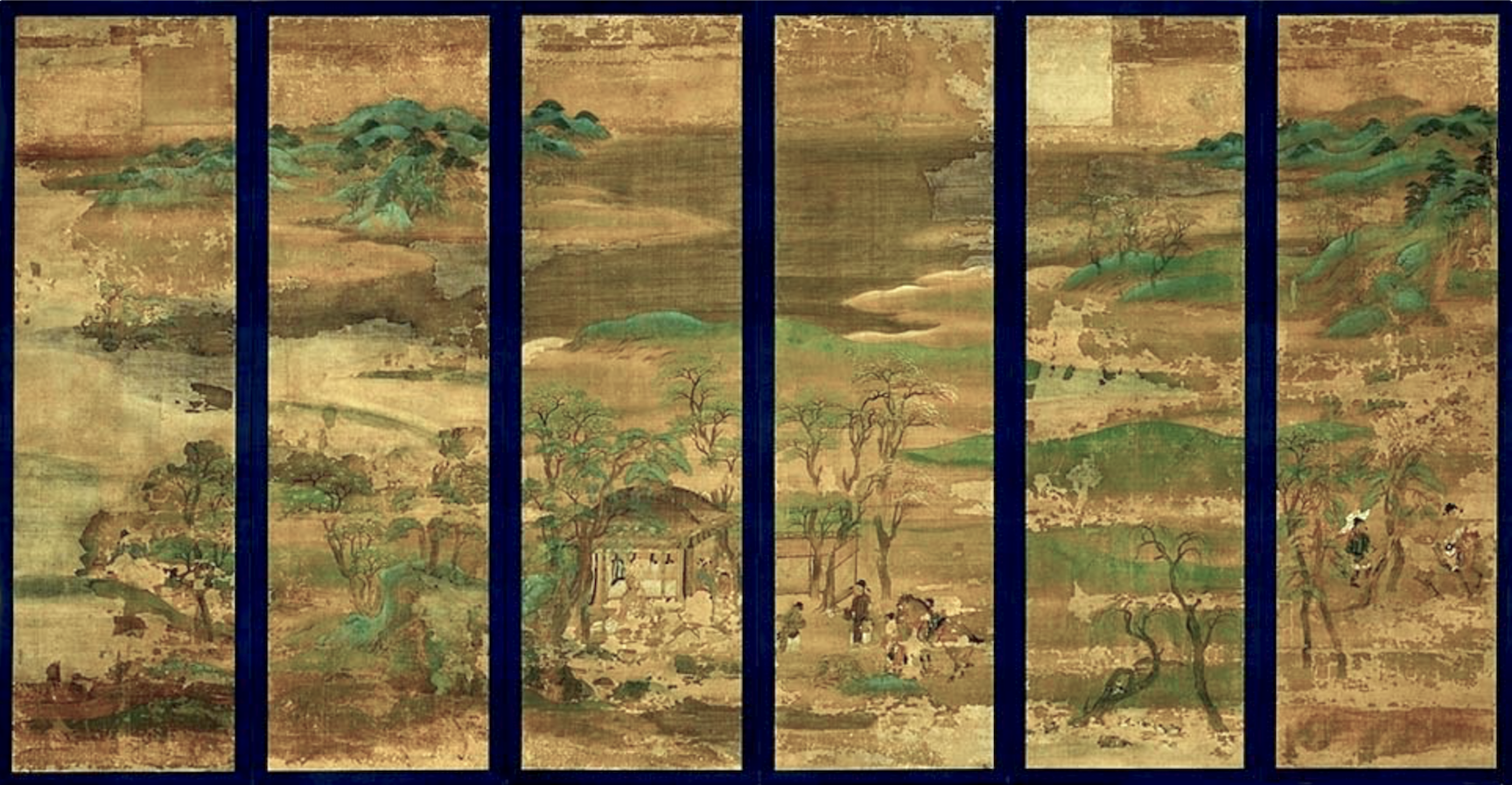
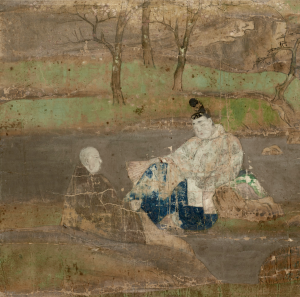
A favorite subject for late-Heian-period yamato-e was the Tale of Genji (Genji monogatari 源氏物語), written in the first years of the 11th century and attributed to a lady-in-waiting at the imperial court, Murasaki Shikibu. A complex novel that focuses on the romantic interests and entanglements of the prince Genji and his entourage, the Tale also provides a fascinating entryway into Heian-period court life, complete with the aesthetic principles and practices that resided at its core.
The earliest illustrations of the Tale came in handscroll format. Surviving fragments exemplify the yamato-e mode of narrative painting: illustrations by episode interspersed with passages of text; roofless buildings, multiple viewpoints (typically both frontal and from above), and schematic renditions of faces ( hikime kagihana 引目鈎鼻, literally translated as “drawn-line eyes, hook-shaped nose.”)
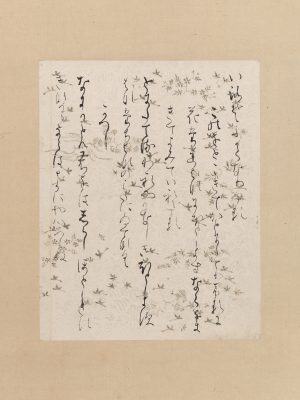
A brief review of the Heian period cannot be complete without mention of the development of Japanese poetry, waka in particular. Waka was an integral part of the Tale of Genji, and Murasaki Shikibu came to be known as one of the 6 immortal poets (all of whom were from the Heian period).
Waka are 5-line poems that speak to the confluence of human emotions and observations about the natural world, divided into 2 sections, namely a 2-line part responding to a 3-line part.
Permeating the spirit of Heian-period Japanese poetry and the imagery it inspired was a heightened sense of refinement, expressed in elegant verse, stylized visual motifs, precious materials, and embellished surfaces.
The Insei rule—the third and last of the Heian sub-periods —refers, literally, to the imperial practice of ruling from within a (monastery) compound. During Insei, cloistered emperors had a higher degree of political control. It was during this period that a sense of aesthetic and ethical congruence developed, according to which the beautiful and the good are intrinsically interconnected.
Cloistered emperors retired and counterbalanced the power of the Fujiwara regents from the quarters of a Buddhist monastery, while their chosen successors fulfilled official duties.
Additional resources
JAANUS, an online dictionary of terms of Japanese arts and architecture
e-Museum, database of artifacts designated in Japan as national treasures and important cultural properties
On Japan in the Metropolitan Museum of Art’s Heilbrunn Timeline of Art History
Richard Bowring, Peter Kornicki, The Cambridge Encyclopedia of Japan (New York: Cambridge University Press, 1993)
A brief history of the arts of Japan: the Kamakura to Azuchi-Momoyama periods
Kamakura period (1185-1333): new aesthetic directions
The Insei rule gave way to an extra-imperial, although imperially sanctioned, military government, known in Japanese as bakufu. Military leaders—called shōguns—first came from the Minamoto family (whose headquarters in Kamakura gave the name to the period), then power concentrated in the (related) Hōjō family. Eventually, the Minamoto and Hōjō shōguns lost their respective control to internal struggles, the pressure of other clans, and an economy bankrupted by coastline fortifications undertaken in response to two (thwarted) Mongol and Korean invasions.
This binary system of government, comprising the shōgun’s rule and the (nominal) rule of the emperor, significantly contributed to a shift in aesthetic interests and artistic expression. The taste of the new military leaders was different from the aesthetic refinement that dominated Heian-period court culture. They embraced instead a sense of honesty in representation and sought works that emanated robust energy. This new development toward life-likeness and a form of idealized realism is particularly evident in portraiture, both two-dimensional and sculptural.
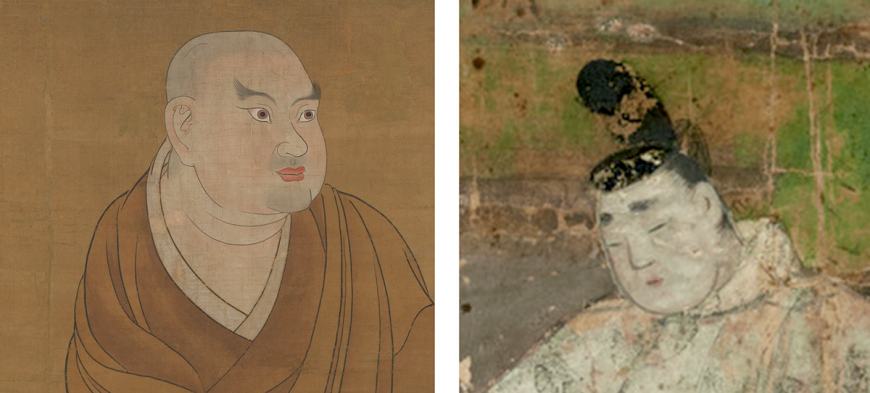
More detailed portraits of lay and religious leaders contrasted with the hikime kagihana (a line for the eye, a hook for the nose) practice of the Heian period, while narrative handscrolls differed from Heian-period Genji-themed pictures in their intricately detailed depictions of historical events. There is no better example than the episode of the “Night Attack on the Sanjō Palace” from the Scroll of Heiji Era Events; here, the visual richness resulting from the imagination of the scroll’s painter(s) makes the depiction appear brutally frank and viscerally impactful.
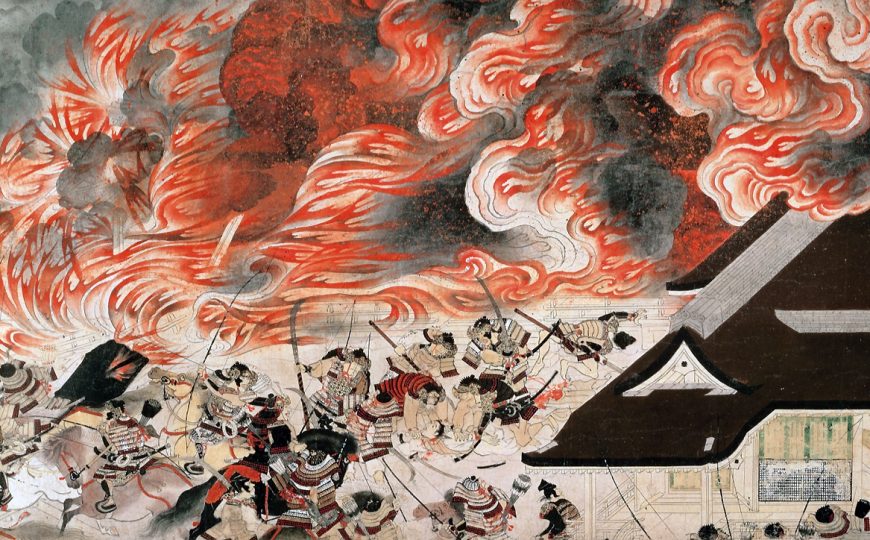
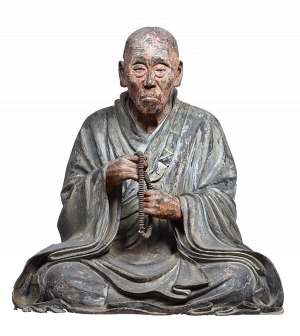
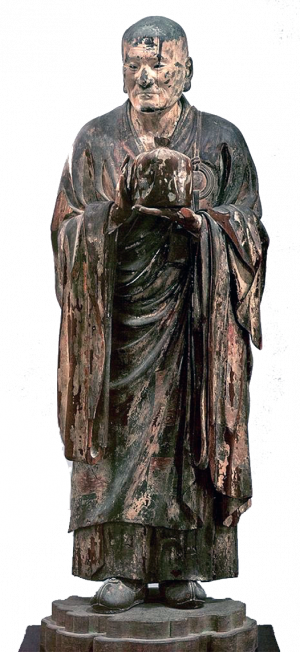
In sculpture, portrayals of revered monks reach an unprecedented degree of realism, whether modeled on the depicted figures or simply imagined. Sometimes the statues would have rock-crystal inlaid eyes, which heightened the immediacy of the figure’s presence.
The sculptor Unkei and his successors, especially Jōkei, created Buddhist sculptures, carved from multiple blocks of wood, whose facial and bodily features expressed not only an interest in life-likeness, but also a sense of monumentality, sheer energy, and visceral force.
During the Kamakura period, the confluence or syncretism of Buddhism and the indigenous Shintō deepened. Paintings like the 14th-century Kumano shrine mandala contain representations of both Buddhist and Shintō deities, divided into registers that illustrate the fusion of the two world-views against the backdrop of famous sacred sites of Japan.
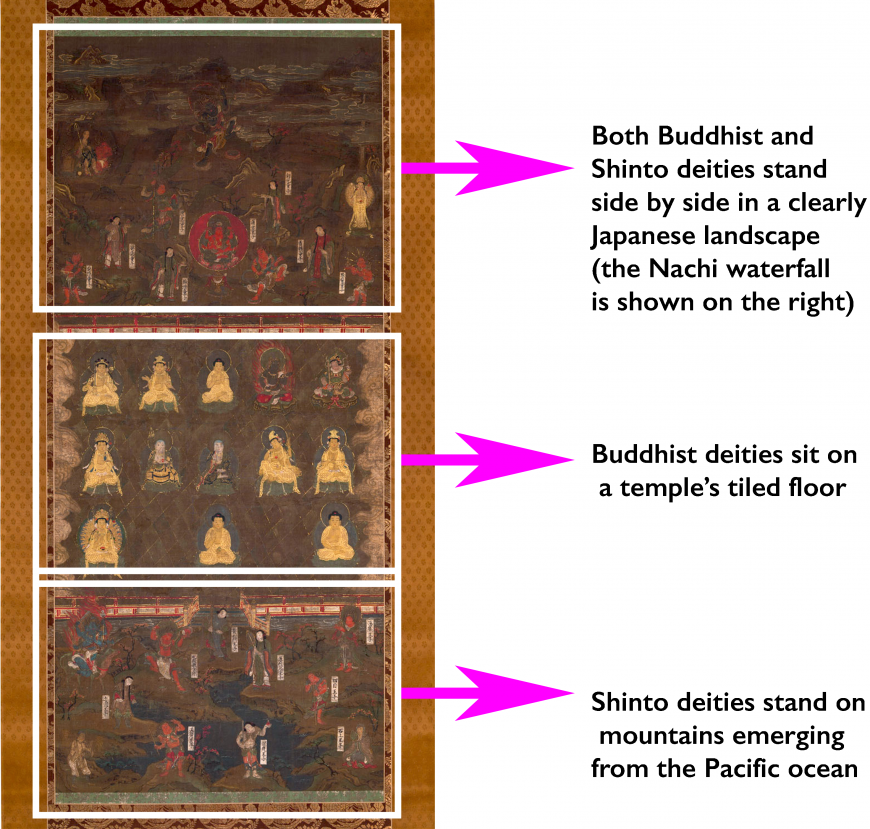
Nanbokuchō (1333 – 1392) and Muromachi (1392 – 1573) periods: Zen principles, ink painting, and elegant beauty
The Muromachi period, coinciding with the rule of Ashikaga shōguns, was one of the most turbulent and violent in Japanese history. It started with the Nanbokuchō (“the period of the southern and northern courts”), during which political power was split between the Ashikaga-controlled “northern” court and the “southern” and short-lived court of emperor Go-Daigo. The Muromachi period also included the Sengoku (“the age of the country at war”), a period of warfare and chaos in the aftermath of the Ōnin war (1467-1477), triggered by rivalry between provincial warlords.
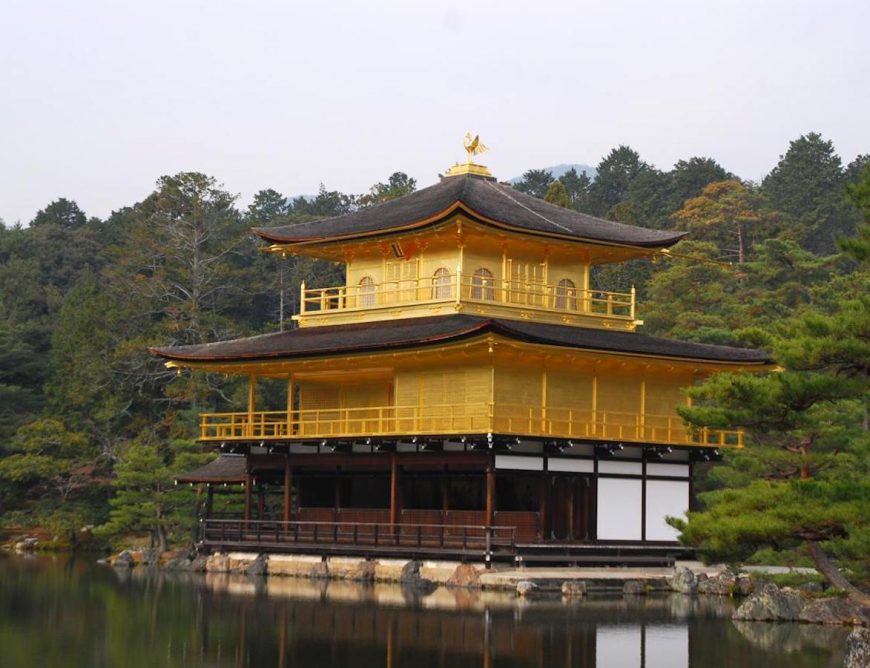
Two of the Ashikaga shōguns, Yoshimitsu (14th century) and Yoshimasa (15th century), are associated with the Kitayama and Higashiyama cultures, respectively—two sub-periods of cultural efflorescence that nurtured important developments in Japanese arts across mediums. Kitayama culture, so named after an area north of Kyoto where Ashikaga Yoshimitsu had a golden pavilion—Kinkakuji 金閣寺—built for his retirement, is known for the emergence of Noh and the increased influence of Zen Buddhism and Chinese ink painting.
Noh is a type of slow and ritualized dramatic performance with roots in Chinese dramatic arts and infused with Buddhist ideals.
Art coming from contemporaneous Ming-dynasty China as well older Chinese art—dating from the Song and Yuan dynasties, such as the works of Muqi (Mokkei 牧谿 in Japanese)—deeply influenced Japanese arts, especially the emerging local tradition of ink landscape painting.
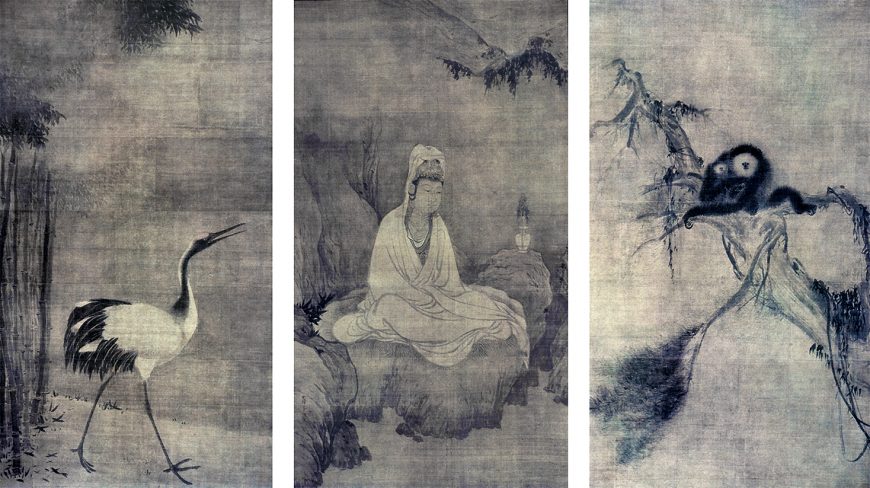
The most influential Japanese ink master, the 15th-century painter and Zen monk Sesshū Tōyō combined, in his works, Zen principles and lessons learned from Song-dynasty Chinese ink painting—most notably a double sense of austerity and immediacy, highly admired by the Ashikaga shōguns and the samurai class who embraced Zen Buddhism.
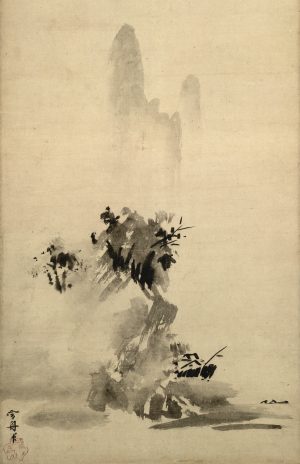
Sesshū was a celebrated artist in his own lifetime and continued to be revered as a model by later generations of painters. He became a Zen Buddhist monk at a young age and his master taught him both about Zen and about Chinese ink painting. To perfect his understanding of both, Sesshū traveled to China, where he was honored as a distinguished guest. It is believed that he painted in both palatial and monastic contexts. Upon his return to Japan, he laid the foundation for a new era of Japanese ink painting that straddled religious and lay patronage and combined Chinese and Japanese stylistic elements.
Over the centuries, painters emulated Sesshū’s style, especially his “splashed ink” or “broken ink” technique, and its roots in the literati tradition, some even affixing the painter’s seal to their works, all in an attempt to follow into the footsteps of a revered artist and to attract patrons. The Unkoku school strategically considered its painters to be in the direct lineage of Sesshū. The Hasegawa school similarly traced its stylistic genealogy to Sesshū. These two schools are just two of many examples of Japanese artists embracing a stylistic lineage, whether real or construed, leading back to Sesshū or another master. Legitimizing genealogies are a hallmark of Japanese art history.
In the "splashed ink" or "broken ink" technique, ink is spattered from a brush or directly from the hand to render texture and create a sense of volume.
The advancement of ink painting under the influence of Sesshū is part and parcel of the second Ashikaga-patronized sociocultural sub-period—the so-called Higashiyama culture, named after an area east of Kyoto, where the shōgun Ashikaga Yoshimasa had a silver pavilion—Ginkakuji 銀閣寺—built for his retirement.
The Higashiyama culture entailed programmatic patronage of the arts. During this period, the Kanō school of painting is established and its founder, Masanobu, is appointed official shogunal painter in the late 15th century. At this early stage, Kanō school painting is particularly indebted to Chinese ink painting and the Chinese bird-and-flower tradition. Masanobu’s son, Kanō Motonobu, widened the school’s painting repertoire by introducing color and indigenous motifs and thereby laid the foundation for an appealing synthesis of Chinese and Japanese elements.

The imperial court had its own favored line of painters, who worked in the yamato-e tradition and often specialized in pictures drawn from the Tale of Genji. (Both yamato-e and the Tale of Genji are described in the section on Heian-period art.) These painters are known as the Tosa school; the earliest mention of a painter named Tosa dates from the early 15th century and refers to a painter who was also the governor of the Tosa province. Contemporaneous with the beginnings of the Kanō school was Tosa Mitsunobu, who expanded his school’s repertoire much like Kanō Motonobu did for his school, except in opposite directions: while the Kanō artist added elements of traditional Japanese painting, the Tosa artist began to incorporate elements of Chinese painting. In this sense, the two schools created separate versions of a Chinese-Japanese stylistic synthesis, with the Tosa relying more heavily on the Japanese tradition and the Kanō, on the Chinese.
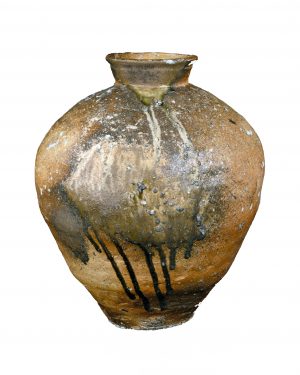
At the same time, the tea ceremony (chanoyū 茶の湯) emerged as a ritualized form of preparing and enjoying powdered green tea. For this ritual, domestic ash-glazed stoneware vessels, coiled by hand and fired in wood-burning kilns, began to be favored for their austere elegance or sense of sabi 寂—an important Japanese aesthetic concept that stands for seeking beauty in what is simple, solitary, and withered.
These different art forms and mediums—painting, ceramics, dramatic performances, collaborative poetry-writing parties, and tea rituals—converged in shogunal residences like the Golden and Silver Pavilions and especially in the decor of these residences, governed by the aesthetic principle of fūryū 風流—another enduring aesthetic notion in Japan, referring to a refined taste that favors rarified elegance and sensual beauty.
Azuchi-Momoyama period (1573-1615): palatial opulence, bold expression, and the beauty of the imperfect
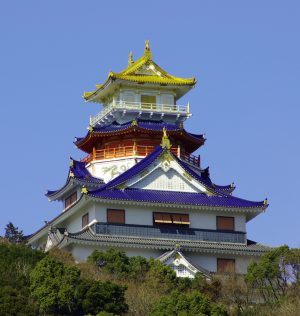
The Azuchi-Momoyama period gets its name from the opulent residences of two warlords who attempted to unify Japan at the end of the Sengoku (“warring states”) era, namely Oda Nobunaga’s Azuchi Castle and Toyotomi Hideyoshi’s Fushimi or Momoyama Castle. Both castles were not only martial structures for strategic warfare and defense, but also luxurious mansions meant to impress and intimidate political rivals. The architectural style of these residences derived from that of the pavilions built by Ashikaga shōguns during the previous historical period. Also, both castles’ locations were carefully selected for their optimal proximity to the capital—Nobunaga’s castle was built just outside of Kyoto on the shores of lake Biwa, while Hideyoshi’s was in Kyoto itself, in the southeastern ward of Fushimi.
That the two castles were built only 20 years apart reveals the rapid succession of consequential political events that defined the Momoyama period: Oda Nobunaga rose to power starting in 1560 and by 1582, when he was betrayed by his own retainers, he had managed to gain control of most of Japan’s main island of Honshū.
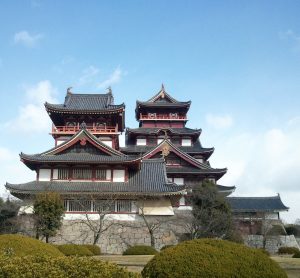
Nobunaga’s warrior, Toyotomi Hideyoshi, succeeded him and used his strategic thinking and negotiation skills to continue the efforts of unification, besides twice invading Korea (in 1592 and 1597). He was succeeded by another former retainer of Oda Nobunaga, Tokugawa Ieyasu, who managed to secure unprecedented power in 1600, winning the most important of Japanese feudal battles, that of Sekigahara.
Only three years later, Tokugawa Ieyasu was appointed shōgun by the emperor and spent the remainder of his years consolidating the Tokugawa shōgunate, which would become a 250-year rule of relative peace and prosperity. Only forty years had passed from Nobunaga’s ascension to power to Ieyasu’s appointment as shōgun, but these were years filled with momentous change.
Like other opulent residences of its time, the Azuchi castle comprised numerous buildings in the shoin 書院 architectural style, developed in the Momoyama period. This style entailed a main area flanked by aisles, wall-to-wall tatami-mat flooring, square pillars, and various types of sliding doors and walls that partitioned and reconfigured space. Shoin also featured an alcove in the reception room, known as tokonoma, and elements developed in the Muromachi period for shogunal residences such as staggered shelves and a built-in desk.
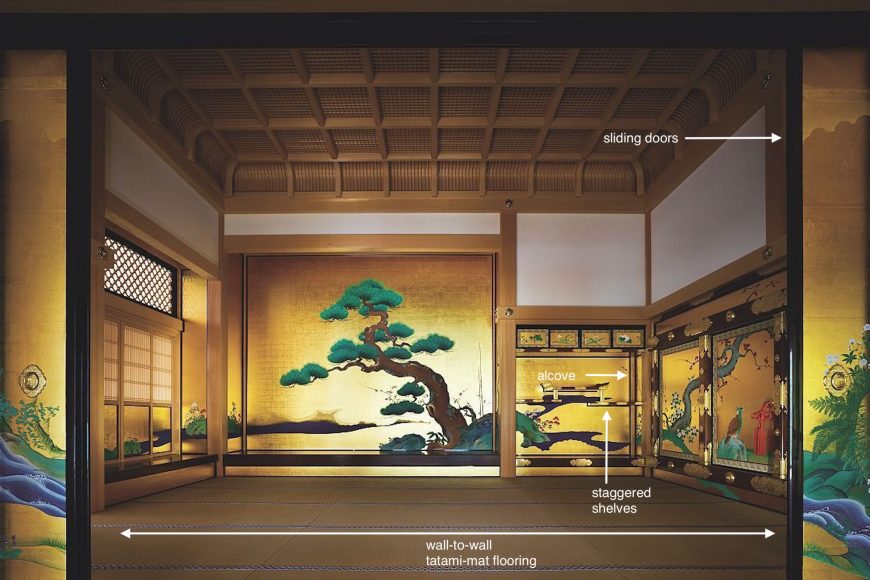
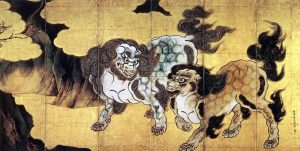
In addition to displaying the power of their owners, Nobunaga’s and Hideyoshi’s castles featured the bold and expressive art that characterized the Momoyama period, perhaps mirroring the energy and courage of the era’s military leaders.
Nobunaga’s Azuchi castle was adorned with the highly expressive paintings of Kanō Eitoku, the grandson of Motonobu, the Kanō painter who established the synthetic Chinese-Japanese aesthetic of the shōgun-patronized school. The very few surviving paintings of Eitoku exemplify this painter’s innovative approach to painting, characterized by dynamic compositions, bold and expressive brushwork, oversized animals, and imagery drawn from nature but set against an opulent golden background that would shimmer in the relatively dark interiors of the warlords’ residences. It can be said that Eitoku’s style matched the power that the painter’s patrons had and wished to put on display.
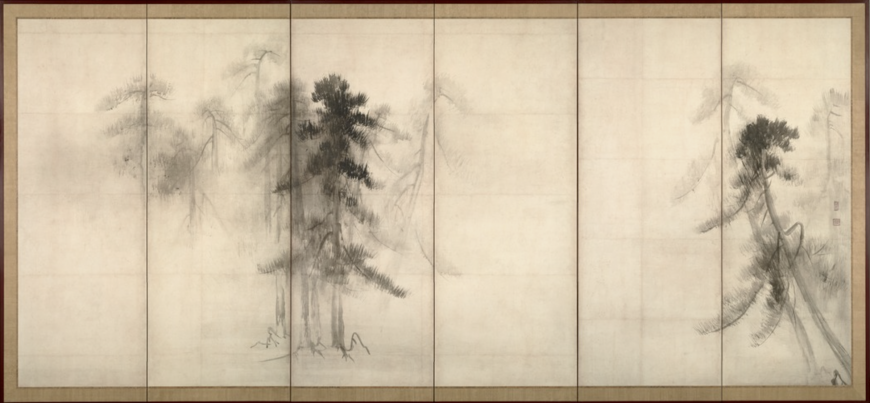
A rival of the Kanō school emerged in the person of Hasegawa Tōhaku, who may have studied both with Kanō painters and with a pupil of Muromachi-period ink master Sesshū. Tōhaku eventually claimed to be a descendant of Sesshū and developed a bold and highly expressive style, working typically in monochrome ink. His ties to influential tea masters and Zen teachers helped him secure important commissions. Another artist who received major commissions, alongside Kanō Eitoku and Hasegawa Tōhaku, was Kaihō Yūshō, whose military experience and Zen Buddhist training influenced his unique brand of highly charged compositions combining dramatic ink washes and unusually long brushstrokes.
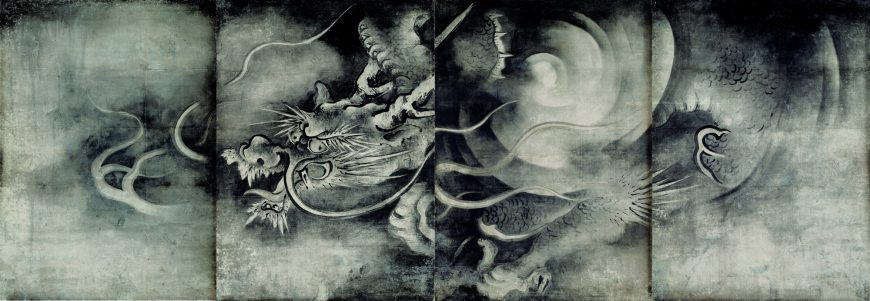
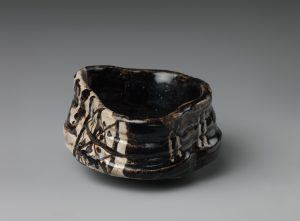
At the intersection of impressive palatial architecture and powerful ink paintings was another art form, nascent in the Muromachi period—the tea ceremony or chanoyu 茶の湯. In the second half of the 16th century, the tea master Sen no Rikyū revolutionized the practice of tea by modeling it on wabi, an aesthetic concept closely related to that of sabi. Wabi refers to finding beauty in simple, even humble things. Embracing the spirit of wabi and sabi, a disciple of Sen no Rikyū, Furuta Oribe, actively supported a new type of local ceramics that became so intertwined with Oribe’s style and efforts that they came to be known as Oribe ware. These new ceramics were radically different in a number of ways. First, they were locally produced and became popular enough to compete with Chinese ceramics in the aesthetic hierarchies of tea masters. Second, they are characterized by a distinctive practice of intentionally distorting the shapes of the vessels in response to the wabi aesthetic that valued the imperfect.
Chanoyu refers to the rituals surrounding the preparation and enjoyment of powdered green tea or matcha.
Sabi is an important Japanese aesthetic concept that stands for seeking beauty in what is simple, solitary, and withered.
The Momoyama period is also remembered for intensified contact with other cultures. Portuguese, Spanish, and Dutch ships landed in the Southern island of Kyushu and brought to Japan previously unknown markets, objects, and concepts; firearms, for example, were introduced by the Portuguese as early as 1543. International trade and the spread of Christianity were regarded with suspicion and therefore short-lived, culminating in the self-isolation policy instituted by the Tokugawa. However, trade continued with the Chinese and the Dutch, and a small number of Christians continued to practice in secret.
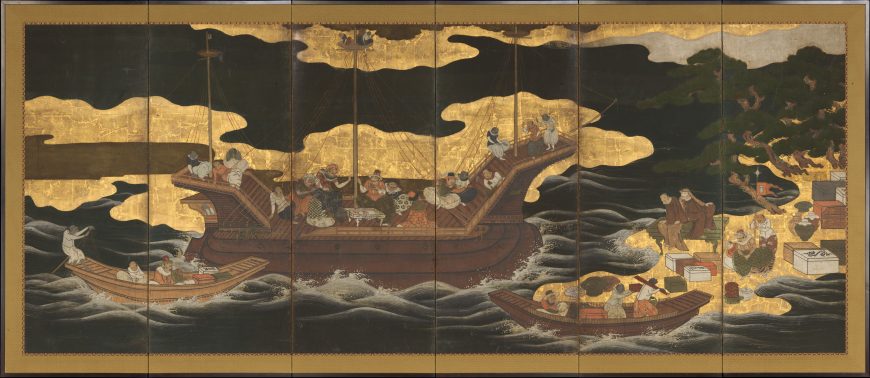
Despite its brevity and limitations, the late 16th-century encounter with Europeans had a lasting influence. In the port of Nagasaki, Japanese artists were able to observe the foreign visitors’ dress, manners, and habits, and a new painting genre emerged, the so-called nanban (literally, “Southern barbarians,” the name given in Japan to the Europeans who arrived from India via a Southern sea route). Nanban paintings depict not only European priests and traders, but also Goanese sailors, who traveled with the merchants and missionaries, and even Caucasian women, although there were no women among those who landed in Japan at the time. Nanban screens became very popular and many copies were made, increasingly more removed from first-hand observations and reliant upon the painters’ imagination.
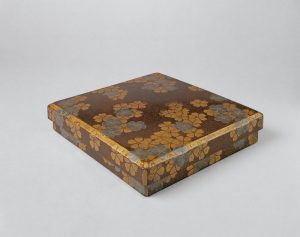
Nanban imagery was not confined to painted folding screens; we encounter nanban motifs in other mediums such as ceramics and lacquerware. The inside of the writing box shown here presents images of Portuguese and Indian or African figures, while the outside is decorated with traditional Japanese motifs of fallen cherry blossoms. Objects such as this writing box exemplify not only the integration of nanban imagery in Japanese visual culture, but also an important Japanese aesthetic principle, that of kazari. Translated as both “ornament” and “the act of decoration,” kazari is also a mode of display—and so much more than that. Above all, kazari is an organizing principle of aesthetic and social dimensions that seeks visually and conceptually stimulating juxtapositions that transform the appearance of both objects and spaces, activating the viewer’s own creativity and imagination.
Additional resources:
JAANUS, an online dictionary of terms of Japanese arts and architecture
e-Museum, database of artifacts designated in Japan as national treasures and important cultural properties
On Japan in the Metropolitan Museum of Art’s Heilbrunn Timeline of Art History
Richard Bowring, Peter Kornicki, The Cambridge Encyclopedia of Japan (New York: Cambridge University Press, 1993)
A brief history of the arts of Japan: the Edo period
Edo period: artisans, merchants, and a flourishing urban culture
Tokugawa Ieyasu’s victory and territorial unification paved the way to a powerful new government. The Tokugawa shogunate would rule for over 250 years—a period of relative peace and increased prosperity. A vibrant urban culture developed in the city of Edo (today’s Tokyo) as well as in Kyoto and elsewhere. Artisans and merchants became important producers and consumers of new forms of visual and material culture. Often referred to as Japan’s “early modern” era, the long-lived Edo period is divided in multiple sub-periods, the first of which are the Kan’ei and Genroku eras, spanning the period from the 1620s to the early 1700s.

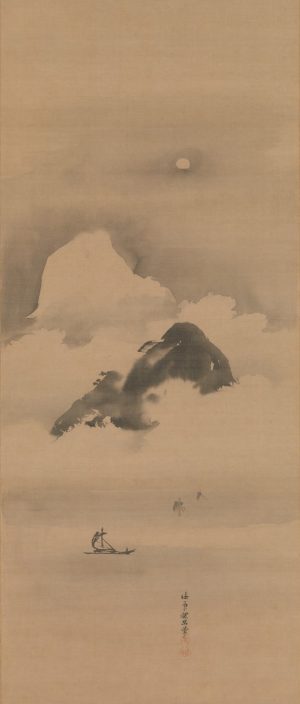
During the Kan’ei era, the Kanō school of painting, founded in the Muromachi period, flourished under the leadership of three of its most characteristic painters: Kanō Tan’yū, Kanō Sanraku, and Kanō Sansetsu. Their styles both emulated and departed from the formidable painting of Kanō Eitoku (discussed in the Momoyama-period section). Tan’yū was Eitoku’s grandson, Sanraku was his adopted son, and Sansetsu was Sanraku’s son-in-law (whom Sanraku eventually adopted as heir).
Their respective styles shared a creative tension between two diverging artistic directions: on the one hand, they were deeply influenced by the boldly expressive and monumental painting style of Eitoku; on the other hand, they adopted a less dramatic and subtly elegant manner, including a return to Chinese models and the earlier style of the Kanō school.
Tan’yū, in particular, spearheaded this conservative turn. His move to Edo as the painter of the Tokugawa shōgun marked a break with the Kyoto-based Kanō painters (including Sanraku and Sansetsu), one that was reflected in contemporaneous treatises that opined on issues of hierarchy and legitimacy within the school.
A versatile artist steeped in the Chinese tradition, Tan’yū was a connoisseur and collector of Chinese paintings. Drawing on his erudite visual vocabulary, Tan’yū painted both poetic landscapes in monochrome ink, typically evocative of classical subjects, and polychrome paintings in the Japanese style, accommodating large-scale commissions for palatial settings. In appreciation of his work, he was awarded, at age 61, the honorific title Hōin (“Seal of the Buddhist Law”).
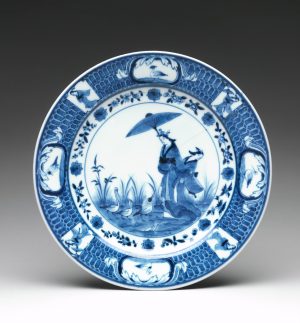
The Kan’ei and Genroku eras witnessed major developments in another medium, namely porcelain. The pioneers of Japanese porcelain were Korean potters brought to Japan after Toyotomi Hideyoshi’s incursions into Korea during the Momoyama period. These potters settled in Kyushu and paved the way for one of the world’s most innovative and prolific porcelain centers. Arita, Imari, Kakiemon are now household names, in part because of the 17th-century export of such wares from Northern Kyushu via the Dutch East India Company. This international trade company had contributed significantly to the global appeal of Chinese porcelain, particularly the blue-and-white variety. Despite the Tokugawa’s policy of self-isolation, the exception of allowing some Chinese and Dutch agents to continue international trade, combined with the political turmoil in China caused by the downfall of the Ming dynasty, created the optimal context for the Dutch to replace Chinese blue-and-white porcelain with Japanese porcelain in global trade. Japanese export ware, often referred to as Imari ware, emulated Chinese blue-and-white porcelain and reflected the Western tastes to which it catered.

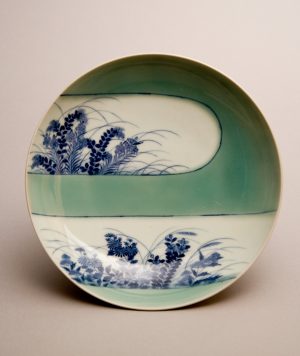
Among the different porcelain kilns of northern Kyushu, Nabeshima ware was not for export but produced exclusively for the domestic market. The lord of Nabeshima, who had brought the Korean potters to his domain, embraced the local production that developed in the 17th century and patronized a special kiln whose porcelain he offered as strategic gifts to the shogun and other feudal lords. With its production processes kept secret, Nabeshima porcelain is distinguishable by its exquisite surfaces, adorned with delicate motifs drawn not from Chinese or European sources, but from the traditional Japanese visual repertory.
With its smooth surfaces and well-defined shapes, porcelain was markedly different from the stoneware produced in other ceramic centers of Japan, like the Oribe ware for tea rituals (described in the section on the Momoyama period). During the Edo period, the tea ceremony—both chanoyu and sencha, a different type of ritual for the preparation and enjoyment of steeped leaf tea—continued to flourish. Sencha, in particular, was integral to the literati culture. Japanese literati or bunjin modeled themselves on Chinese scholar-philosophers who were well-versed in painting, calligraphy, and writing poetry. As scholars with artistic pursuits, bunjin were not professional painters, but used painting—especially spontaneous renderings of landscapes, poems, and Chinese and Japanese traditional motifs in ink wash—as ways of expressing the inner energy of cultivated spirits that sought to achieve excellence by removing themselves from society and even defying societal norms. This model of reclusion was particularly embraced in periods of political unrest, which was definitely the case in Japan at the end of the 16th century during the turmoil that characterized Momoyama, the 40-year span that led to the Edo period. Gradually, literati practices developed a core tension between the rebellious and the highly individualistic, on the one hand, and the ritualistic and the normative, on the other, as traditions and lineages began to became more rigid over time.
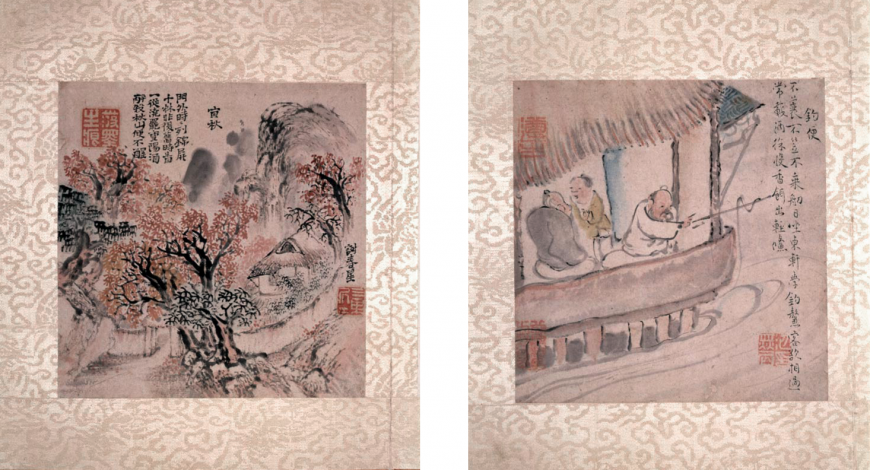
Bunjinga, literally translatable as “literati painting,” refers to painting practiced by these learned men. Literati painting often brought together references to both classical Chinese themes and local and contemporaneous literary sources, especially poems, often written by the painters themselves. The 18th-century haikai-no-renga poet Yosa Buson was also an accomplished painter and, in the collaborative spirit of haikai-no-renga, co-authored, with Ike no Taiga, a pair of albums on the Chinese theme of the “ten conveniences” and “ten pleasures” of life, combining idealized depictions of nature (mostly by Buson) with anecdotal renditions of human activities (mostly by Taiga). The collaboration between Buson and Taiga was both collegial and competitive, calling to mind the centuries-old Japanese tradition of poetry and picture contests that showcased talent and skill.
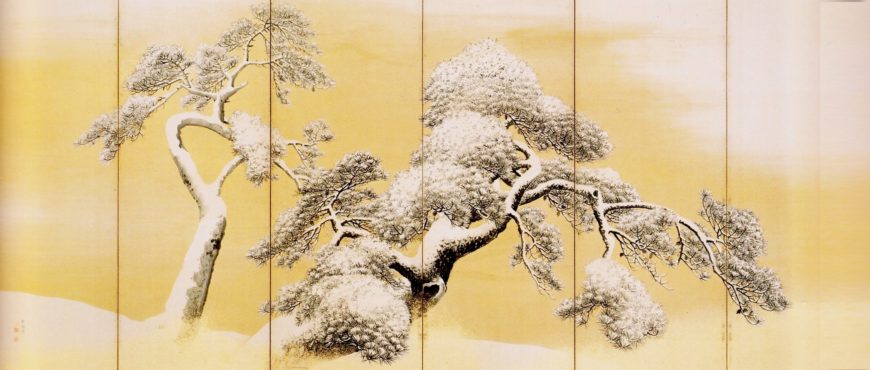
A foil to Buson’s and Taiga’s approach to painting was the renewed search for realism of painter Maruyama Okyo. His naturalistic rendition of birds and animals, human figures, and landscapes contrasted with the literati mode by focusing on a rational regimen of visual representation, grounded in observation of the natural world. Trained in the European techniques of shading and one-point perspective, Okyo nonetheless created a synthesis of western-inspired naturalism and traditional Japanese techniques, styles, and subject matter. Okyo’s mode of painting was transmitted via the Maruyama-Shijō school, that Okyo first established as the Maruyama school. It was continued by Matsumura Goshun (whose studio was on the Shijō street in Kyoto), a painter who first studied with Buson and then turned to Okyo. These two closely related schools have been referred to as one entity since the late Edo period, when the distinctions between the two had faded. One of the most notable painters in the lineage of Goshun was Shibata Zeshin, a disciple of one of Goshun’s students, and an innovative painter and lacquer artist.
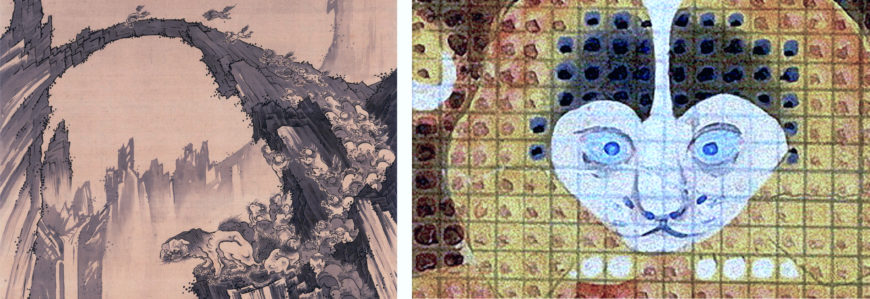
Painters working outside established schools like the Tosa and the Kanō diverged from established modes of painting to varying degrees. Those whose styles were particularly unconventional have been recently re-evaluated as forming a “lineage of eccentrics” by Japanese art historian Tsuji Nobuo. Included in this “lineage” are Iwasa Matabei, Kano Sansetsu, Ito Jakuchu, Soga Shohaku, Nagasawa Rosetsu and Utagawa Kuniyoshi—each of whom had individual trajectories in their respective processes of maturing as visual artists. What they shared was a highly personal approach to painting, often characterized by unusual techniques and atypical subject matter. In Lions at the Stone Bridge at Mt. Tiantai, Soga Shōhaku chose a rarely depicted Buddhist theme and imagined it in novel ways, adding a whimsical dimension to it. In Birds, Animals, and Flowering Plants in Imaginary Scene, Itō Jakuchū painstakingly painted no fewer than 43,000 colored squares to create a fantastical, mosaic-like composition.
During the Edo period, a bustling urban culture developed. Merchants, craftsmen, and entertainers helped shape cultural and artistic tastes through their products and programs. Collaborative linked-verse parties and new forms of entertainment like kabuki theater became staples of the urban lifestyle. Tourism, too, gained in popularity as travelers went on pilgrimages to shrines, temples, and famous sites (meisho 名所), often associated with classical poems and traditional tales. All these cultural practices were mirrored in the popular paintings and prints known collectively as ukiyo-e 浮世絵. Literally “pictures of the floating world,” ukiyo-e can be best defined as genre painting for and about “common people” (shōmin 庶民)—members of the middle class of Edo-period Japanese society.
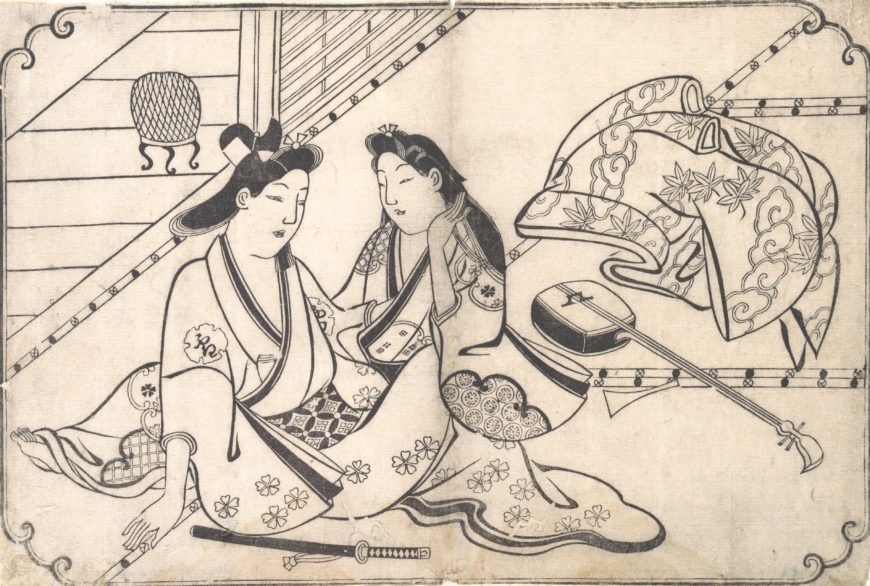
Trained in his family’s textile business, 17th-century painter Hishikawa Moronobu was the earliest of the ukiyo-e masters. He focused on images of beautiful women (bijin 美人) and worked both in painting and woodblock printing. His depiction of women and lovers in Edo’s pleasure quarters deeply influenced subsequent ukiyo-e painters and print designers, notably Miyagawa Chōshun. Initially educated in the Tosa school, Chōshun signed his works by adding “yamato-e” to his name—a practice indicating that in its early days, ukiyo-e was regarded as a successor to the yamato-e style.

Contemporaneous with the ukiyo-e master Hishikawa Moronobu was the painter Iwasa Matabei, who, like Moronobu and his followers, saw himself as an heir to the yamato-e and Tosa-school traditions. Given his anecdotal painting style and his allegiance to Japanese subjects and painting techniques, Matabei is often regarded as a founding figure of ukiyo-e along with Moronobu. Matabei drew inspiration for his paintings from the classics of Japanese literature such as the Tale of Genji. However, in the spirit of ukiyo-e, his paintings are infused with a sense of everyday life and personal experience. The highly personal dimension of his art made others think of Matabei as one of the “eccentrics” (used here in the sense previously explained in relation to Shōhaku and Jakuchū, and aligned with the definition of art historian Tsuji Nobuo). Whether Tosa, ukiyo-e, or eccentric, Matabei broke with tradition by focusing on contemporaneous experiences and aspects of everyday life. Often, these themes were playfully intertwined with classical subject matter, resulting in a visual simile, which was at times parody, known as mitate. Realities of the present were superimposed over classical or mythic themes of the past. This practice ranges in Edo-period painting from an emphasis on the mundane and the anecdotal, as seen in Matabei’s compositions, to playful depictions of contemporaneous figures (such as beautiful women and kabuki actors) in the guise of legendary or historical figures such as poets and warriors, as seen later in the works of 18th- and 19th-century ukiyo-e artists like Andō (Utagawa) Hiroshige and Utagawa Kunisada.
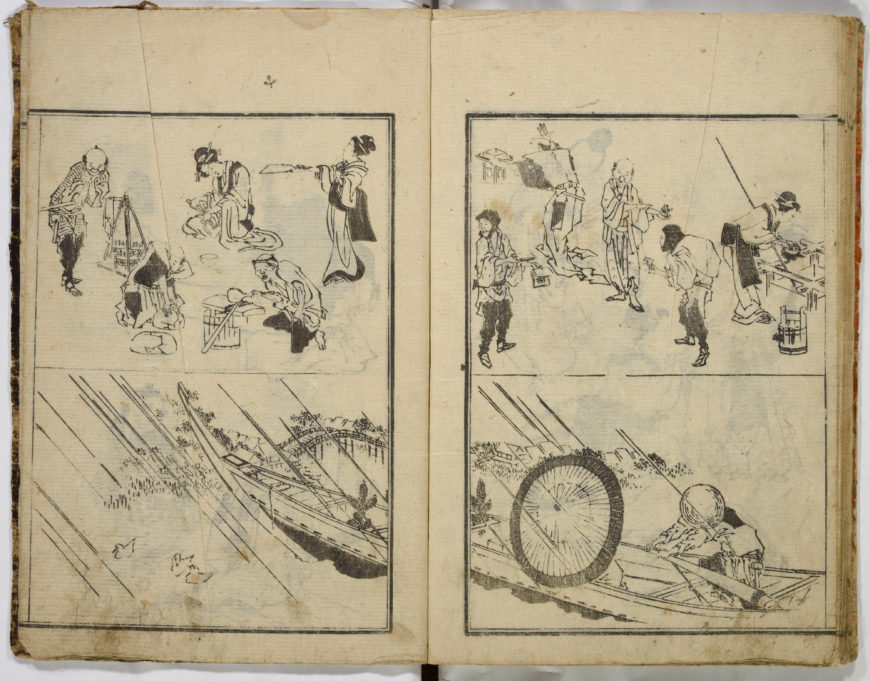
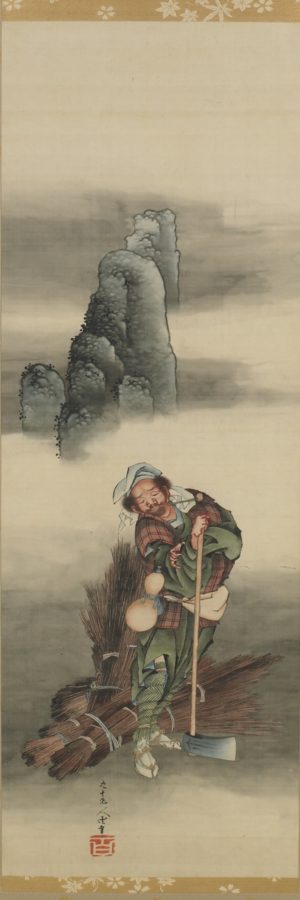
Ukiyo-e images were made available in a variety of formats, from paintings and surimono to picture books (ehon 画本) and loose woodblock prints, often conceived in series (e.g. thirty-six views of Mount Fuji, seven episodes in the life of 9th-century poetess Ono no Komachi). One of the best known ukiyo-e masters and an emblem for Japanese art in the western world, Katsushika Hokusai (1760-1849) not only designed woodblock print series and picture books, but also authored numerous paintings. Leading a frugal life and living in unkempt abodes, Hokusai was remarkably prolific over his long life, adopting various monikers and carefully dating his works by indicating how old he was when he painted them. Hokusai is deservedly famous for his exceptional draughtsmanship and exuberant imagination, coupled with a fine understanding of Japanese life and culture, both classical and contemporaneous. Like other Edo-period painters, he often inserted himself in his own work via quasi-self-portraits and reflections on impermanence and old age.
The Edo period saw an intensified circulation of visual vocabulary and aesthetic principles between mediums (paintings, ceramics, lacquerware, and textiles often shared the similar motifs) and crossing different registers of culture from design to popular culture to nostalgia for a romanticized pre-modern past. These intersections were further enabled by collaborations between artists of different specializations. One of the most consequential of these collaborations was that between the Kyoto-based, 17th-century painter Tawaraya Sōtatsu and calligrapher and ceramist Hon’ami Kōetsu.
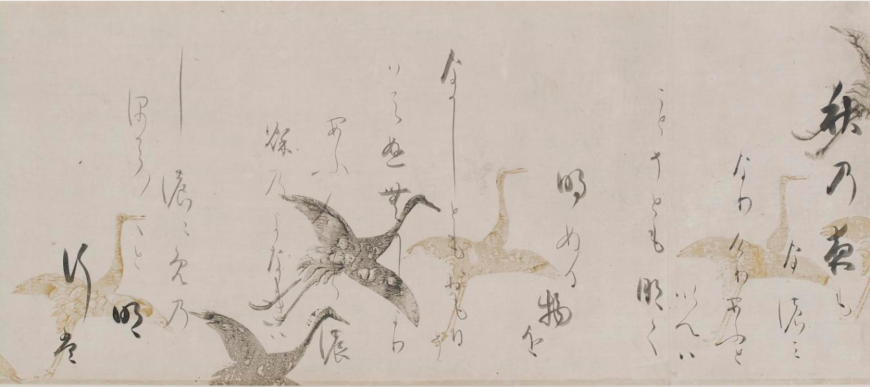
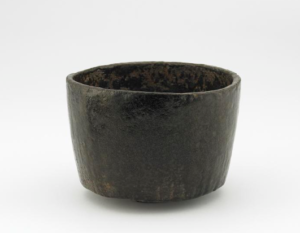
Their combined practice entailed an elegant aesthetic emphasizing traditional cultural references shared across painting, poetry, calligraphy, lacquer, ceramics, and tea ritual.
Along with potter Nonomura Ninsei, Kōetsu was among the first to sign their pottery in Japan. He would shape his tea bowls, then send them to the Raku-ware workshop to have the bowls glazed and fired. Kōetsu worked across multiple media and his collaborations with painters and potters contributed to a more unified visual culture. As is the case with Japanese art across the ages, lineages played a vital role in the survival and transformation of Sōtatsu’s and Kōetsu’s aesthetic programs.
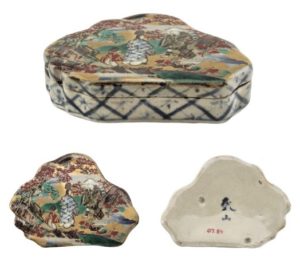
The intertwined styles of these two 17th-century artists were emulated and consolidated by the early-18th-century artists Ogata Kōrin and his brother Ogata Kenzan, who became school leaders in their own right. A familial relationship doubled this stylistic genealogy: Kōrin and Kenzan’s great-grandmother was an elder sister of Kōetsu. And the two brothers collaborated on occasion. Kōrin specialized in painting, while Kenzan became one of the most influential names in Kyoto-area ceramics. Later generations of potters emulated and even copied Kenzan’s style, while Kōrin gave his name to a new school, Rinpa (“Rin 琳” from “Kōrin 光琳” + “pa/ ha 派”, meaning “school”), that traced its aesthetic origins to Kōrin’s and Kenzan’s models, namely Sōtatsu and Kōetsu. Rinpa artists’ refined and ingenious designs were based on traditional themes and motifs, and rendered in gold, silver, and bold colors. They worked across mediums and genres ranging from painting to lacquer and from episodes in the Tale of Genji to depictions of the four seasons.

Additional resources
JAANUS, an online dictionary of terms of Japanese arts and architecture
e-Museum, database of artifacts designated in Japan as national treasures and important cultural properties
On Japan in the Metropolitan Museum of Art’s Heilbrunn Timeline of Art History
Nobuo Tsuji, translated by Nicole Coolidge Rousmaniere, History of Art in Japan (Tokyo: University of Tokyo Press, 2019)
Richard Bowring, Peter Kornicki, The Cambridge Encyclopedia of Japan (New York: Cambridge University Press, 1993)
A brief history of the arts of Japan: the Meiji to Reiwa periodsFrom the Meiji restoration (1868) to the first year of Reiwa (2019): modern and contemporary art, part I
Meiji period (1868-1912)
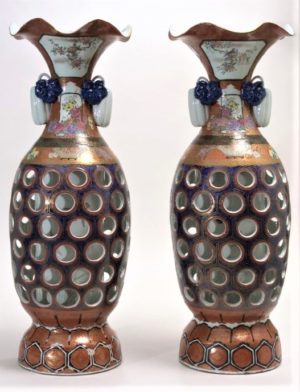
1868 was a watershed year for Japan. After over two centuries of shogunal rule, practical political power was restored to the emperor (Meiji). 15 years earlier, the American commodore Matthew Perry led a military and diplomatic expedition to Japan, opening the country to foreign trade and thereby ending the Tokugawa-imposed self-isolation policy. The effects of this forcible “opening” were manifold and deeply affected Japan’s social and cultural fabric. Japan began to participate in World’s Fairs, curating displays of samples of Japanese cultural tradition designed for the outside world to see, and often taking the form of new porcelain vases that impressed through their monumental scale, technical excellence, and intricate decoration.
In the realm of painting, the 1870s saw a new mode of image-making that embraced western styles and techniques, known in Japanese as yōga 洋画 (“Western-style painting.”) A pioneering yōga artist, Takahashi Yuichi assisted Antonio Fontanesi, the “foreign advisor” appointed by the Meiji government to teach oil painting at the newly established Technical Fine Arts School in Tokyo. Further developed by painters like Kuroda Seiki, who studied extensively in Paris and worked in Japan into the 1920s, yōga largely embraced contemporaneous styles of French painting, from the Barbizon School to Impressionism, and their connected practices, from painting from nature to favoring subject matter drawn from the here and now.
The Barbizon School comprised French artists who moved toward realism in the landscapes they painted in the environs of the Fontainebleau forest outside Paris, beginning in the 1830s, deeply influenced by English painter John Constable.
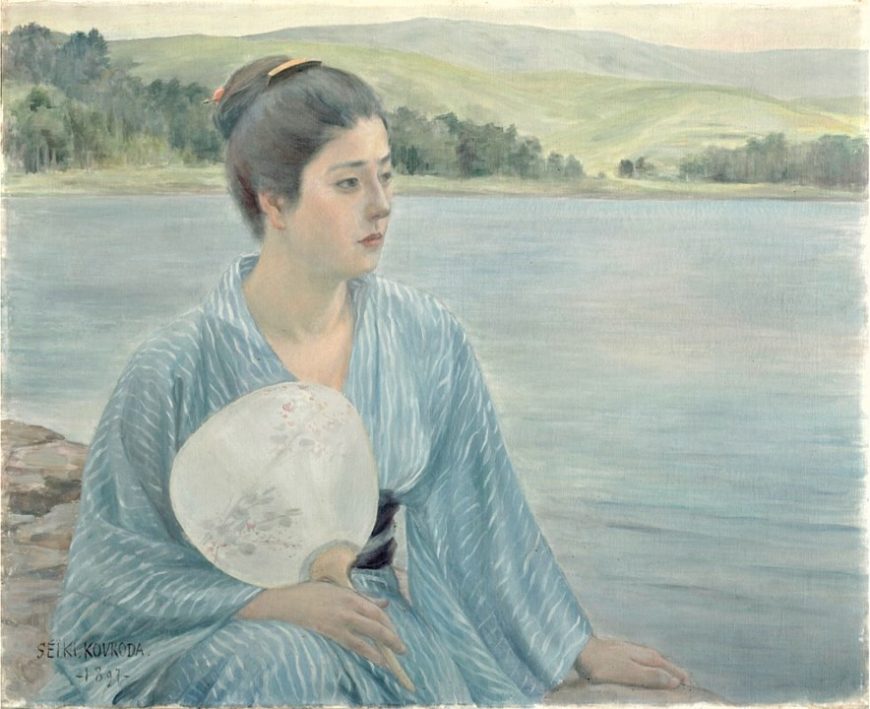
As a foil to yōga, other Japanese visual artists developed a parallel mode of painting, known as nihonga 日本画 (literally, “Japanese painting.”) Rejecting a straightforward adoption of techniques and styles from Euro-American pictorial traditions, nihonga was not a direct continuation of the earlier yamato-e either. Instead, nihonga broadened the traditional themes of yamato-e, created new blends of Japanese stylistic traditions like Kanō and Rinpa, and even incorporated western modes of pictorial realism in its reinvention of Japanese painting.
Born in the Heian period, yamato-e is a painting style understood as “Japanese” as opposed to “Chinese” or otherwise “foreign.” It refers to specific formats, i.e. folding screens and room partitions, and specific themes, i.e. landscapes with recognizably Japanese features and illustrations of Japanese poetry, history, and mythology.
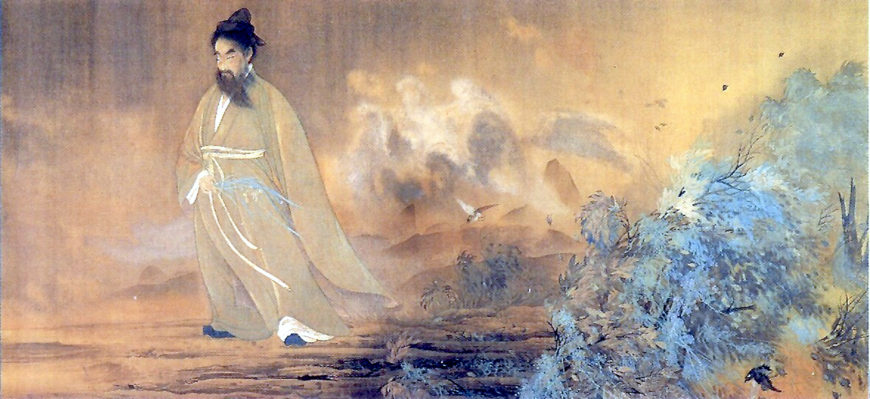
Two artists who significantly shaped nihonga were Kanō Hōgai and Yokoyama Taikan. Remembered as the last great master of the Kanō school, Kanō Hōgai helped pioneer nihonga alongside fellow painter Hashimoto Gahō, himself trained in the Kanō style, and Ernest Fenollosa, an American poet and art critic who assumed important cultural positions in Meiji-period Japan, as professor of philosophy and curator at the newly established Tokyo Imperial University and Imperial Museum, respectively. Modeled on European and American universities and museums, such institutions altered the old structures of the Japanese cultural field. New words became necessary in the Japanese language to translate and use foreign concepts such as “fine art” or “artist.” Thinkers like Fenollosa or Okakura Kakuzō—a sort of cultural ambassador who explained, through his subjective lens, Japanese culture to elite American audiences—affected both the production and the reception of what constituted “Japanese art” in the Meiji period. Born out of Okakura’s teachings on traditional Japanese culture was the quintessentially nihonga style of painter Yokoyama Taikan. His paintings combine canonically Japanese and western-inspired elements with unconventional techniques and high symbolic content.

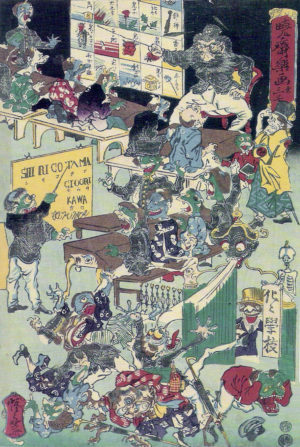
Yet other modes of painting co-existed with the strong yōga and nihonga trends. Somewhat aligned with Euro-American post-Impressionism, the artist Tomioka Tessai created his individualistic style through an inventive blend of influences, largely drawn from classical Japanese and Chinese sources. Tessai’s mentor, friend, and frequent collaborator was Otagaki Rengetsu, an artist and Buddhist nun who expressed her unique style via pottery, poetry, painting, and calligraphy. Another idiosyncratic artist of the period was Kawanabe Kyōsai, who “translated” his experience of the drastic changes that Japan underwent in the 19th century into caricatures within an exuberantly inventive pictorial realm. Through such artists, the Meiji period furthered the spirit of centuries of poetic and playful interplay among mediums and styles in Japanese arts.
Spurred by new ideas about the nation-state and by the reconfiguration of society in the modern era, Japanese urban life was transformed in the Meiji period. With this transformation came different modes of living and new architectural styles for buildings that housed newly established public institutions and for family homes, influenced by western-centric concepts of domesticity. Modeled on western architecture, buildings were built with brick and stone instead of the traditional wood. Merging international and indigenous elements, an eclectic architectural style emerged, championed by architects like Itō Chūta, who also helped establish cultural preservation laws for ancient structures such as temples and shrines.
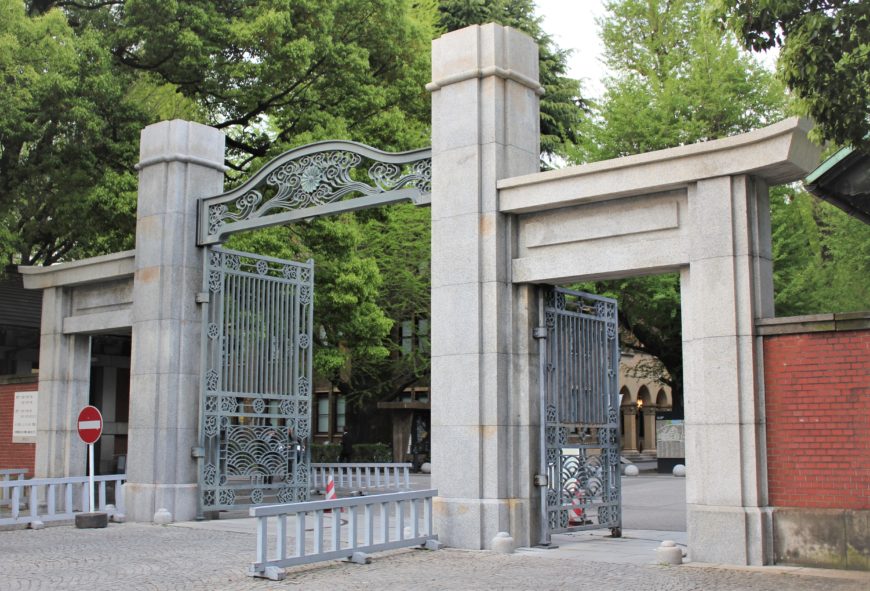
Taishō period (1912-1926)
The Taishō period continued the process of adoption and transformation of foreign models. During this period Japan participated in World War I and continued its colonial rule of Korea and Taiwan, occupations dating from the Meiji period. In the cultural field, the eclectic style that had emerged in architecture continued to flourish, with structures emulating modernist trends like Bauhaus and Art Deco. The Great Kantō earthquake of 1923, a natural disaster of catastrophic proportions, not only destroyed buildings and other cultural properties, but marked a shift in Japanese society from the optimism of the Taishō period to the radicalized nationalism of subsequent decades.
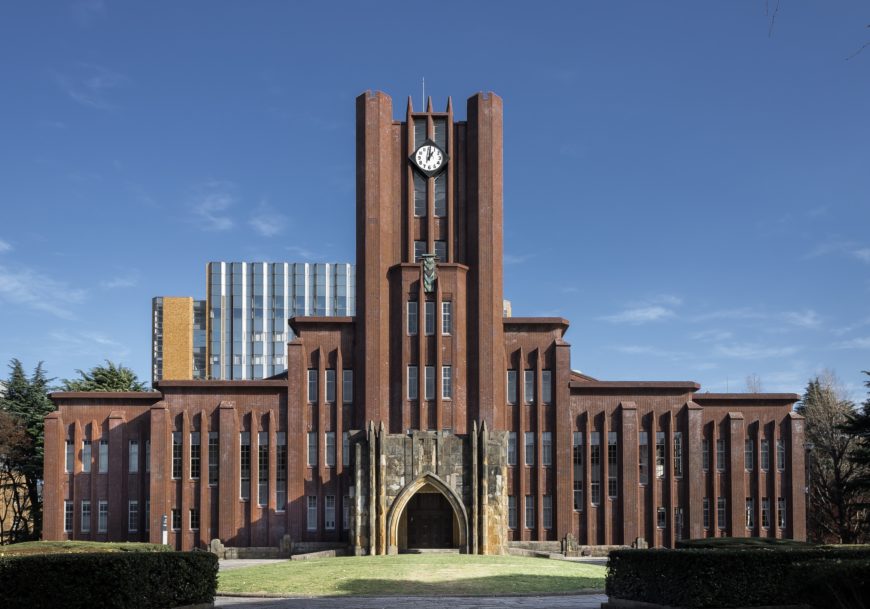
The Yasuda auditorium, built in 1925 on the campus of the University of Tokyo, epitomizes the brief but consequential Taishō period. Designed in an Art Deco mode and reminiscent of the campus of the University of Cambridge, the Yasuda auditorium was sponsored by one of the founders of the Yasuda zaibatsu. It was intended as a temporary resting facility for the emperor when he visited the university. As such, the auditorium embodied the socio-cultural influence of the new financial magnates, the rising nationalism concentrated in the persona of the emperor, the adoption of the European Art-Deco architectural style, and the affirmation of the university as a modern research center.
Zaibatsu refers to Japanese industrial and financial conglomerates whose economic and socio-political influence dominated Japan from the Meiji period to the end of World War II.
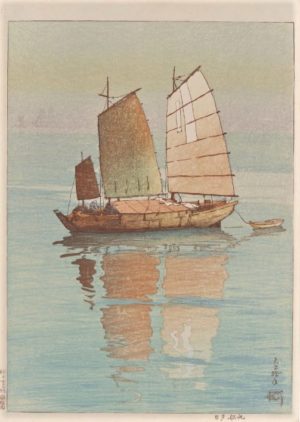
Nihonga, or (modern) Japanese painting, continued to develop at the intersection of Japanese tradition, western techniques, and individual styles. The Nihonga painter Yokoyama Taikan resurrected the Nihon Bijutsuin (Japan Art Institute) after it had lapsed following the death of its leader, the controversial but influential thinker Okakura Kakuzō. Such developments ensured a continuation of Meiji-period discourses on the arts, entailing the adoption of western notions and terms and the formulation and crystallization of new concepts, all reflected in newly coined Japanese-language words.
An equivalent to Nihonga was the shin hanga phenomenon, namely the formation of new modes and styles of printmaking that simultaneously revitalized ukiyo-e (as defined in the section on Edo-period arts) and incorporated elements of modern design and western-inspired realism. While shin hanga largely preserved the multiple hands traditionally involved in the design and production of ukiyo-e woodblock prints, another mode of Japanese printmaking that emerged in the 1910s, known as sōsaku hanga, emphasized individual expression and featured a sole creator in charge of all aspects of the print’s production (from drawing to carving to printing). Sōsaku hanga resonated, and drew upon, contemporaneous thinkers and writers like Natsume Sōseki who advocated self-expression.
From the Meiji restoration (1868) to the first year of Reiwa (2019): modern and contemporary art, part II
Shōwa period (1926-1989)
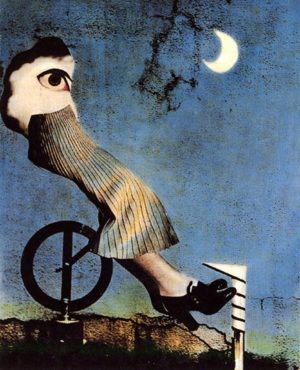
The years leading to Japan’s involvement in World War II saw the rise of militarism, ultra-nationalism, and increasing imperialistic ambitions, fueled in part by Japan’s emulation of western colonialism. In the 1920s and 30s, Japanese poets, photographers, and painters who had studied abroad developed, in Japan, styles aligned with contemporaneous global art movements, combining elements of surrealism, absurdist Dada, and futurism. For example, the paintings of Fukuzawa Ichirō combined surrealist imagery with political commentary; Hirai Terushichi made use of color painting and photomontage to create photographic prints that blurred the boundary between reality and imagination.
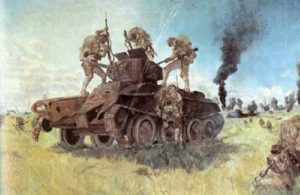
Such artists were silenced in 1941 by the Japanese “thought police” that aimed to control any and all ideologies that seemed to pose a threat to the ideals and agenda of the Nazi-allied Empire of Japan. War-time painting depicting military men and battles came to be heavily criticized after the war for their political charge, but recent scholarship by Ikeda Asato suggests that seemingly apolitical paintings of the pre-war period, which romanticized subjects of “authentic” Japanese culture such as Mount Fuji or bijin (“beautiful women”), can also be understood as having supported the militaristic state ideology of the time.
Postwar Japan was a period of unprecedented change. From the end of the war in 1945 to 1952, Japan was occupied by the victorious Allied forces, led by American General Douglas MacArthur. From 1952 to the death of the Shōwa emperor (Hirohito) in 1989, Japan witnessed a successful U.S.-influenced economic redevelopment. In the cultural sphere, as early as 1954, the newly established Gutai art association promoted “concrete” or “embodied” artistic expressions, pushing abstraction to its limits and foreshadowing the performance and conceptual art of the 1960s and 70s.
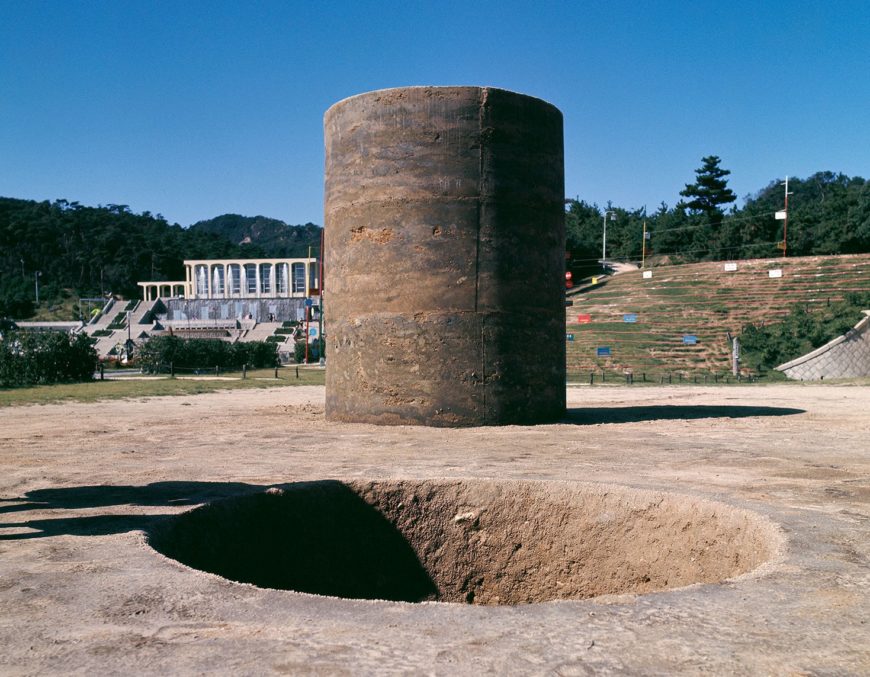
In those later decades, the exploration of materiality continued to preoccupy artists of the so-called mono-ha (literally “school of things”), including the Korean Lee Ufan. Mono-ha artists created works that tested the tension between natural and manmade materials and between their chosen materials and the environment in which they were placed. Mono-ha artists may have been influenced by the sociopolitical climate of distrust, protest, and counterculture that dominated the 60s and 70s. Referring to one of his most influential works, Phase: Mother Earth, consisting of a deep and wide hole in the ground and an equally sized cylinder of the excavated earth, the Mono-ha artist Sekine Nobuo affirmed:
“If you dig a hole in the earth and keep digging forever, (…) and if you go on to pull out all the earth, [the Earth] will be reversed into a negative version of itself.”Sekine Nobuo cited in Reconsidering Mono-ha, The National Museum of Art, Osaka, 2005, p. 74
The Great Kantō earthquake of 1923 and the ravages of war created successive scenes of destruction and contributed to a collective memory of ruins, used as evocative subject matter by Japanese painters and photographers to this day.
In the postwar period, reconstruction was not only political and economic, but also literal, in the urban and architectural sense. Modernism was adopted as the language of this reconstruction. The architect Tange Kenzo, who worked for Maekawa Kunio, one of Le Corbusier’s disciples, became one of the most consequential postwar modernists both as an architect and as an urban planner.
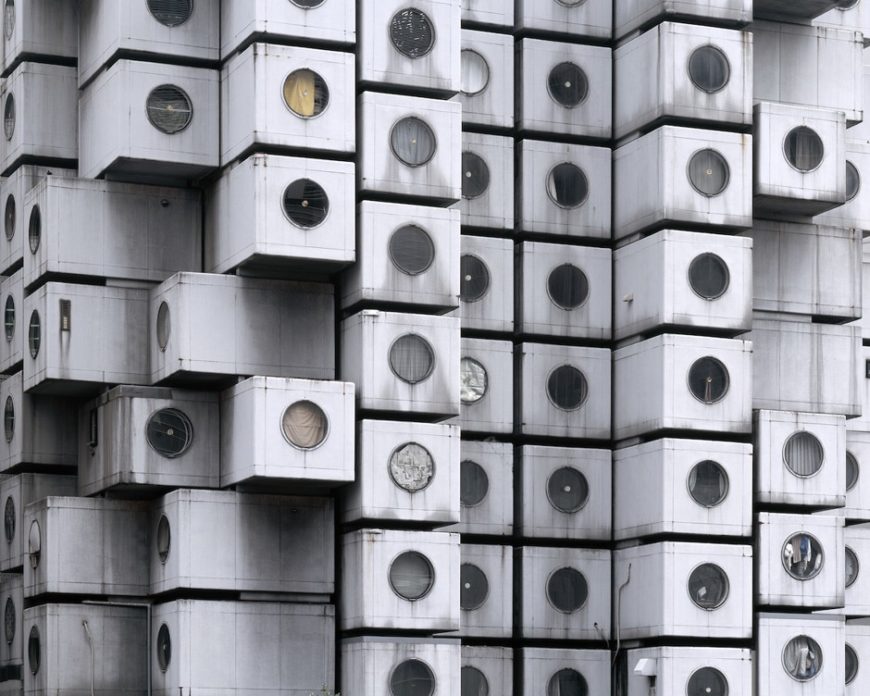
Tange’s unrealized “Plan for Tokyo 1960” heavily influenced the Metabolist movement, which Tange himself supported. Emblematic of Metabolism is the Nakagin Capsule Tower in Shinbashi, Tokyo, whose capsule-like rooms are prefabricated units meant to be replaced once they wore out. The “capsules” were designed as integral to a megastructure of both permanent and impermanent parts, built in the spirit of organic growth.
Metabolism is the name of a postwar architectural movement whose core ideas entailed a rapprochement between interconnected architectural structures and the principles and appearances of organic growth.
Heisei period (1989-2019)
Corresponding to the reign of emperor Akihito, the Heisei (literally, “achieving peace”) was a period of peace, but one that nonetheless witnessed economic stagnation and natural disasters. In the cultural sphere, the Heisei period saw the establishment of new art museums and the adoption of new means of expression among Japanese artists, although always in dialogue with the recent or more distant past.
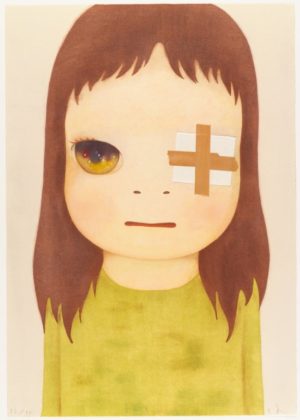
Manga and anime exploded in popularity and influence during this period, although both have deep histories. Manga refers generally to comics and its roots harken back to medieval narrative picture scrolls. Anime refers, of course, to animation, which goes back to the early 20th century and includes, in Japan, the controversial history of its use as a propaganda tool during World War II. In the 1990s, the anime industry grew via revivals and sequels of popular 1970s productions as well as via new genres.
Popular both domestically and internationally, anime and manga are closely related to the principle of kawaii, translated as “cute.” This culture of “cuteness” has often been understood as a form of escapism from the harsh realities of the postwar period and of a country often threatened by calamitous natural disasters. Artists like Yoshitomo Nara and Murakami Takashi use elements from manga and anime to explore the darker underside of kawaii.
Artists like Murakami Takashi refer not only to the contemporaneous culture of manga and anime in their works, but also to older lineages and genealogies of Japanese art history. Murakami is a case in point with his personal and often provocative interpretations of Edo-period “eccentric” painters whose works nonetheless became integral to the canon of Japanese visual arts. Like Andy Warhol or more recently Jeff Koons, Murakami complements his works in painting, sculpture, and installation with merchandise and publications produced by his company, Kaikai Kiki.
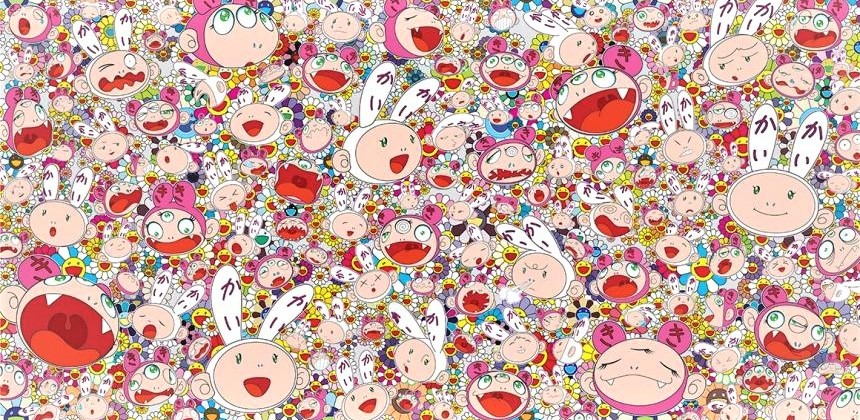
Contemporary Japanese artists use a variety of mediums to express their vision or to focus on the perfection and re-invention of a medium. For example, Sugimoto Hiroshi has gained international acclaim for his contemplative photographs of seascapes as well as for his site-specific sculptural and architectural works. Mariko Mori epitomizes the multidisciplinary artist, exploring her sense of identity and developing her surreal imagery through photography, video, sculpture, installation, and performance. Distinct from artists like Sugimoto and Mori, many contemporary Japanese ceramists devote themselves exclusively to the materials and practices of ceramic art; and similar to artists like Murakami, they produce new works that both honor and challenge tradition.
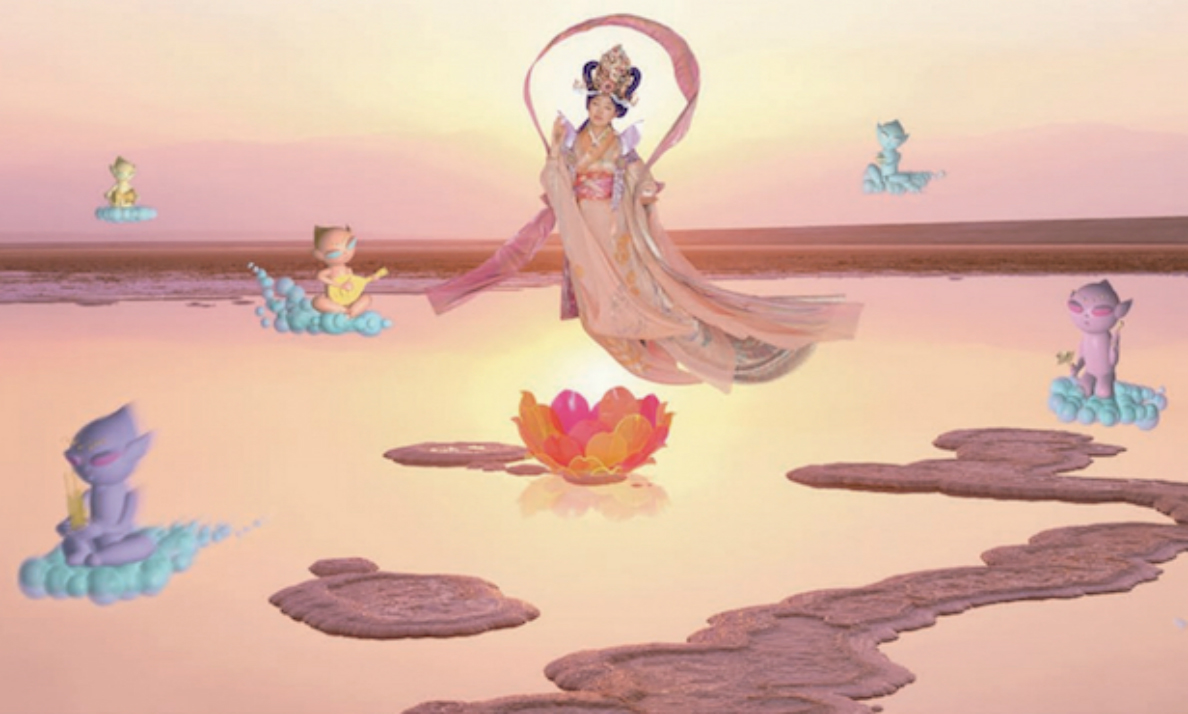
As of May 1st, 2019, when emperor Akihito’s son, Naruhito, ascended the throne, we entered a new era for Japan, namely the Reiwa (translatable to “beautiful harmony”). In Japan as elsewhere, the art of today continues to resonate with the past, while carving its own path forward.
Additional resources
JAANUS, an online dictionary of terms of Japanese arts and architecture
e-Museum, database of artifacts designated in Japan as national treasures and important cultural properties
On Japan in the Metropolitan Museum of Art’s Heilbrunn Timeline of Art History
Richard Bowring, Peter Kornicki, The Cambridge Encyclopedia of Japan (New York: Cambridge University Press, 1993)
Japanese art: the formats of two-dimensional works
Japanese two-dimensional works of art can take a number of different formats—printed books (ehon), single- or multi-sheet prints (hanga), paintings in the form of hanging-scrolls (kakemono) and handscrolls (emaki), moveable folding screens (byōbu), usually in pairs, sliding door paintings (fusuma-e) and smaller scale fan paintings and album leaves. The screens and sliding doors also served to exclude draughts or divide rooms, and were changed according to the season. Hanging-scrolls were displayed, sometimes in pairs or sets of three in the tokonoma (ceremonial alcoves) of reception rooms of mansions and, again, could be changed according to the season, or to honor a special visitor. All such works were viewed seated at floor level on tatami mats.
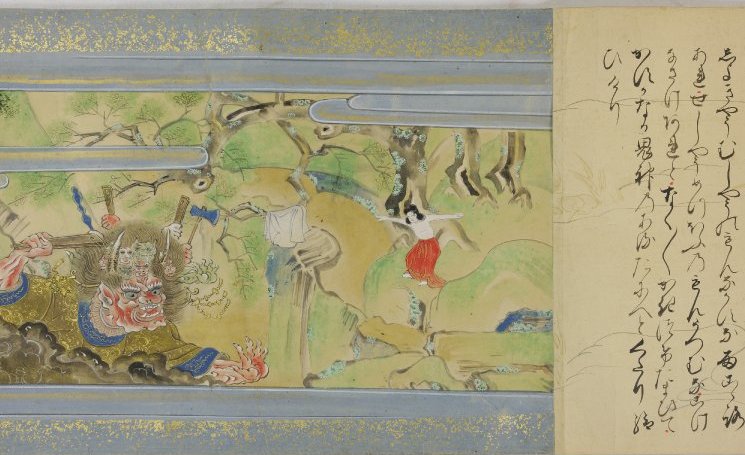
Handscrolls (like the one above) were usually placed on a low table and unrolled from right to left to show a narrative story or seasonal sequence. Print series, small-scale paintings or fan paintings were often mounted in albums. Individual prints, especially the Ukiyo-e portraits of popular actors or courtesans, might be pasted to a screen. The size of the print was limited by the size of cherry-wood block available. Often two, three or more sheets were arranged side by side to depict a wider scene. Books were printed two pages to one sheet of paper, which was then folded, and the sheets sewn together at the spine with a plain cover.
Hanging Scrolls
Kakemono (hanging scrolls) were originally used to display Buddhist paintings, and calligraphy. The painting in ink and colors on either silk or paper was backed with paper and given silk borders chosen to harmonize with the painting. Finally, a roller was affixed to the bottom. Scrolls were kept in specially made paulownia wooden boxes to protect them from dust, changing climate conditions and insect damage.
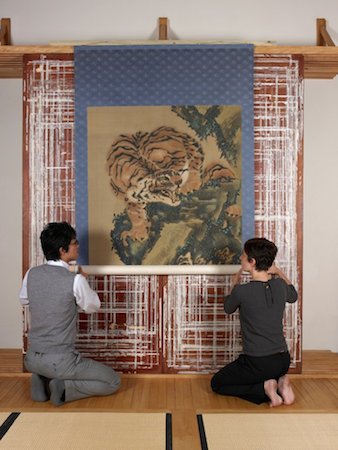
Suggested readings:
L. Smith, V. Harris and T. Clark, Japanese art: masterpieces in The British Museum (London, The British Museum Press, 1990)
© Trustees of the British Museum
Kofun period (300-552 C.E.)
Haniwa Warrior
Video \(\PageIndex{1}\): Haniwa warrior in keiko armor (Kofun period), c. 6th century, excavated in lizuka-machi, Ota City, Gunma, Japan, terracotta, 130.5 cm high (Tokyo National Museum)
Speakers: Dr. Steven Zucker and Dr. Beth Harris

Funerary objects meant to be seen
Haniwa (“clay cylinder” or “circle of clay” in Japanese) are large hollow, earthenware funerary objects found in Japan. Massive quantities of haniwa—many nearly life sized—were carefully placed on top of colossal, mounded tombs, known as kofun (“old tomb” in Japanese). During the Kofun Period (c. 250 to c. 600 C.E.), haniwa evolved in many ways—their shape, the way they were placed on the mounded tombs and, presumably, their specific function or ritual use.
We don’t know much about haniwa or the Kofun Period because there was no writing system in Japan at the time. However, there is general agreement that haniwa were meant to be seen. That is, instead of being buried deep underground with the deceased, haniwa occupied and marked the open surfaces of the colossal tombs. However, it is unlikely that they were readily visible to any person who happened to pass by since the tombs were sacred, ritualized spaces that were usually surrounded by one or more moats. As a result, close visual contact with haniwa would not have been easy for unauthorized visitors. So who was the intended audience of haniwa? Let’s explore further.
Monumental tombs and early Japan
Unlike many other ancient civilizations, we cannot rely on written records to inform us about the names or locations of the earliest kingdoms in Japan. Yet study of kofun indicate that a powerful state had emerged by around 250 C.E. This state is identified by various names (such as the Yamato polity), and was generally centered in what is now Nara, Kyoto, and Osaka prefectures.
We know that a powerful state emerged since vast resources were needed to construct these monumental tombs—starting with the economic means to sacrifice valuable flat land that could otherwise be used for farming and growing rice. Hundreds of workers were also necessary, and archaeologists excavating kofun have recovered pottery from neighboring locations such as present day Nagoya—suggesting that people came from elsewhere to Yamato to serve the needs of this early state.
Many monumental tombs (kofun) were constructed in the shape of a keyhole—otherwise known as zenpō kōen fun (“front squared, rear rounded tomb”). The square part is the front end while the round section is the rear and contains the body (eventually bodies) of the deceased. Keyhole-shaped tombs were adopted as a kind of signature style of this state. Keep in mind that the tombs could have been made in any particular shape—perhaps an octagon—but it was this keyhole shape that was appropriated and then replicated in other regions. Clearly, a formidable political center had emerged with the ability both to build their own colossal tombs and to extend their funerary practices to distant regions. In other words, the gradual adoption of keyhole-shaped colossal tombs over a wide range attests to the existence of a large, organized state with the authority to compel other, competing kingdoms to adopt their practices, likely through the formation of alliances or perhaps by military coercion.

Most of the earliest surviving keyhole-shaped colossal tombs dating to the 3rd century are found in Nara prefecture. One of these is the famous Hashihaka kofun in Sakurai city—measuring about 280 meters in length and 30 meters in height (image above). As a point of comparison, the pyramid of Khufu in Giza measures about 230m in length and 146m in height.
Three periods in tomb-building practices
Scholars identify three major chronological periods or shifts in kofun-building practices, changes that might correlate to changes in the political climate. Not only did the physical shape and size of the tombs transform, so did the type of haniwa, sarcophagi, and other features used in conjunction with the tombs.
- Early Kofun period: c. 250 C.E. – c. 400 C.E.
- Middle Kofun period: c. 400 – c. 500 C.E.
- Late Kofun period: c. 500 – c. 600 C.E.

The colossal tombs reach a maximum size during the Middle Kofun period, and a well-known example is the Daisenryō kofun (also referred to as the Emperor Nintoku tomb) in Sakai city, Osaka prefecture (image, left).
This is the largest, extant kofun and one of the world’s largest funerary monuments, measuring roughly 486m in length, 36m in height, and may have had 15,000 haniwa placed on top.
This trend towards building kofun that were increasingly larger seems to reflect the increasingly powerful rulers of this kingdom; however, by the Late Kofun period the size of the tombs begin to shrink in size. This may have resulted from the unsustainable practice of using up valuable farming land for tombs. Another factor may have been the arrival of new immigrant groups, primarily via the Korean peninsula, who could effectively challenge the authority and dominance of the Yamato monarchs.
By 600 C.E. or so, mounded tombs were no longer made in the keyhole shape, were considerably smaller, and often took a rounded form. Manufacture of haniwa also ended when keyhole-shaped kofun ceased to be built.
Evolution and placement of haniwa
When kofun were newly completed, the surfaces of the mounds were bare of vegetation—the forests that now cover these tombs are the natural consequence of centuries of neglect. Instead, gravel (or other hard stones), or haniwa, were elaborately arranged on the surfaces. Each haniwa was hand-created.

The earliest haniwa, from c. 250 C.E. to around the 450s, were simple forms and most were cylindrical. There were also haniwa whose upper section was not cylindrical but made to replicate shapes based on ritual or military objects.
While the arrangement of haniwa varied from one tomb to another, consecutive haniwa were often lined up along the outermost perimeter of the tomb surface, as if to mark boundaries. In addition to this chain of haniwa on the outer perimeter, inner sections located near the center of the tomb have also been outlined by haniwa as if to designate a special or main staging area.
Haniwa in the form of animals, people and buildings


A major shift occurred around 450 C.E., corresponding to the time when kofun reached their maximum size. The upper section of the haniwa were modeled after animals and people (such as female ritual specialists and male warriors). The reason behind this innovation is not known, but presumably reflects changes in funerary practice.

Haniwa modeled after residential or other kinds of buildings were also made and these were often located above the burial chamber in the rounded section of the tomb. While the outer perimeter might still be predominated by cylindrical haniwa, a few house-shaped haniwa in the center might resemble a miniature village.
Archaeologists have also unearthed haniwa in the form of ritual specialists and warriors standing in parade-like fashion in front of the houses, as if to stand guard and conduct special ceremonies for the benefit of the deceased.
What role did haniwa play?
This now leads us to the question of function and intended audience. What role did haniwa play? Who or what was the intended audience? No one knows for sure, but a number of theories have been proposed. It is also important to remember that function and meaning changed over time and place. The most common understanding is that haniwa were initially used to define the perimeter of the sacred tomb, separating and magically protecting the deceased from the profane space of the living.
With the development of haniwa modeled after humans, the ritual specialists were probably arranged on the tomb to re-enact funerary ceremonies seeking to protect the deceased from harm in the supernatural world, while warriors likely stood guard against enemies—whether human or not. In this sense, haniwa may have been intended to be seen by the un-living, perhaps demons or vengeful ghosts. At the same time, some scholars believe haniwa were also intended to be seen by the living (even if only a highly selective few). The range and kinds of haniwa representing aspects from the life of the deceased may have served to indicate the high status and wealth of the tomb’s occupants. Inclusion of animal-shaped haniwa could be explained as an attempt to replicate a kind of exotic zoo or pleasure garden stocked with animals acquired by the deceased, but this is highly speculative.

Style
As for stylistic aspects, the anthropomorphic (human-shaped) haniwa have a distinct appearance, consisting of a small head and blank, minimalist face with cutout openings for eyes and almost no attempt to portray a body with any degree of realism. Yet, oddly, there is a tremendous amount of detail on accessories and wardrobe, often appearing as lifelike replicas of actual weaponry, metal ornaments, and clothing. This somewhat bizarre contrast between the general and the specific is puzzling. One theory suggests that faces and heads were kept small and plain to keep each haniwa as light as possible on top, preventing the clay figure from toppling over. The large holes that perforate various sections may have had a similar function, to reduce overall weight and to facilitate uniform drying of the wet clay as a way to prevent cracks. In this sense, although physical, bodily attributes could be compromised, the correct tools and wardrobe that both identify and empower individuals to fulfill their job requirements were of utmost importance.
Among the haniwa, it could be said that the most precise, careful attention to detail was reserved for warriors and their horses, reminding us of the critical role played by the military during the Kofun period—a time of massive armed conflict. We now turn to the only haniwa that has received designation as a National Treasure in Japan—the Haniwa Warrior from Gunma prefecture currently housed at Tokyo National Museum.

Closeup of the Warrior Haniwa
This national treasure (TNM J-36697) is one of several haniwa unearthed from the vicinity of Ōta city in Gunma prefecture, which tells us that this was an advanced, regional center for haniwa manufacture (Gunma is located to the north of Tokyo, quite far from Nara). This haniwa offers viewers a rare opportunity to see the detailed armor and weaponry (sword, bow, and quiver) of an ancient clay warrior from this region during the late Kofun period.
Starting with the visorless helmet, especially fascinating is the series of small, evenly spaced half-spherical rivets that appear on a raised section on top of the helmet, in addition to raised strips that connect the sides and front to a narrow band that circles around the forehead and continues behind the head. These rivets are believed to represent metal rivets, suggesting that the warrior’s head was protected by a metal helmet. Attached to the helmet are thick protective ear flaps, seemingly made of padded fabric or leather, while a sheet of thinner material wraps around the rest of the head and neck. Rivets also appear on the narrow quiver, containing four or more arrows, strapped to the warrior’s back.
The short-sleeved body armor that flares outward near the hips does not have rivets, but is covered by thin, vertically incised markings. Two large looped ties found on the chest suggest that this armor was laced together; whether the armor was made by stringing together thin iron plates is unclear based on the visual evidence, but remains as a possibility.
On both forearms, the clay warrior wears padded, protective guards. A wide, sheathed sword falls diagonally across the front of the body, apparently hanging from the waist: the warrior has his right hand on the hilt, ready to the draw the sword at a moment’s notice. The fingers of the left hand gently clasp a thin, vertical object that seems to be a bow; fastened just above the wrist on this hand is a thick, sausage-like object that may be a device to protect his hand from the bowstring.


Standing upright with a mask-like, emotionless face (two narrow slits for eyes, an even more narrow slit for the mouth, and a protruding nose), you might not feel immediately threatened by this warrior. Yet, after observing how this haniwa warrior is, in fact, extremely well-armed with his formidable armor, a weapon in each hand, and supply of arrows on his back—clearly prepared to quickly strike down any enemy that comes his way—you might become a bit more apprehensive.
The intended function of this particular haniwa is not ambiguous, but the question of whether all haniwa—both figurative and non-figurative—were believed to protect the tomb’s occupants in similar fashion is one that is difficult to answer, inviting us to keep pondering the secrets that were buried both inside and outside kofun in ancient Japan.
Additional resources:
Kofun Period on The Metropolitan Museum of Art’s Heilbrunn Timeline of Art History
Haniwa at The Metropolitan Museum of Art
Haniwa on the Google Art Project
Haniwa Horse at the Museum of Fine Arts, Houston
Museum of the Sakitama Ancient Burial Mounds
Haniwa at the Asian Art Museum
Smarthistory images for teaching and learning:
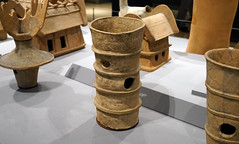
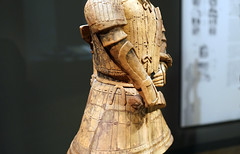
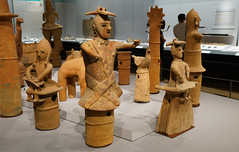

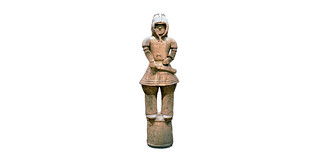
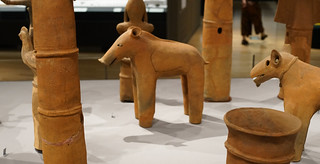
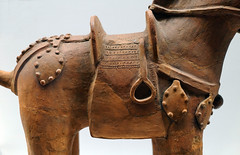
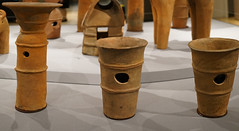
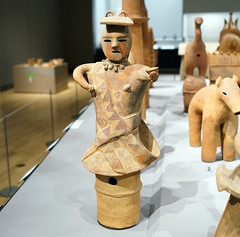
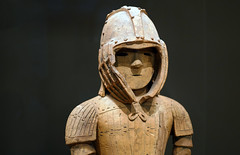
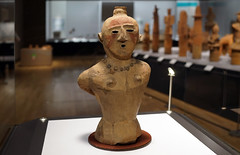
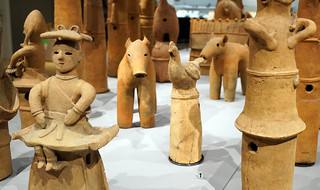
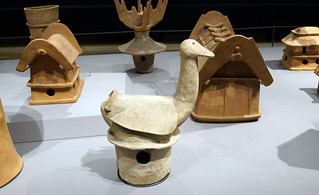
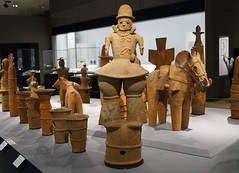
Nara period (710-794)
Tōdai-ji

Built to impress, twice
When completed in the 740s, Tōdai-ji (or “Great Eastern Temple”) was the largest building project ever on Japanese soil. Its creation reflects the complex intermingling of Buddhism and politics in early Japan. When it was rebuilt in the twelfth century, it ushered in a new era of Shoguns and helped to found Japan’s most celebrated school of sculpture. It was built to impress. Twice. What is a shogun?
"The term shogun...is an ancient military term that was adopted in the twelfth century for the dominant warlord who held political and martial power in Japan while the emperor in Kyoto maintained his position as figural head of state and cultural leader. The members of the Minamoto, Ashikaga, and Tokugawa families who held the position of shogun successively from the twelfth to nineteenth centuries varied greatly in the extent and security of their authority and the stability and prosperity of the realm under their command." (Department of Asian Art. "Shoguns and Art". In Heilbrunn Timeline of Art History. New York: The Metropolitan Museum of Art, 2000–. http://www.metmuseum.org/toah/hd/shga/hd_shga.htm (October 2004))
Buddhism, Emperor Shomu and the creation of Tōdai-ji
The roots of Tōdai-ji are found in the arrival of Buddhism in Japan in the sixth century. Buddhism made its way from India along the Silk Route through Central Asia, China and Korea. Mahayana Buddhism was officially introduced to the Japanese Imperial court around 552 by an emissary from a Korean king who offered the Japanese Emperor Kimmei a gilded bronze statue of the Buddha, a copy of the Buddhist sutras (sacred writings) and a letter stating: “This doctrine can create religious merit and retribution without measure and bounds and so lead on to a full appreciation of the highest wisdom.” About Mahayana Buddhism and the Silk Road
Two major schools of Buddhist thought are Theravada and Mahayana Buddhism. According to Theravada Buddhists, each person is responsible for their own enlightenment. Mahayana Buddhism was a school that arose c. 100 C.E. Mahayana literally means: the big vehicle. It is a big “vehicle” that transports more sentient beings across the ocean of existence, from the wheel of Samsara (reincarnation) to enlightenment and nirvana. The cornerstone of Mahayana Buddhism is belief in bodhisattvas, altruistic enlightened beings who delay their own final nirvana until every sentient being reaches enlightenment. (explanation by Dr. Melody Rod-ari)
"The Silk Road is a metaphor for long-distance trade across Asia that first developed from around 300 B.C. to roughly 200 A.D. It was not, in fact, a "road," but rather a collection of land and sea routes linking cities, trading posts, caravan watering places, and hostels between the eastern Mediterranean and China." ("The Silk Road." New York: The Metropolitan Museum of Art. http://www.metmuseum.org/exhibitions.../the-silk-road (June 2009))

Buddhism quickly became associated with the Imperial court whose members became the patrons of early Buddhist art and architecture. This connection between sacred and secular power would define Japan’s ruling elite for centuries to come. These early Buddhist projects also reveal the receptivity of Japan to foreign ideas and goods—as Buddhist monks and craftspeople came to Japan.
Buddhism’s influence grew in the Nara era (710-794) during the reign of Emperor Shomu and his consort, Empress Komyo who fused Buddhist doctrine and political policy—promoting Buddhism as the protector of the state. In 741, reportedly following the Empress’ wishes, Shomu ordered temples, monasteries and convents to be built throughout Japan’s 66 provinces. This national system of monasteries, known as the Kokubun-ji, would be under the jurisdiction of the new imperial Tōdai-ji (“Great Eastern Temple”) to be built in the capital of Nara.
Building Tōdai-ji
Why build on such an unprecedented scale? Emperor Shomu’s motives seem to have been a mix of the spiritual and the pragmatic: in his bid to unite various Japanese clans under his centralized rule, Shomu also promoted spiritual unity. Tōdai-ji would be the chief temple of the Kokubun-ji system and be the center of national ritual. Its construction brought together the best craftspeople in Japan with the latest building technology. It was architecture to impress—displaying the power, prestige and piety of the imperial house of Japan.
However the project was not without its critics. Every person in Japan was required to contribute through a special tax to its construction and the court chronicle, the Shoku Nihon-gi, notes that, “…the people are made to suffer by the construction of Tōdai-ji and the clans worry over their suffering.”
Bronze Buddha
Tōdai-ji included the usual components of a Buddhist complex. At its symbolic heart was the massive hondō (main hall), also called the Daibutsuden (Great Buddha Hall), which when completed in 752, measured 50 meters by 86 meters and was supported by 84 massive cypress pillars. It held a huge bronze Buddha figure (the Daibutsu) created between 743 to 752. Subsequently, two nine-story pagodas, a lecture hall and quarters for the monks were added to the complex.

The statue was inspired by similar statues of the Buddha in China and was commissioned by Emperor Shomu in 743. This colossal Buddha required all the available copper in Japan and workers used an estimated 163,000 cubic feet of charcoal to produce the metal alloy and form the bronze figure. It was completed in 749, though the snail-curl hair (one of the 32 signs of the Buddha’s divinity) took an additional two years.
When completed, the entire Japanese court, government officials and Buddhist dignitaries from China and India attended the Buddha’s “eye-opening” ceremony. Overseen by the Empress Koken and attended by the retired Emperor Shomu and Empress Komyo, an Indian monk named Bodhisena is recorded as painting in the Buddha’s eyes, symbolically imbuing it with life. The Emperor Shōmu himself is said to have sat in front of Great Buddha and vowed himself to be a servant of the Three Treasures of Buddhism: the Buddha, Buddhist Law, and Buddhist Monastic Community. No images of the ceremony survive but a Nara period scroll painting depicts a sole, humbly small figure at the Daibutsu’s base suggesting its awe-inspiring presence.

The Daibutsu sits upon a bronze lotus petal pedestal that is engraved with images of the Shaka (the historical Buddha, known also as Shakyamuni) Buddha and varied Bodhisattvas (sacred beings). The petal surfaces (image left) are etched with fleshy figures with swelling chests, full faces and swirling drapery in a style typical of the elegant naturalism of Nara era imagery. The petals are the only reminders of the original statue, which was destroyed by fire in the twelfth century. Today’s statue is a seventeenth-century replacement but remains a revered figure with an annual ritual cleaning ceremony each August.
Chogen and the rebuilding of Tōdai-ji in the Kamakura Era (1185-1333)
The Genpei Civil War (1180-85) saw countless temples destroyed as Buddhist clergy took sides in clan warfare. Japan’s principal temple Tōdai-ji sided with the eventually victorious Minamoto clan but was burned by the soon-to-be defeated Taira clan in 1180.
The destruction of this revered Temple shocked Japan. At the war’s end, the reconstruction of Tōdai-ji was one of the first projects undertaken by Minamoto Yoritomo who, as the new ruling Shogun, was eager to present the Minamoto as national saviors. The aristocracy and the warrior elite contributed funds and the Buddhist priest Shunjobo Chogen was placed in charge of reconstruction. Tōdai-ji again became the largest building project in Japan.


Chōgen was unique in his generation in that he made three trips to China between 1167-1176. His experience of Song Dynasty Buddhist architecture inspired the rebuilding of the temples of Nara, in what became know as the “Great Buddha” or the “Indian” style.
The key-surviving example of this style is Tōdai-ji’s Great South Gate—Nandaimon—which dates to 1199. An elaborate bracketing system supports the broad-eaved, two-tiered roof. The Nandaimon holds the 2 massive wooden sculptures of Guardian Kings (Kongō Rikishi) by masters of the Kei School of Sculpture.
Kei School of Sculpture
The large scale rebuilding after the Genpei Civil War created a multitude of commissions for builders, carpenters and sculptors. This concentration of talent led to the emergence of the Kei School of sculpture—considered by many to be the peak of Japanese sculpture. Noted for its austere realism and the dynamic, muscularity of its figures, the Kei School reflects the Buddhism and warrior-centered culture of the Kamakura era (1185–1333).
Unkei is considered the leading figure of the Kei school, with a career spanning over 30 years. His distinctive style emerged in his work on the refurbishment of the many Nara temples/shrines, most particularly Tōdai-ji. Unkei’s fierce guardian figure Ungyō in the Nandaimon is typical of Unkei’s powerful, dynamic bodies. It stands in dramatic contrapposto opposite the other muscular Guardian King, Agyō, created with Kaikei and other Kei sculptors.

Both figures are fashioned of cypress wood and stand over eight meters tall. They were made using the joint block technique (yosegi zukuri), that used eight or nine large wood blocks over which another layer of wooden planks were attached. The outer wood was then carved and painted. Only a few traces of color remain.
Ecology, craftsmanship & early Buddhist art in Japan
The grand Buddhist architectural and sculptural projects of early Japan share a common material—wood–and are thus closely linked to the natural environment and to the long history of wood craftsmanship in Japan.
When Korean craftsmen brought Buddhist temple architecture to Japan in the sixth century, Japanese carpenters were already using complex wooden joints (instead of nails) to hold buildings together. The Korean’s technology allowed for the support of larger, tile-roof structures that used brackets and sturdy foundation pillars to funnel weight to the ground. This technology ushered in a new, larger scale in Japanese architecture.
Monumental timber framed architecture requires enormous amounts of wood. The wood of choice was cypress, which grows up to forty meters tall and has a straight tight grain that easily splits into long beams and is resistant to rot.
The eighth-century campaign to construct Buddhist temples in every Japanese province under Imperial control (mostly in the Kinai area, today home to Osaka and Kyoto) is estimated to have resulted in the construction 600-850 temples using three million cubic meters of wood. As the years progressed Kinai’s old growth forests were exhausted and builders had to travel farther for wood.

By far the most prestigious and wood-demanding project was the Imperial monastery of Tōdai-ji. Eighth-century Tōdai-ji had two 9-storey pagodas and a 50 x 86 meter great hall supported by 84 massive cypress pillars that used at least 2200 acres of local forest. After Tōdai-ji’s destruction in 1180, it was rebuilt under the supervision of the monk Chogen, who solicited aid from all over Western Japan. Builders had to travel hundreds of kilometers from Kinai to find suitable wood. Whole forests were cleared to find tall cypresses for pillars, which were then transported at great cost: 118 dams were built to raise river levels in order to transport the massive pillars. And that was only the pillars—wood for the rest of the structure came from at least ten provinces.
Tōdai-ji’s reconstructed main hall was only half the size of the original and its pagodas several stories shorter. The availability or scarcity of quality local wood was a major factor in the design and evolution of architecture in Japan. For example, the growing scarcity of cypress of structural dimensions led to innovations that allowed carpenters to work with less straight-grained woods, like red pine and zelkova.
The Shōsōin Repository and its treasure
Shōsōin Repository
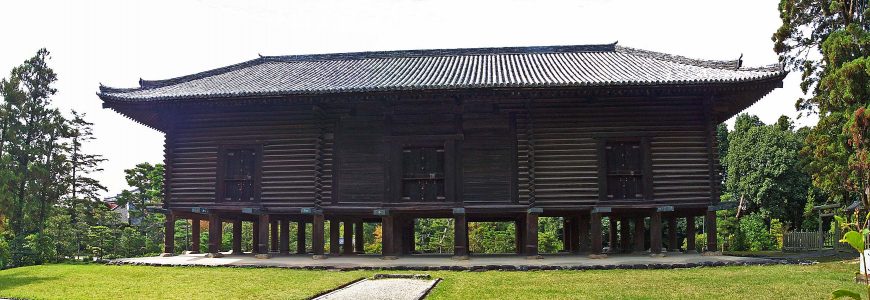
In the Japanese city, Nara, on the northwest rear corner of Tōdai-ji Temple’s Daibutsuden Hall stands a building largely unaltered since the 8th century. Of age-darkened cypress and deceptively plain, its distinctively ribbed walls, punctuated by large flat rectangular doors, find an echo in the linear grooves of its deeply eaved, flaring roof of ceramic tiles. Poised on forty columns and lacking stairs, its simple box shape seems to float. This vision of austere, geometric elegance is the Shōsōin Repository.
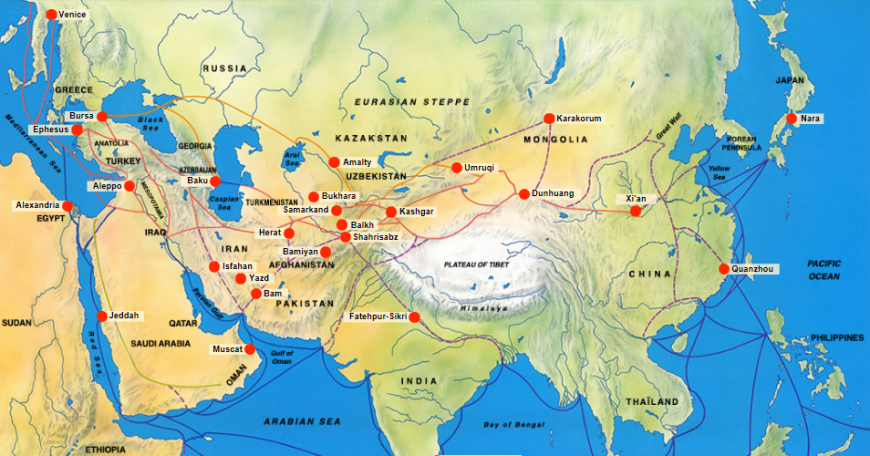
For almost 1200 years, until the twentieth century, it preserved in excellent condition approximately nine thousand artifacts from China, Southeast Asia, Iran, and the Middle East—a miscellany connecting ancient Japan to the cultural trade and artistic exchange of the Eurasian continent. While other collections worldwide hold treasures from the ancient Silk Roads, the Shōsōin is unique as a time capsule of the entire known world of its time—when Nara-period Japan glowed as a star in the brilliant cultural cosmos of Tang-dynasty China (618-907).
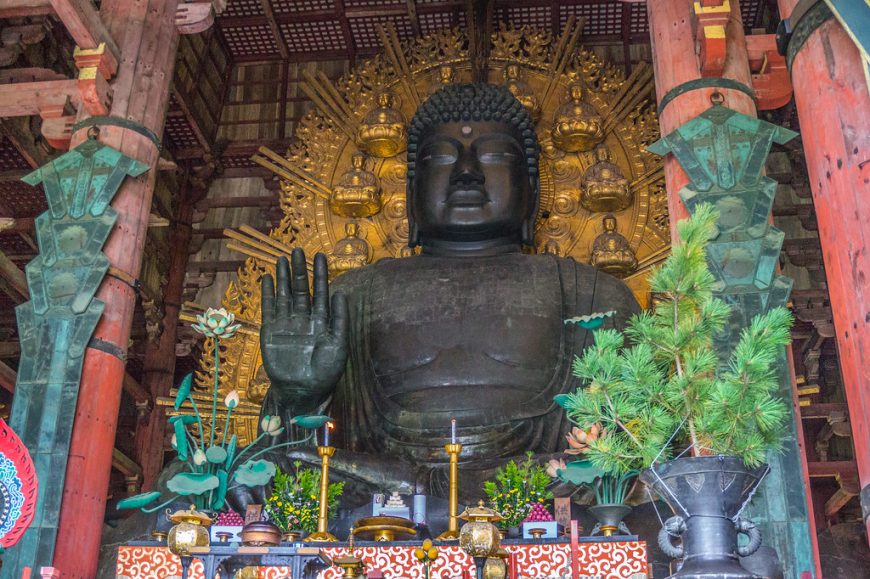
The structure and its context
Despite its grand spiritual setting, the Shōsōin itself is practical, and not intrinsically religious. It typifies a renowned form of storehouse called an azekura zukuri, developed by ancient Japanese village carpenters to hold grain and other foodstuffs that formed the lifeblood of their agrarian society. Often referred to as of “log cabin style,” this two thousand-year-old design is not the primitive, drafty pile the expression typically calls to mind. Nor is it simply a matter of taste. Its appearance owes to sophisticated structural engineering that makes brilliant use of wood’s basic property to expand and contract according to weather conditions. The precisely planed, triangular logs interlock to form a flat wall on the interior and the uniquely ribbed exterior.
The ceramic tiles and hip-and-gable design of the roof both shed water and repel fire. The columns that raise it from the ground stand on natural stone. In all, this creates a natural climate regulation system that lessens the dampness of Japan’s humid climate, and discourages infestation by vermin. The absence of permanent stairs deters thieves. The wooden chests in which most of the objects were kept provided additional protection, preventing light and pollution from damaging the organic materials. The secure, ventilated conditions proved ideal for protecting the prized possessions of Japan’s Buddhist monastic communities. The Shōsōin is the oldest extant example of such treasure houses.
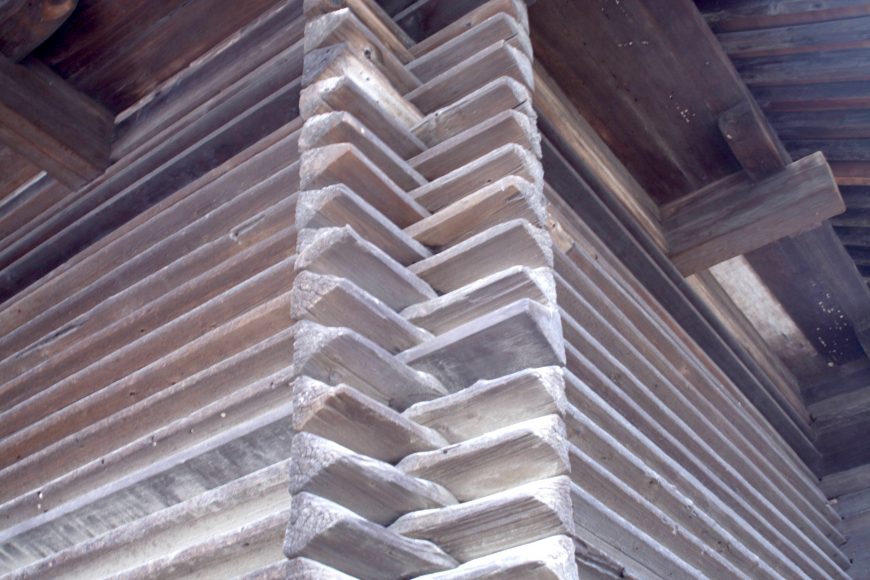
The Shōsōin interior contains three rooms on two floors, each with an entrance door. Despite the lack of written sources confirming its dating, a recent analysis of the timbers has confirmed a middle-8th century construction date (note that the middle room walls with additional flat beams that are different from those of the other two, is likely not original). Restorations done during the much later Edo period (1603 – 1868), including iron strips added to the columns and copper plates added to protect the floor edging, do not significantly impact the repository.
Objects as Buddhist offerings
Founded by early emperors, Tōdai-ji was one Japan’s highest-ranking Buddhist monastic communities and remains an important religious center. Patronage from members of imperial and noble families, as acts of piety, made it among the wealthiest. The Shōsōin mainly served to house personal possessions donated by Empress Kōmyō to the Daibutsu Vairocana, a Buddha that is the world’s largest cast-bronze statue. These gifts were made after the death of her husband, Emperor Shōmu in 756, in order to ensure the protection of his soul. These offerings were stored in the Northern room.
Senior monks used the Middle and Southern rooms for ceremonial objects, and in the 10th century, articles and documents were added from another smaller repository nearby. While the Southern room remained accessible until the Meiji period (1868-1912), sometime in the 12th century, Japan’s Imperial household sealed the Middle and Northern rooms. High-ranking ministers took responsibility for their security. From this point on the Shōsōin was rarely opened and over the centuries it survived both war and fire, leaving virtually all the ancient cultural treasures intact.
The treasure at the Shōsōin Repository
The thousands of items preserved in the Shōsōin repository include manuscripts, musical instruments, textiles, shoes, banners, ceramics and glass, metalwork, and lacquerware. These objects showcase the high level of craftsmanship and the complex techniques available to the imperial household during this early period, some of which are now lost.
We also benefit from the meticulous records of these objects kept by ancient caretakers. Thanks to an inscription on each, today we know its date, usage, and sometimes its provenance—all of which help to put the objects in context. The material preserved in the repository is particularly important because it created the foundation for the Japanese art and style that followed, which originated in this era against the backdrop of China’s Tang Dynasty (which has long been seen as a golden age of art, music, and literature, and economic and political influence across East Asia). Nara was modeled after Chang’an (now Xi’an in China) the Tang capital, and a self-proclaimed center of Buddhism. It was especially between the 7th and 8th centuries that Japan, welcoming foreign people and sending envoys abroad, studied, preserved, and developed its own artistic culture.
Silk Roads
The unquestionable beauty and finesse of the mulberry wood lute inlaid with mother of pearl makes evident Tang China’s wide, complex cultural impact. Known in Japan as a Kuwanoki no genia and in China as a pipa, this pear-shaped 5-string instrument was likely introduced originally to China from Central Asia in the 1st or 2nd century C.E., and would attain a lasting popularity. This particular 8th century example from the Shōsōin very much recalls the type of pipa depicted on murals of the 3rd-4th century Buddhist cave complexes of Dunhuang and Yulin in what is now Gansu Province, China—vestiges of a chain of major monastic centers that once spread Buddhism and served as junctions for the interchange of ideas, goods and peoples along the northern Silk Roads.
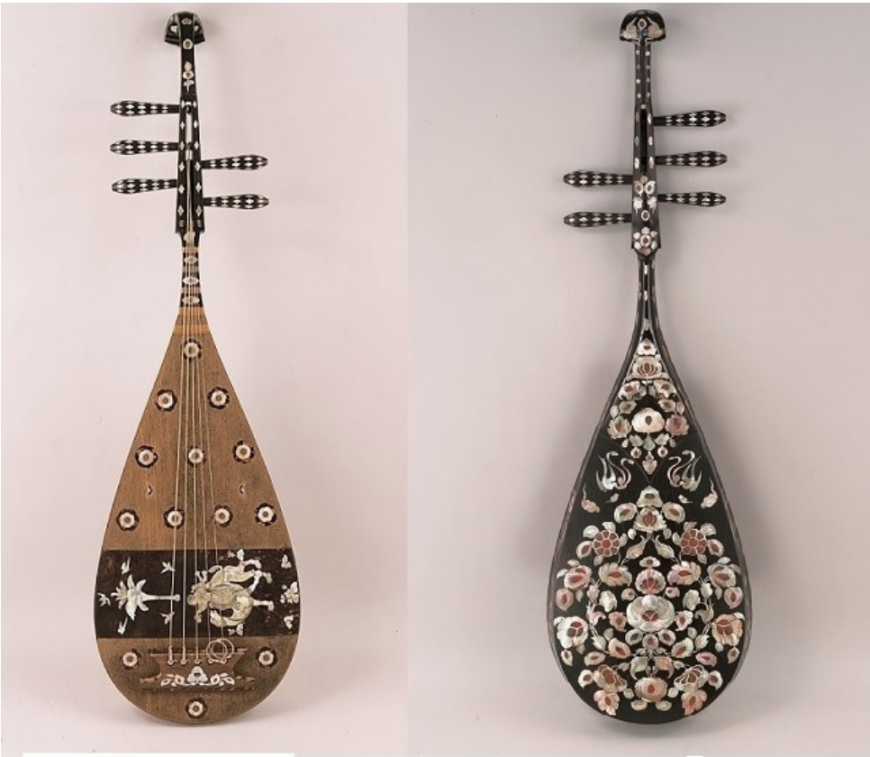
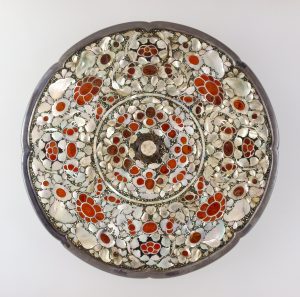
Far east across the Yellow Sea, the Sea of Japan, and the ancient kingdoms of the Korean peninsula, the route concluded with the imperial monasteries of Nara-era Japan, including Tōdai-ji.
The large floral motif embellishing the Kuwanoki no genia and other objects in the repository, such as mirrors, boxes, and ritual rugs offer further links. Typical of the late Tang period, this motif is generally recognized as an emblem of the Tang dynasty; and in Japan it is known as kara-hana, meaning “Tang flower.”
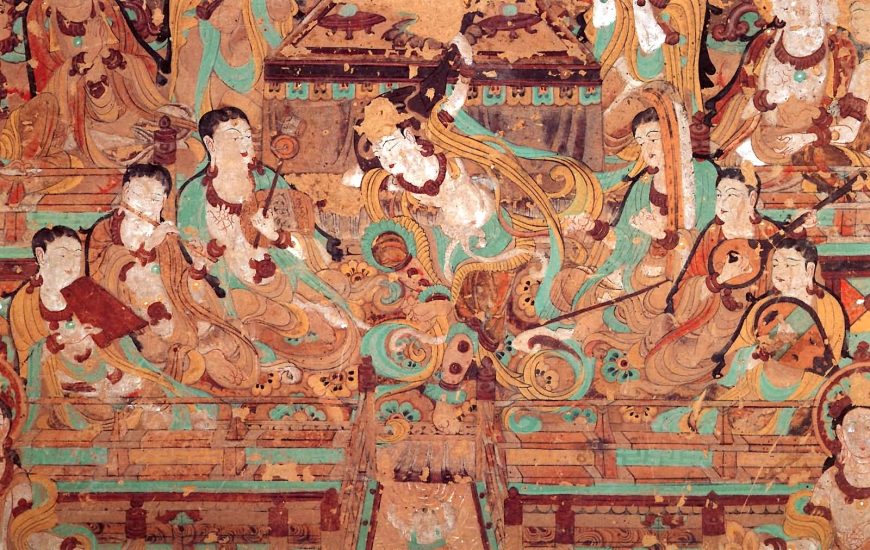
Sasanian influence
Correspondence with visual material from these Chinese caves confirms that many objects in the Shōsōin enjoyed actual use. The repository artifacts likewise make very tangible the Silk Route’s far-flung connections and the complexities. For example, a handsome glass bowl with cut hollow facets finds an echo in a 9th century banner discovered in the Mogao caves at Dunhuang.
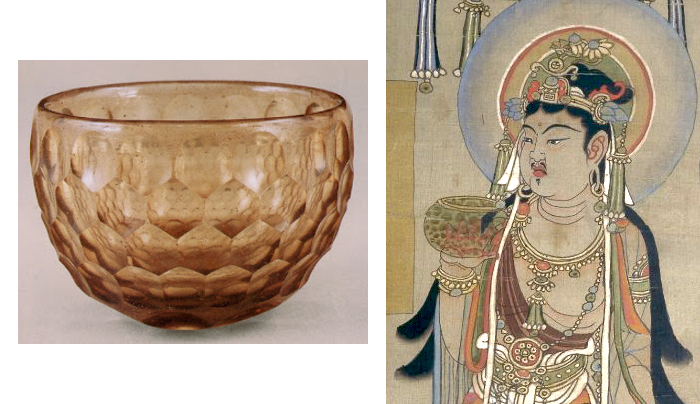
The banner portrays an important deity, a Bodhisattva, holding a similar bowl his hand (in Japanese the bowl is called a Hakururi no wan). This type of glass is commonly known as “Sasanian glass,” referring to the last pre-Islamic Iranian dynasty that, from the 3rd to the 7th century, dominated a vast Eurasia territory (from Central Asia to Iraq). But this type of glass was already being produced before the Sasanian period, and also elsewhere in the Middle East. A similar, much earlier type also was discovered in Palmyra (in modern Syria).
Ancient fabrics were among the most highly prized of luxury items in ancient times and represent the majority of the artifacts from the Shōsōin. Similar patterned textiles remain among the important possessions of other Buddhist communities established during the era of imperial Nara (such as Hōryū-ji). Almost entirely made of silk and ramie, they belong to the second period of textile development in Japan, which like other items in the Shōsōin, reflect Tang China’s influence in their motifs, such as the floral medallion made in weft-faced compounds (generally known in the West as samite). An earlier, first phase can be dated to between the 4th or 5th centuries, possibly when early emperors invited textile weavers to Japan from Korean kingdoms and China, societies that were then far more sophisticated.
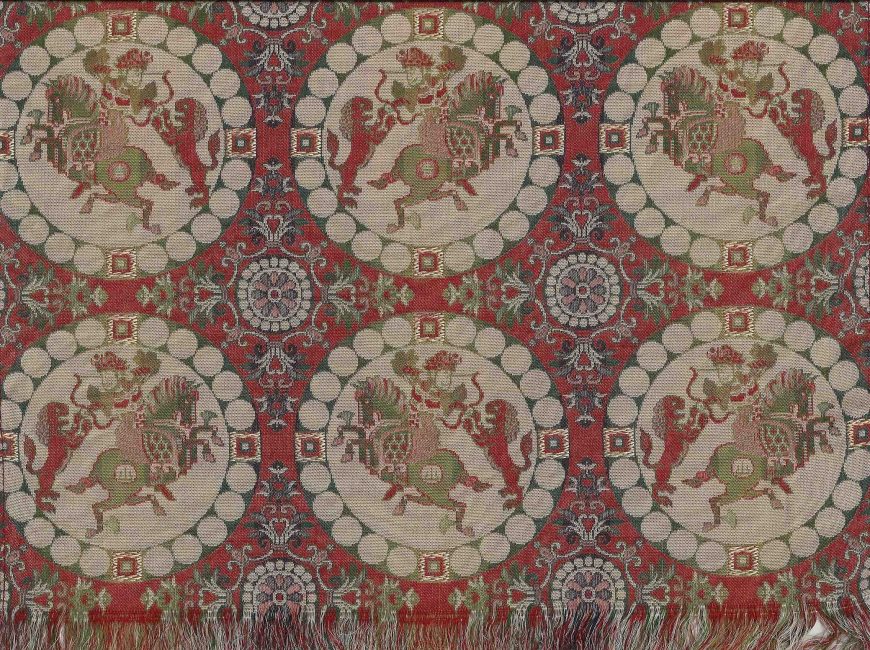
In particular, a clan of artisans called the Nishiki is mentioned in early Japanese historical accounts, most famously “A Record of Ancient Things” (Kojiki) and “Chronicles of Japan” (Nihon Shoki). Not by coincidence, the term nishiki has long referred to Japanese polychrome patterned weavings.
Amongst the Iranian or Iranian-inspired artifacts in Nara, there is a particular nishiki fragment, now considered a national treasure, which shows the artistic collaboration among a diverse group of artisans of different ethnic groups who combined their artistic and technical expertise. Its design consists of a repetition of beaded roundels enclosing pairs of mirrored hunters on a winged horse, drawing a bow at a rearing lion. All the pictorial elements in the composition (crown, roundel, flower, etc.) link to Sasanian motifs, though the Chinese characters in the bodies of the horses suggest possible Chinese-Central Asian production. Such collaborations were quite frequent along the Silk Road, especially in the area between Sogdiana (a colony of the Eastern Sasanian Empire) and Turfan in the Xinjiang Province. The composition often appears on Sasanian metalwork in collections worldwide.
Today
In 1997, the Shōsōin building was designated as a National Treasure and registered as part of the World Heritage. Its contents are no longer kept there but in two secure buildings built nearby in 1953 and 1962, called the Eastern and the Western Repository. Every autumn, for about two weeks, fifty to sixty items are exhibited in the Nara National Museum (with a related catalog), giving the public the opportunity to admire and learn about many of the Buddhist-inspired artifacts preserved by the Shōsōin that characterize the “Nara period.” The Shōsōin’s treasure as a whole represents the cultural transfers that occurred along the Silk Road, which stretched in the East through China and Korea, and placed Japan in an ancient global context.
Additional resources:
History of Shōsōin from the Imperial Household Agency shosoin.kunaicho.go.jp/en-US/Home/About/History
Collections of Persian Art in Japan
Complete list of SHOSOIN Collection solid objects ‘Shosoin Tanabetu MOKUROKU’, Nara, Japan
Japan’s Oldest Archive: A Workshop on the Shosoin
Traveling the Silk Road from the American Museum of Natural History
Ry-Oichi Hayashi. The Silk Road and the Shoso-In (The Heibonsha Survey of Japanese Art ; V. 6. Clarendon: Tuttle Publishing, 1980).
Kaneo Matsumoto, Jōdai –Gire: 7th and 8th Century Textiles in Japan from the Shōsō-in and Hōryū-ji (Kyoto: Shikosha Publishing Co. Ltd., 1984).
Kamakura period
The shoguns (military leaders) gradually gained power over the nobility during this turbulent period.
1185 - 1333
Jizō Bosatsu
by DR. HANNAH SIGUR and DR. STEVEN ZUCKER
Video \(\PageIndex{2}\): Jizō Bosatsu, late 12th to mid-13th century, Kamakura period, Japan, wood with lacquer, gold leaf, cutout gold foil decoration, and color, 181.6 x 72.4 x 57.4 cm (The Metropolitan Museum of Art) Speakers: Dr. Hannah Sigur and Dr. Steven Zucker
Additional resources:
This work at The Metropolitan Museum of Art
Kamakura and Nanbokucho Periods on The Metropolitan Museum of Art’s Timeline of Art History
Smarthistory images for teaching and learning:
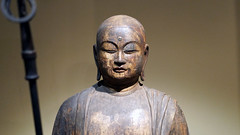
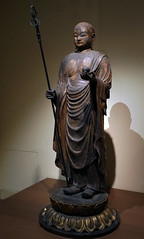
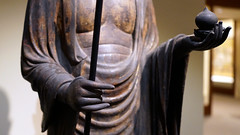
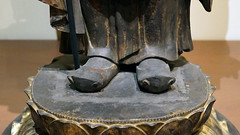
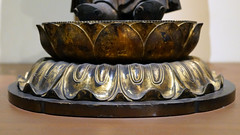
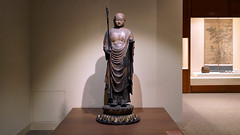
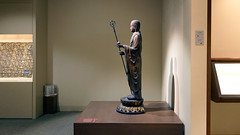
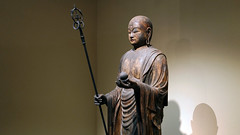
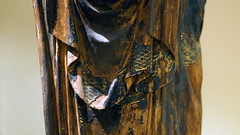
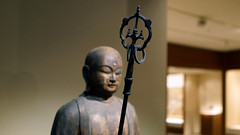
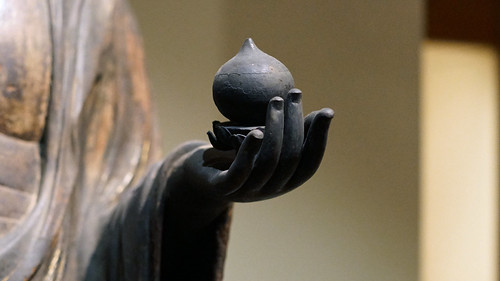
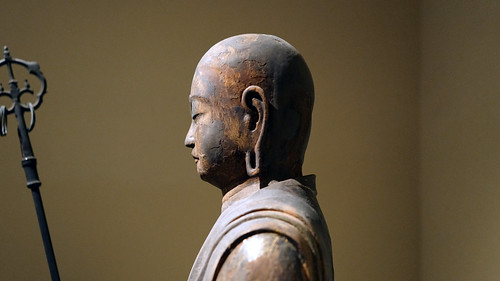
Prince Shōtoku at Age Two
by DR. RACHEL SAUNDERS and ANGELA CHANG
Video \(\PageIndex{3}\): Prince Shōtoku at Age Two, Kamakura period, c. 1292, Japanese cypress, assembled woodblock construction with polychromy and rock-crystal inlaid eyes (Harvard Art Museums/Arthur M. Sackler Museum)
Speakers:
Rachel Saunders, Ph.D., Abby Aldrich Rockefeller Associate Curator of Asian Art, Harvard Art Museums
Angela Chang, Conservator of Objects and Sculpture, Assistant Director, Straus Center for Conservation and Technical Studies, Harvard Art Museums
Steven Zucker, Ph.D.
Night Attack on the Sanjô Palace
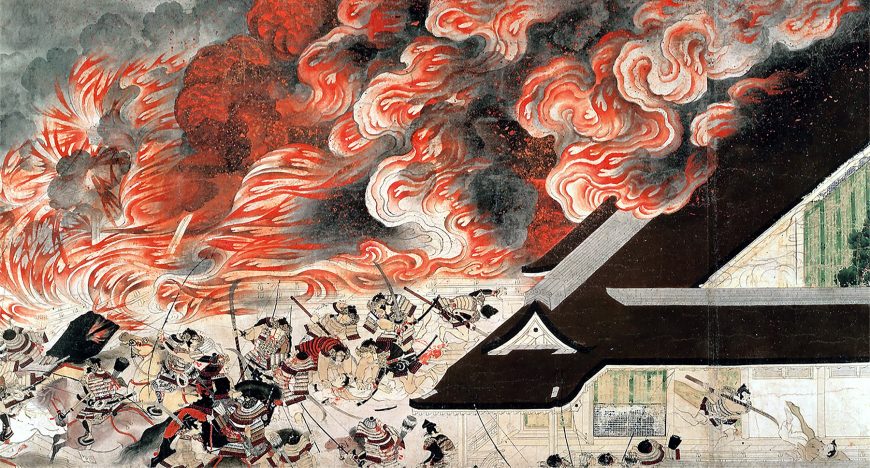
It is hard to imagine an image of war that matches the visceral and psychological power of the Night Attack on the Sanjô Palace. This thirteenth-century portrayal of a notorious incident from a century earlier appears on a hand scroll, a common East Asian painting format in Japan called an emaki. It also is a prime example of the action‐packed otoko‐e, “men’s paintings,” created in the Kamakura period.
A handscroll is meant to be held and unrolled section by section horizontally in contrast to a scroll that is intended to be hung and is vertically oriented.
The Kamakura period lasted from 1185 until 1333. It was initiated by the Shogun Minamoto no Yoritomo and marked the beginning of feudal Japan and the samurai caste.

Designed to be unrolled in sections for close‐up viewing, it shows the basic features of this pictorial form: a bird’s eye view of action moves right‐to‐left (between a written introduction and conclusion). In vibrant outline and washes of color, the story (one event in an insurrection—more on this below) unfolds sequentially, so the main characters appear multiple times. The attention to detail is so exact that historians consider it a uniquely valuable reference for this period: from the royal mansion’s walled gateways, unpainted wooden buildings linked by corridors, bark roofs, large shutters and bamboo blinds that open to verandas, to the scores of foot soldiers, cavalry, courtiers, priests, imperial police, and even the occasional lady—each individualized by gesture and facial expression from horror to morbid humor, robes, armor, and weaponry easily identifiable according to rank, design, and type.

Unfurled this work stands apart. Its now‐forgotten artist used the expressive potential of the long, narrow emaki format with such interpretive brilliance that he perhaps considered that on occasion it might be fully open. He organized a jumble of minutiae into a cohesive narrative arc.

Beginning from a point of ominous calm, a single ox carriage transports the eye to a tangle of shoving and colliding carts and warriors. With escalating violence, the energy pulses, swells, and then rushes to a crescendo of graphic hand‐to‐hand mayhem—decapitations, stabbings and hacking, the battle’s apex marked at the center by the palace rooflines slashing through the havoc like a bolt of lightening followed by an explosion of billowing flame and women fleeing for their lives amid the din.

The chaos ebbs as victors and dazed survivors stream through the rear gate, and ends in grisly, surreal calm with the dressed and tagged heads of vanquished nobles on pikes, a disorderly cluster of foot soldiers and cavalry surrounding the ox carriage, their general trotting before them in victorious satisfaction over the smoking wreckage and bloody atrocity left behind.
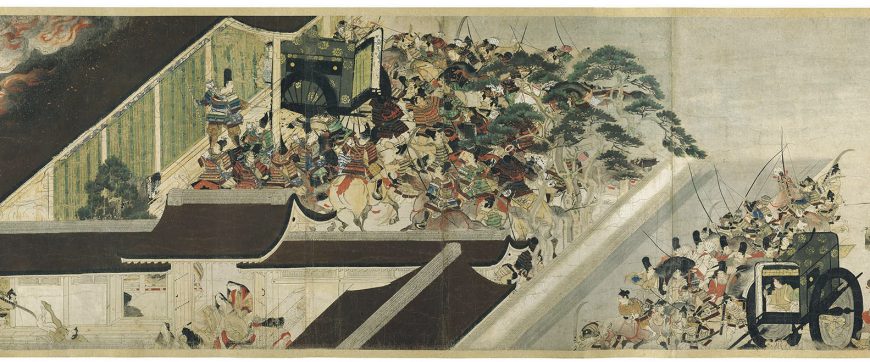
The Night Attack at Sanjô Palace arrests even the casual viewer with its sheer comprehensibility. Although the artist would likely not have imagined an audience beyond the world he knew, his vision has enthralled viewers across centuries and cultures, making this painting not only among the very finest picture scrolls ever conceived, but also among the most gripping depictions of warfare—creating an irresistible urge to examine the work closely. But in depicting an event that really happened, it comes fully to life only when we know something of what it so vividly portrays.
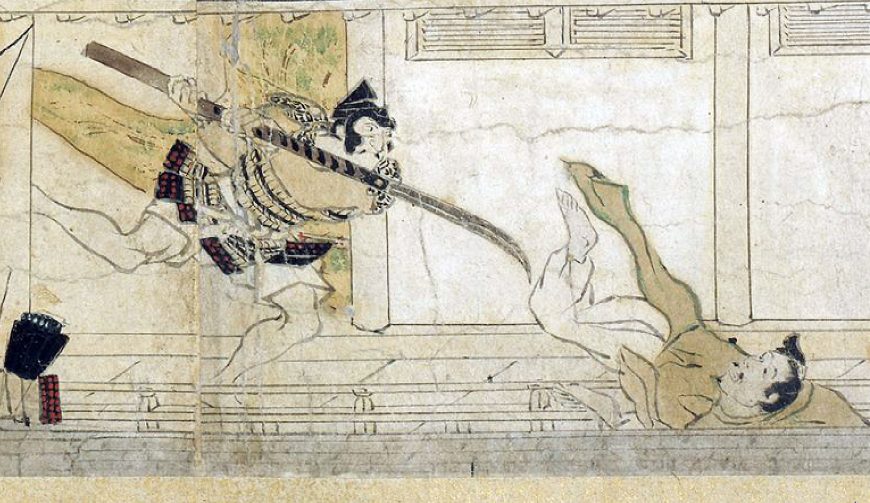
This begins in a brief introduction to a complicated yet fascinating chapter in Japanese history. Incredibly, the appalling incident at Sanjô Palace depicted on the scroll was but one chapter in the vicious Heiji Insurrection of 1159‐60. This short war, with two other famous conflicts before and after, punctuated a brutal epoch that came to a close in 1192 with the establishment of the Kamakura shogunate. The stories of these flashpoints of blood thirst, collectively called gunki monogatari, or “war tales,” have inspired a huge body of art over the centuries. The Night Attack on the Sanjô Palace, once part of a larger set that pictorialized the entire Heiji incident, survives with two other scrolls, one of them only in remnants.
Shōgun refers to the rule of a military leader. Shōgun warlords ruled Japan from 1192 until 1867 though they were, in theory, appointed by the emperor. Their rule is known as the shogunate.

Stories of romanticized martial derring‐do, gunki monogatari are history recounted by the victors. They celebrate Japan’s change from a realm controlled by a royal court to one ruled by samurai. But the events originated in the unusual, even unique, nature of Japan’s imperial world. Centered in the city of Kyôto, in some ways it resembled many ancient kingdoms. It was prey to shifting loyalties, betrayals, and factional divisions among ambitious families who would stop at nothing in the quest for power. As elsewhere, emperors had several consorts, and noble daughters served as tools in political marriages to elevate the power of their families, and above all their clan head.

Unusually, a few patriarchs managed over time to displace imperial authority, relegating emperors to stultifying ceremonial functions. And possibly uniquely, Japanese emperors found a way to reclaim some of that lost power: by abdicating in favor of a successor. Freed from onerous rituals, a “retired” emperor could assert himself. Which prince from which wife of which current or previous emperor would succeed to the throne stood highest among the disputes. By the twelfth century, nobles as well as current and retired emperors had all turned to samurai clans to resolve their bitter rivalries.
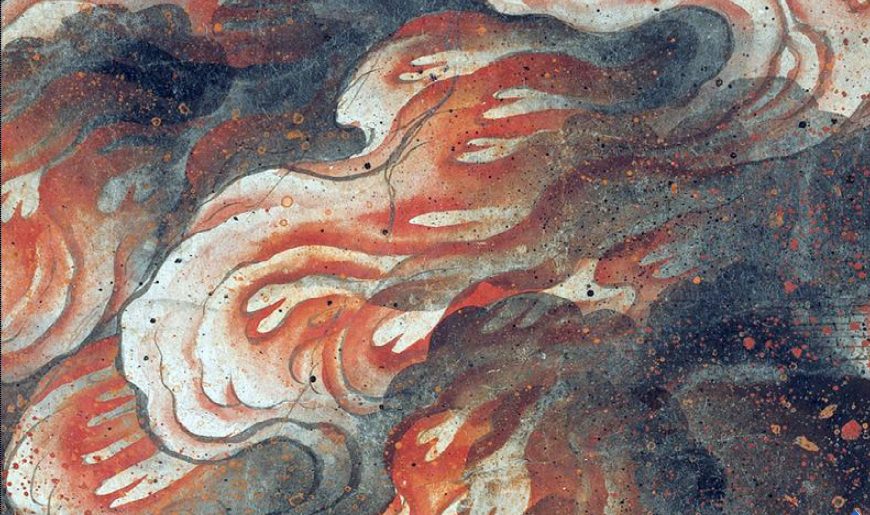
The cast of characters in the Night Attack at the Sanjô Palace came from this treacherous world. Sanjô Palace was the home of former Emperor Go‐Shirakawa, known for a career as the wiliest and longest‐lived of retired royals. He had recently abdicated in favor of his son Emperor Nijô. The two emperors backed vying sides of the Fujiwara clan, a conspiratorial family unsurpassed in subjugating and sometimes choosing a succession of emperors. One member of this clan, Fujiwara no Nobuyori,[1] plotted against everyone. The Taira and the Minamoto clans served powerful interests in all of these disputes, while also pursuing their own ambitions as bitter rivals of the other.
Who were the Minamoto and the Taira samurai clans?.
The Taira and Minamoto samurai clans may have originated in the early 9th century when emperors demoted members of their families to the lesser rank of noble.
The samurai Taira clan (also known as Heike) was one of four powerful families during this period.
The samurai Minamoto clan (also known as Genji) was another of the four noble families of this period.
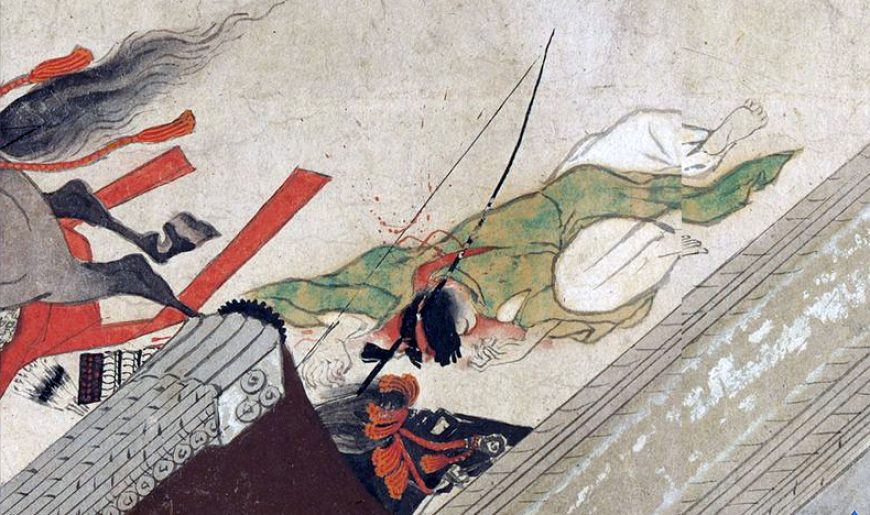
Simply put the Night Attack was part of Fujiwara no Nobuyori’s bid to seize power by abducting both the emperor and the retired emperor. Backed by Minamoto no Yoshitomo, head of that clan, Nobuyori saw an opportunity when the head of the Taira clan, who supported Emperor Nijō, left Kyōto on a pilgrimage. The emaki depicts the seizing of the retired emperor Go‐Shirakawa. Three key elements appear multiple times, orienting the eye and organizing the sweep of events: guided by a groom inside, the elegant ox carriage that will carry off Go‐Shirakawa opens the action.
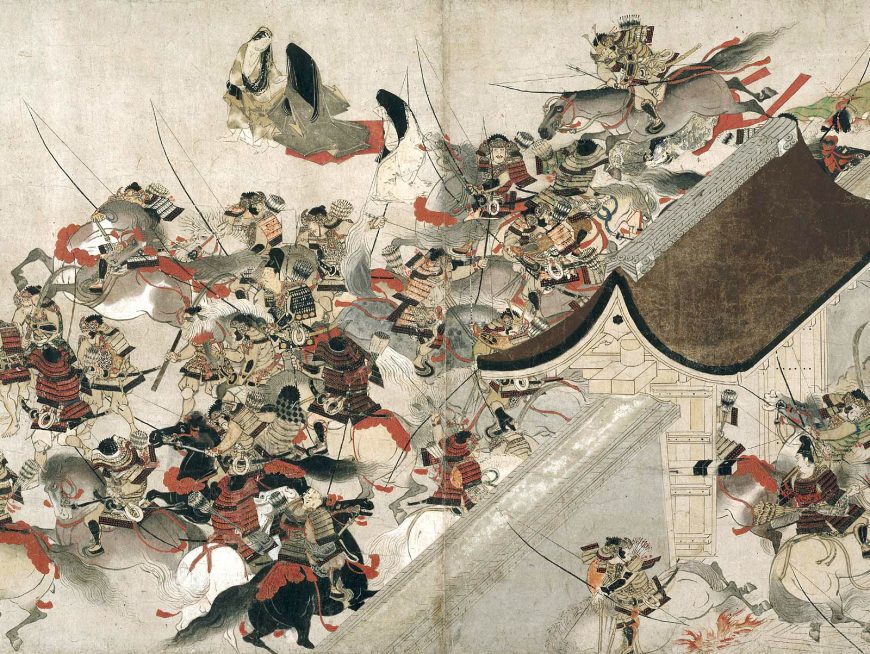
We see it knocked about with others in the crush of fighting at the palace wall, on the veranda where Nobuyori in colorful armor orders Go‐Shirakawa into it, and finally in the surge of departing victors where two soldiers lolling on top lending an air of indignity and insult to the monarch. Nobuyori, now in court robes and on horseback, appears in front, glancing back at the carriage. A mounted Minamoto Yoshitomo, distinguished by red armor and a distinctive horned helmet, appears twice—behind the carriage as it crashes onto the veranda, and brandishing a bow and arrow, cantering behind it in the departing crowd.
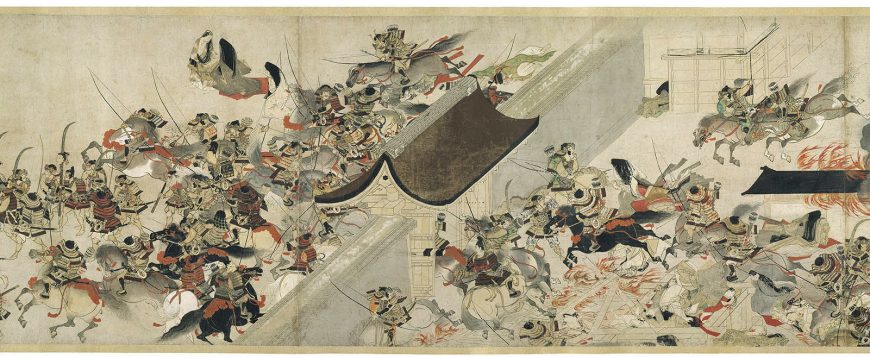
The remainder of the Heiji Rebellion story appeared on other emaki in the set, now mostly lost: the kidnapping of Emperor Nijô, the slaughter of another noble household, Nobuyori forcing Nijô to appoint him chancellor, Taira Kiyomori’s return to decimate the schemers, and finally Kiyomori’s mistake—banishing rather than executing several of Minamoto sons. Minamoto no Yoritomo and his brother Yoshitsune would return years later to destroy the Taira clan in the Gempei War and found the first of four military governments of the Shōgunate that ruled Japan from 1192 until 1867. Emperors and nobles remained in Kyoto, but were politically powerless. Feudal culture came to a violent end in 1868 at the hands of other samurai clans. They brought the young emperor Meiji into a new role as the monarch (really a figurehead) of a modern nation. Over the Meiji era’s early tumultuous decades many spectacular works of art left Japan to join important collections in the West. The Night Attack at Sanjô Palace, once owned by a powerful samurai family, came into the possession of an influential American who brought it home to Boston. It has been a highlight of the Museum of Fine Arts, Boston since 1889.
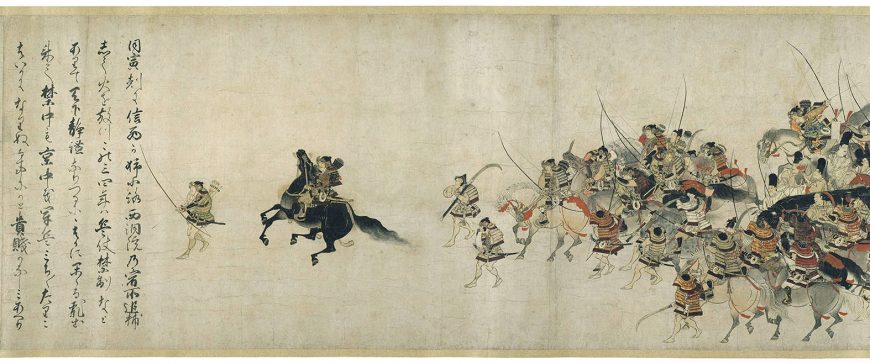
[1] Japanese surnames come first and given names come second. Fujiwara and Taira are surnames. The Chinese characters used have different pronunciations that can appear at different times. “Minamoto” can be “Genji;” “Taira” can be “Heike.”
Additional resources:
This Handscroll at the Museum of Fine Arts Boston
Interactive scroll, Bowdoin College
The scroll’s text:
At about the hour of the ox (2 am) on the ninth day, Lord Nobuyori proceeded with several hundred mounted soldiers to the Sanjō Palace, the residence of the Retired Emperor, and said, “Since I have heard that I am to be struck down, I intend to go to the east. I have served you close at hand for years and have been favored more than others by Your Majesty, and so it is indeed sad for me to part from my lord and abruptly leave the capital.”
Then the Retired Emperor said, “What sort of an affair is this? Who would strike you?” But without hearing him out, soldiers hastily brought up the Imperial carriage. “You must hasten into the Imperial carriage. Now, set fire to the Palace,” ordered Nobuyori, and His Majesty unwillingly got into the Imperial carriage. Jōsaimon’in had already gotten in. It was Lord Moronaka who had brought up the Imperial carriage. Nobuyori, Yoshitomo, Shigenari, the Sado Vice-Minister of Ceremonial, Minamoto Mitsumoto, the Commisioner of the Police, Suezane, the former Commisioner of Police, and the others surrounded the Imperial carriage and took it to the Imperial Palace. They shoved him into the Palace Single-Copy Library, where Shigenari and Mitsumoto guarded him.
Soldiers blockaded the Palace on all four sides and set fire to it. Those who fled out they shot or hacked to death. Many jumped into the wells, hoping that they might save themselves. The ladies-in-waiting of high and low rank and the girls of the women’s quarters, running out screaming and shouting, fell and lay prostrate, stepped on by the horses and trampled by the men. It was more than terrible. No one knows the number of persons who lost their lives.
Some said that Yoshitomo had raised a rebellion and had broken into the Sanjō Palace in a night attack and set it on fire and that even the Retired Emperor had not escaped the flames. Some also shouted that His Imperial Highness had gone to the Imperial Palace. Consequently, the “Great Lord” the Lord Chancellor, and all the other nobles and courtiers came in a crowd. the noise of their horses and carriages rushing back and forth was like thunder, and greatly did it resound both in heaven and on earth.
At the hour of the tiger (4 am) the same night, they seized the dwelling of the Shinzei at Anegakoji Nishinotoin and set fire to it. For the past three or four years arms had been banned, and the Empire had been at peace, but now suddenly this disturbance had broken out, and both the Imperial Palace and the capital were filled with soldiers. The noble and lowly lamented together, wondering what had happened.
Translation from Reischauer & Yamagiwa, Early Japanese Literature, Cambridge: Harvard University Press 1951, p. 451-453
Video \(\PageIndex{4}\)
Muromachi period
Named for a part of Kyoto, this period produced some of Japan's most treasured art and architecture.
1392 - 1573
Bamboo in the Four Seasons: painting and poetry in Japan
by DR. SONIA COMAN and DR. STEVEN ZUCKER
Video \(\PageIndex{5}\): Bamboo in the Four Seasons, attributed to Tosa Mistunobu, late 15th to early 16th century (Muromachi period), Japan, ink, color and gold leaf on paper, each screen 157 x 360 cm (The Metropolitan Museum of Art). Speakers: Sonia Coman and Steven Zucker
Smarthistory images for teaching and learning:
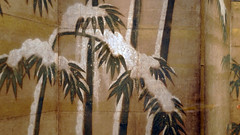
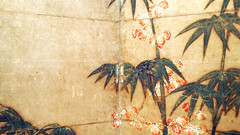

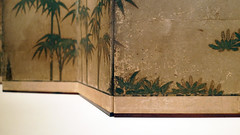
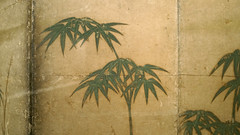
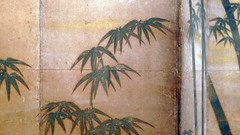
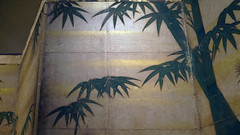
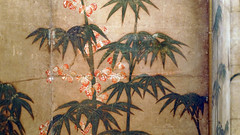
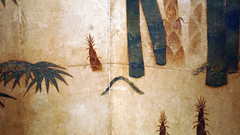
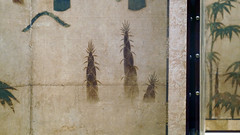
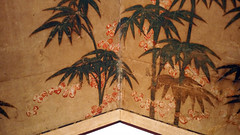
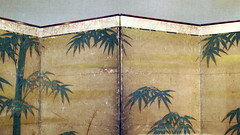
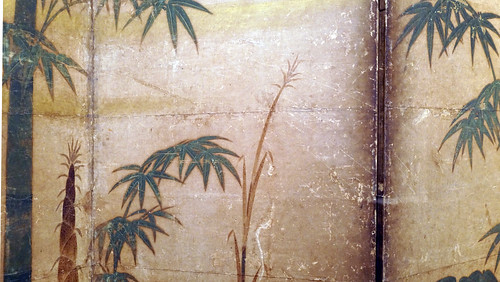
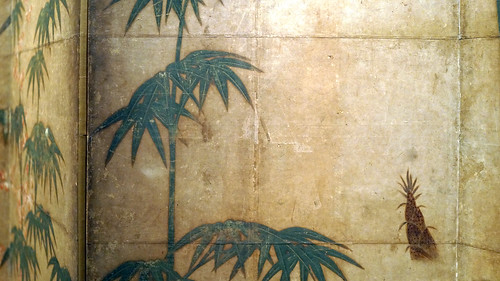
Ryōanji (Peaceful Dragon Temple)
Video \(\PageIndex{6}\): Speakers: Dr. Beth Harris and Dr. Steven Zucker
Zen Buddhism and the rock garden of Ryōanji
Ryōanji is a temple located in north Kyoto, Japan affiliated with a branch of Zen Buddhism. The followers of Zen Buddhism pursued “enlightenment” or “awakening” by means of self-introspection and personal experience in daily life. The quintessence and aesthetics of Zen is epitomized in the rock garden and architecture of Ryōanji.
Ryōanji thrived as a great Zen center for the cultural activities of the elite from the late sixteenth through the first half of the seventeenth century under the patronage of the Hosokawa family. The temple and its gardens are listed as one of the Historic Monuments of Ancient Kyoto. In the late 1990, the garden attracted over a million visitors annually and is regarded as an expression of Zen art and a symbol of Zen Buddhism and Japanese culture.

When visitors pass through main gate, they encounter the Mirror Pond (Kyōyōchi) on the left with a scenic view of surrounding mountains. Walking along the pilgrim’s path and entering the second gate, visitors arrive at the main building of the monastery, the hōjo (abbot’s residence). The rock garden is located in the front of the hojo and is viewed either from the wooden veranda embracing the building or from inside the room. What is Zen Buddhism?
Dry Landscape Garden (karesansui) in Ryōanji

The Ryōanji garden is the one of the most famous examples of a rock garden—a form which developed during the Muromachi period (1392-1573) with the efflorescence of Zen Buddhism in medieval Japan. This type of garden consists of rocks and pebbles rather than vegetation and water, and was mainly created on the grounds of temples for encouraging contemplation. White gravel often symbolizes flowing elements such as waterfalls, rivers, creeks, or sea, while rocks suggest islands, shores, or bridges.

The garden may have been inspired by aspects of both Japanese and Chinese culture. For instance, Shinto, an indigenous religion of Japan, focuses on the worship of deities in nature. Also, Zen Buddhism, which derived from Chan Buddhism in China, emphasizes meditation as a path toward enlightenment. Medieval Chinese landscape paintings associated with this sect of Buddhism often displayed a sparse, monochromatic style that reflected a spontaneous approach to enlightenment (see the example, left). Together, these concepts promoted the aesthetic values of rustic simplicity, spontaneity, and truth to materials that came to characterize Zen art. Today, the sea of gravel, rocks, and moss of the rock garden and the earthy tones of the clay walls contrast with the blossoming foliage beyond—evoking stillness and contemplation suitable for meditation.
Like other Japanese rock gardens, the Ryōanji garden presents stones surrounded by raked white gravel with a minimal use of plants. Fifteen rocks of different sizes are carefully arranged in groups amidst the raked pebbles covering a 250 square-meter rectangle of ground. The stones are carefully arranged so that one can only see no more than fourteen of the fifteen at once from any angle. Staring from the largest group on the far left, a visitor’s eyes rhythmically move through the garden from the front to the rear and back, and then from the front to the right upper corner.
The garden is located on the south side of the hōjō, the main building used for the abbot’s personal study and living quarters. The hōjō is divided into six rooms by sliding doors called fusuma; three rooms on the south (a reception, a lecture room and a meeting room) and those on the north (a study, a changing room and a central room consisting of three subdivisions of a serving chamber, alter, and sleeping room). The hōjō also includes gardens on each side of the building—a moss garden called the West Garden, a stone and moss garden, and a garden with a tea house.

Date? Creator?
Scholars debate the exact dating of the garden, but the consensus is that it was originally created in the fifteenth century and that its present design dates from the Edo period ( (1615–1868). The identity of the garden’s creator is also controversial, as no records of the rock garden can be found prior to the early 1680s. Early descriptions explain that the garden has nine big stones representing “tiger cubs crossing the water” and attribute the design to Matsumoto, the chief patron of Ryōanji, or Sōami, the connoisseur, painter, and garden designer attending the Ashikaga shogunate. An inscription carved on the back of one stone bears witness to the involvement of professional laborers in the garden’s architecture—the stone has two names, Kotaro and Hikojiro, who were known as sensui kawaramono (riverbank workers) belonging to the lower social strata. As the garden has fifteen stones today, it is certain that the arrangement we see now cannot be the same as the original medieval design (which had nine stones). Although it remains unclear who designed the garden, or what it originally looked like, it is evident that the Ryōanji garden has changed throughout time.
The meaning of the garden
Many different theories on the garden’s meaning have been suggested—some say it represents islands floating on an ocean, or a mother tiger carrying cubs over the sea, while others say it symbolizes the Japanese aesthetic concept of wabi (refined austerity) and sabi (subdued taste), or the fundamental ideal of Zen philosophy. A more recent theory argues that it is an expression of a pure form of abstract composition meant to incite meditation. Whether originally intended to represent pictorial images or symbolize metaphysical concepts, it is certain that the rustic austerity and minimalist rock garden at Ryōanji has played a significant role in art and architecture from medieval times to the present in Japan.
Art and architecture in Ryōanji

The fame of the stone garden at Ryōanji is so imposing that it has overwhelmed the other parts of the temple, including Kyōyōchi (Mirror Pond, located in the lower part of the site), a small west garden, and a rear garden with a teahouse. The Mirror Pond is reminiscent of courtly gardens from the Heian period (794 to 1185), while the teahouse and garden date back to the seventh century. Near the teahouse is a famous stone water basin.

The wall door paintings that once decorated the hōjō are preserved today in Japanese and overseas collections. Among them, two large panels depicting “Chinese Immortals” and the “Four Elegant Accomplishments” (above) belonged to Ryōanji’s main hall and once faced its rock garden. They were removed from Ryōanji and sold in 1895, when Buddhism was persecuted during the new Meiji regime. These works entered the collection of the Metropolitan Museum of Art in 1989. Contrary to the austere monochrome ink paintings of landscapes and bird-and-flower paintings decorating the abbot’s quarters in Zen temples dating from the Muromachi period, they depict Chinese narrative themes rendered with extravagant colors on golden backgrounds. This permits a glimpse into a radical shift in the interior program of the Zen monastery during the late Momoyama and early Edo periods, led by the rise of samurai warlords as prominent patrons of art and formidable political entities.

Ryōanji and Zen culture in the modern era
Recent scholars criticize the romanticized notion of Zen art and culture as a symbol of Japanese aesthetic—pointing out that this interpretation is largely a product of the twentieth century, fueled by growing nationalism in Japan.
Furthermore, Zen Buddhism was disseminated in the West and filtered through modernist artists, who were fascinated by the minimalistic perspectives and abstracted forms of Japanese rock gardens. Whatever the skepticism one reserves for existing assumptions about the Zen garden and culture, no one can deny the cultural and historical significance of Ryōanji and its rock garden.
Additional resources:
Historic Monuments of Ancient Kyoto (Kyoto, Uji and Otsu Cities) video from UNESCO
History of Gardens in East Asia: Online Resources (Bard Graduate Center)
François Berthier and Graham Parkes, Reading Zen in the Rocks: the Japanese Dry Landscape Garden (Chicago, Ill: University of Chicago Press, 2000).
Kendall H. Brown and David M. Cobb, Quiet Beauty: Japanese Gardens of North America (Tokyo: Tuttle Publishing, 2013).
Wybe Kuitert, Themes in the History of Japanese Garden Art (Honolulu: University of Hawai’i Press, 2002).
Hiroshi Onish, “Immortals and Sages: Paintings from Ryoanji Temple,” The Metropolitan Museum of Art Bulletin, v. 51, no. 1 (Summer, 1993).
Smarthistory images for teaching and learning:
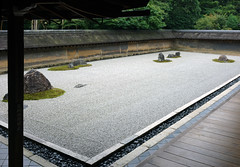
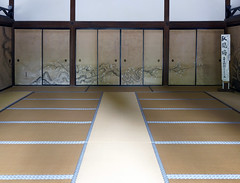
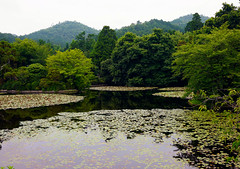
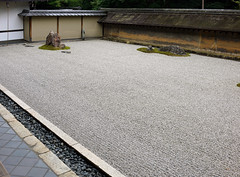
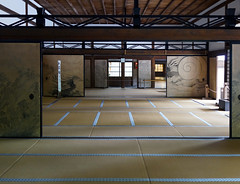
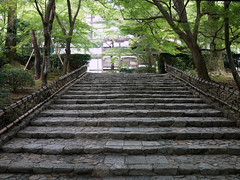

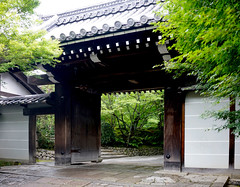
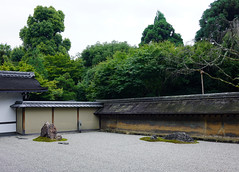
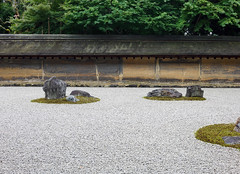

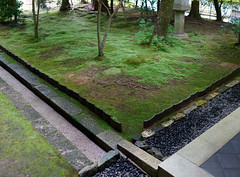
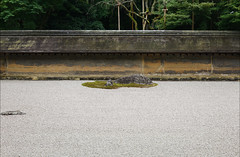

Muromachi to Momoyama period Negoro ware ewer
by DR. MARIBETH GRAYBILL and DR. STEVEN ZUCKER
Video \(\PageIndex{7}\): Negoro ware ewer, Negoro workshop, Muromachi period (1392-1573) to Momoyama period (1573-1615) second half of 16th century, lacquered wood, Wakayama prefecture, Japan (Portland Art Museum). This video was produced in cooperation with Portland Art Museum.
Smarthistory images for teaching and learning:

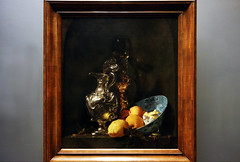
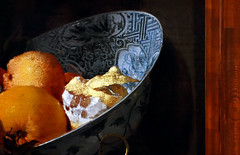
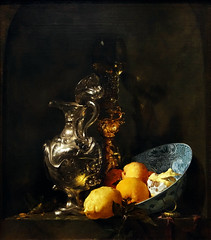
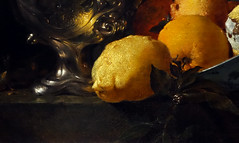

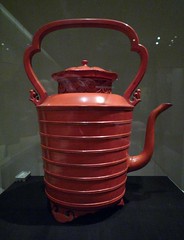
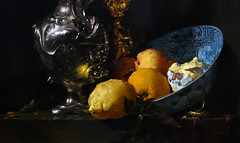
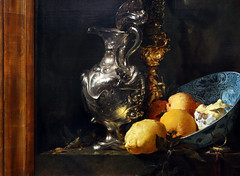
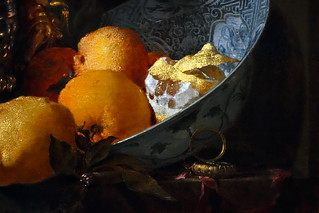
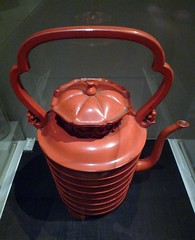
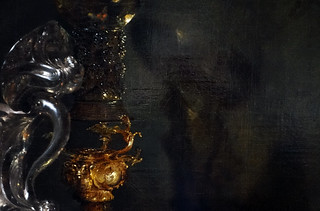
Edo period
Strict feudal rule and a rising middle class characterizes this period.
1615 - 1868
A portrait of St. Francis Xavier and Christianity in Japan

A Discovery in Takatsuki
In 1920, researchers from the Kyoto Imperial University in Japan made a miraculous discovery. They found a locked chest—seemingly unopened for centuries—tied to a beam in the ceiling of an old house. When they opened it, they discovered a small collection of Christian artworks and texts. These were rare survivors from the European missions that sought to convert the Japanese people (who traditionally practiced Shinto and Buddhism) to Catholicism. This effort dramatically came to an end in 1614 when the Tokugawa government outlawed Christianity and expelled all European missionaries.
The two paintings in the chest—likely created by unknown Japanese-Christian artists—depicted the Fifteen Mysteries of the Rosary and St. Francis Xavier, the first Catholic missionary in Japan and a member of the Society of Jesus. Unfortunately, the box contained no documentary records that could tell us when this image of Francis Xavier was created, where or who it was made for, or how it was used. Although many of the basic facts about the painting remain the subject of debate, it is clear that the painting is an invaluable record of cultural, religious, and artistic interaction between Europe and Japan in the early modern period.
Members of the Society of Jesus are called the Jesuits. They are a Roman Catholic religious order founded during the 16th century.
The Failed Mission to Japan
In July 1549, Francis Xavier arrived in Japan, hoping to find success converting the Japanese to Christianity. Xavier initially struggled due to his lack of knowledge of the Japanese language and his inaccurate understanding of Japanese Buddhism. Still, he laid the foundation for a successful mission that continued to grow after he left Japan to return to India two years later. Scholars have estimated that more than 300,000 people in Japan converted to Christianity over the next fifty years. However, this brief Christian experiment ended in 1614 when the Tokugawa government outlawed the religion, beginning a period of persecution that resulted in the torture and execution of more than a thousand Japanese Christians and European missionaries. At this time, all Christian churches that had been built in Japan were destroyed, along with the works of art that had decorated them.
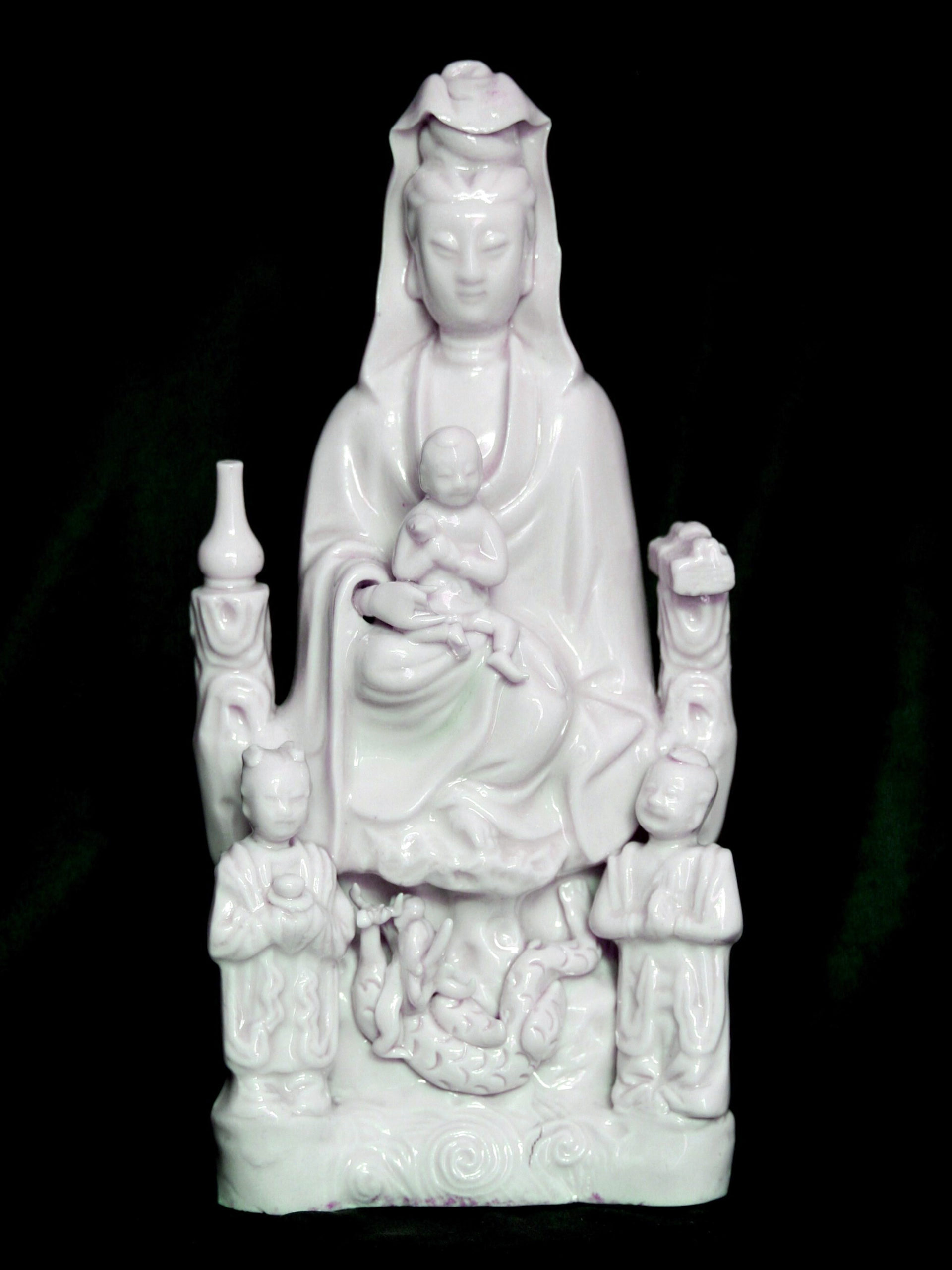
A sizeable portion of these Christians managed to continue to practice their faith despite the constant danger of detection by government officials. Christian works of art played an important role in helping them maintain their devotional practices, and create a sense of religious community and identity. For example, statues of the bodhisattva Kannon in a feminine form holding a child (such as the one above) appeared Buddhist on the surface, but due to similarities in iconography, could be regarded as images of the Virgin and Child by secret Christians. Devotional images with obvious Christian iconography that had no Buddhist counterpart, such as the Kobe painting of St. Francis Xavier, were more dangerous. In many cases, they had to be hidden away.
Satis est, Domine, satis est
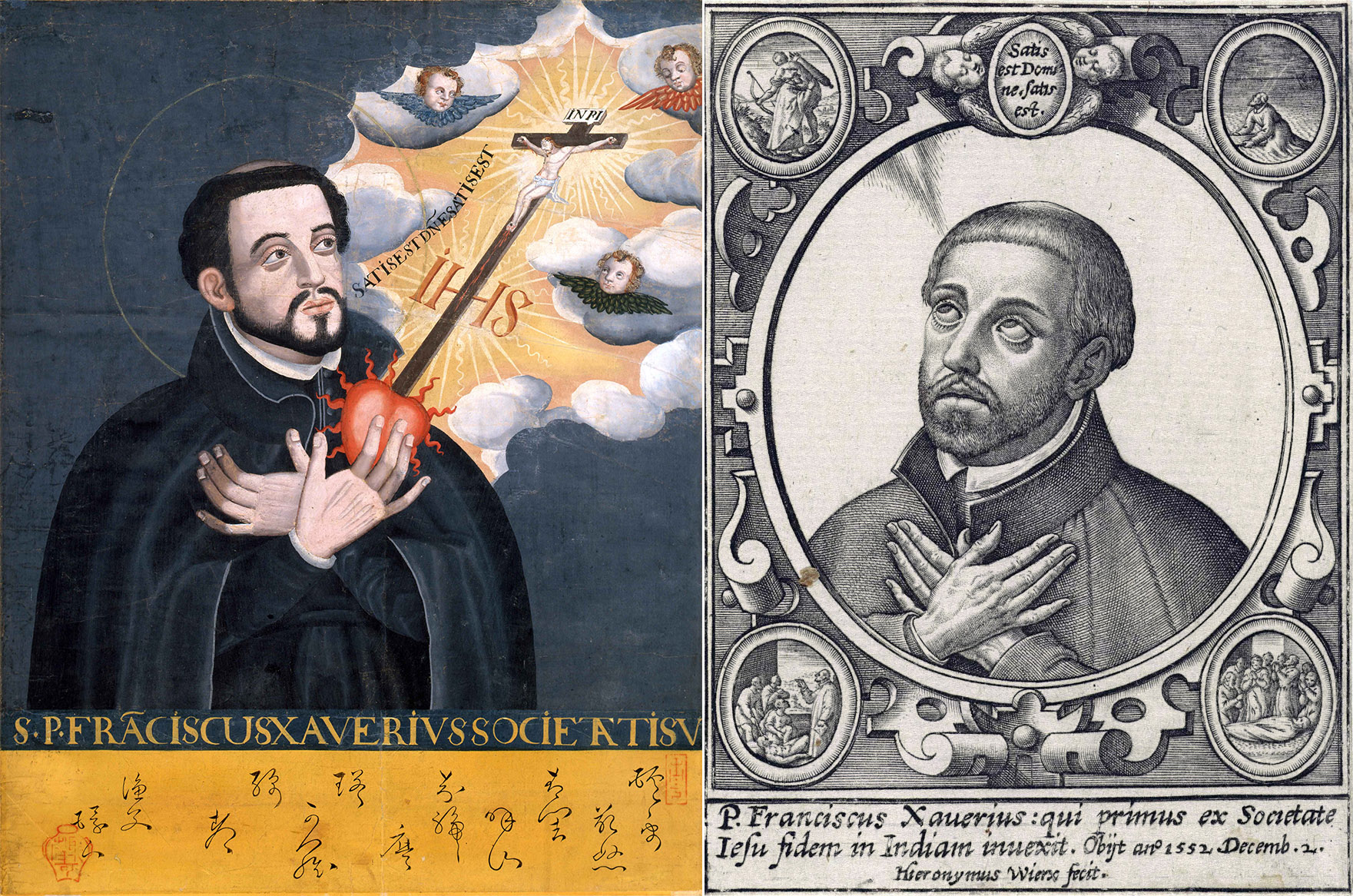
The Kobe painting of St. Francis Xavier is undeniably a product of both Japanese and European visual culture. The materials are Japanese, but the artist demonstrates some familiarity with European pictorial techniques like modeling in light and shade. The artist has also based the composition on prints of Xavier, such as those by Flemish printmakers Theodoor Galle and Hieronymus Wierix. European prints were sent to overseas missions to instruct converts in their new faith and also served as source material for non-European artists. They were a common means by which artistic knowledge circulated throughout the early modern world.

The Kobe painting of Xavier follows the basic format of the Wierix and Galle prints by depicting the saint from the waist up in a three-quarter pose. His physical appearance is consistent with textual descriptions written by those who knew him in life. These accounts stress his light complexion, beard, dark hair, and eyes always uplifted towards heaven. In his left hand, he holds a flaming heart from which a crucifix emerges. In the upper right portion of the painting, the background, a neutral dark blue field in most of the painting, transforms into dark clouds that part to reveal a golden aura that surrounds the crucifix.
Emerging from Xavier’s mouth is the Latin phrase “Satis est, Domine, satis est,” meaning “It is enough, O Lord, it is enough.” Many sources record that Xavier, when he thought no one was observing him, would open his cassock to try to cool his burning heart and would utter this phrase, marveling at the generous consolations God had sent him.
A cassock is an ankle-length garment worn by members of the clergy in the Catholic or Anglican Church.
Below the image of Xavier is an inscription in Latin identifying him as a saint and a member of the Society of Jesus. His name is repeated once more, in the bottom-most portion of the painting, where Chinese characters are used to write out the words “St. Francis Xavier Sacrament” phonetically. The painting is also signed “Gyofu Kanjin,” a confusing signature that is not really a name, but instead translates to “fisherman.”

The only other clue to the artist’s identity is a red seal in the lower left portion of the painting, shaped like a pot. This is the seal of the Kanō school, a painting workshop that dominated the artistic scene of the Tokugawa period. One scholar has hypothesized that the Kobe portrait of Francis Xavier was painted by a Japanese artist who had initially trained with the Kanō, but then converted to Christianity and became a priest. This might explain the signature on the portrait, which refers to the artist as a “fisherman” perhaps meaning a “fisher of men.” [1] For the time being, however, this remains speculation.
Japanese Devotion to St. Francis Xavier
Early modern Japanese Christians were especially devoted to Xavier since he had been the first Catholic missionary to bring knowledge of the Gospel to Japan and had supposedly worked several miracles in the Japanese islands. One of the most prominent Xavierian devotees was Ōtomo Yoshishige, a sixteenth-century daimyo who, after his baptism, had taken the Christian name Francisco in honor of Xavier. In 1585, he wrote a letter to Rome asking that Xavier be canonized, so that Japanese Christians could build churches dedicated to Xavier, set up images depicting him on altars, celebrate his Mass, and pray to him for intercession. We know nothing about where the Kobe painting of Xavier was originally displayed, but if it was painted before the prohibition against Christianity, it is possible that it would have been put up in a church on an altar. One scholar has proposed that it was publicly displayed in the Jesuit church in Kyoto and later taken to Takatsuki to be concealed after Christianity was prohibited.[2] Like most things related to the Kobe St. Francis painting, this is just an educated guess.
A daimyo is a Japanese feudal lord.
We do have a few scattered mentions of other images of St. Francis Xavier in letters written by the Jesuit missionaries who remained in hiding in Japan after the 1614 prohibition. A 1625 letter written by a Jesuit who managed to evade the authorities mentions that he brought an image of St. Francis Xavier to a group of hidden Christians in Yamaguchi. These brief, but tantalizing, references demonstrate that although its survival was extraordinary, the painting of Francis Xavier itself was not unique. At the time it was created, it was but one example of the vibrant visual and material culture of Japanese Christianity that celebrated Francis Xavier, the “Apostle of Japan” whose mission had inaugurated the Japanese Catholic Church.
Notes
[1] Grace Vlam, “The Portrait of S. Francis Xavier in Kobe,” Zeitschrift für Kunstgeschichte 42, no. 1 (1979): pp. 48-60.
[2] Vlam, “The Portrait of S. Francis Xavier in Kobe,” pp. 48-60.
Additional Resources
Read more about the Tokugawa period in Japan on Smarthistory
Read more about printmakers like Theodoor Galle on Smarthistory
Read more about the Kobe City Museum in Japan
Gauvin Alexander Bailey, Art on the Jesuit Missions in Asia and Latin America (Toronto: University of Toronto Press, 1999).
Andrew C. Ross, A Vision Betrayed: The Jesuits in Japan and China, 1542–1742 (Maryknoll, NY: Orbic Books, 1994).
Junhyoung Michael Shin, “Avalokiteśvara’s Manifestation as the Virgin Mary: The Jesuit Adaptation and the Visual Conflation in Japanese Catholicism after 1614,” Church History 80, no. 1 (2011): 1-39.
Grace Vlam, “The Portrait of S. Francis Xavier in Kobe,” Zeitschrift für Kunstgeschichte 42, no. 1 (1979): 48-60.
Ogata Kōrin, Red and White Plum Blossoms

A landscape transformed
In Red and White Plum Blossoms, Ogata Kôrin transforms a very simple landscape theme—two flowering trees on either side of a brook—into a dream vision. Executed in black ink and blotchy washes of gem-like mineral color on a pair of folding screens, the image seems both abstract and realistic at the same time. Its background, a subtle grid of gold leaf, denies any sense of place or time and imbues everything with an ethereal glow. The stream’s swelling metallic curls and spirals are a make-believe of flowing water, and its sharply tapered serpentine contour lines angle the picture plane in an unnatural upward tilt. The trunks of the trees are nothing more than pools of mottled color without so much as an outline. These forms and spaces appear flat to the eye. Yet the artist’s intimate knowledge of how a plum tree grows can be seen in their writhing forms and tangle of shoots and branches.

Enveloping us in spring
In planning its imagery Kôrin closely considered the function of the folding screen within the traditional Japanese interior. The two sections would have been positioned separately yet near enough to each other to define an enclosed space. At 156 cm (or approximately 67 inches) in height, they towered over the average Japanese person of the day. Kôrin depicted only the lower parts of the trees, as if viewed from very near: the tree with red blossoms thrusts upward from the ground and out of sight; the white pushes leftward out of view and then, two slender branches appear to spring back diagonally downward from the top corner and jab upward. With each screen standing hinged at its central fold, a viewer experiences these exaggerated two-dimensional images in three dimensions. Stopping us in our tracks by confounding logic with this combination of pure design and intimate naturalism, Kôrin envelops us in the pulsing vitality of early spring.
Rinpa, or “School of Kôrin”
An acknowledged masterpiece painted toward the end of his life, Red and White Plum Blossoms exemplifies a style that for many epitomizes Japanese art. It has profoundly impacted modernism in the West, most famously in the work of Gustav Klimt. Since the 19th century this combination of abstraction and naturalism, monumental presence, dynamism and gorgeous sensuality has commonly been referred to as Rinpa, or “School of Kôrin.” But Kôrin neither originated this aesthetic, nor presided over a formal school; more accurately he stood at the forefront of a loose movement of like-minded artists and designers in various media. Rinpa first appeared a century earlier, in the brilliant relationship of a gifted calligrapher, connoisseur, and intellectual named Hon’ami Kôetsu, and an equally gifted painter of fans and screens, Tarawaya Sôtatsu, who created works that aimed to satisfy the luxurious tastes of 17th century Kyoto’s aristocrats and wealthy merchants (below).

Entranced by a few of Sôtatsu’s paintings that he saw in the collection of a patron, Kôrin taught himself the techniques: images pared to bare essentials and then dramatically magnified, emphasis on the interplay of forms, colors, and textures, and unconventional adaptations of ink painting methods. These methods included tarashikomi, or dilute washes of color blended while very wet, and mokkotsu, or “bonelessness,” which creates forms without exterior outlines. Some scholars now use terms such as Sôtatsu-Kôrinha, Kôetsuha, and Kôetsu-Kôrinha rather than Rinpa, in recognition of its actual origins. Yet Kôrin is owed a great debt as the one who revived a dazzling creative approach from obscurity and whose vibrant works firmly established his own reputation.

A profligate who squandered his family’s enormous wealth, Kôrin benefitted from the wide design experience afforded by its position as one of Kyoto’s most distinguished producers and purveyors of fine textiles. This he combined with painting studies in one of Japan’s preeminent studios. His numerous works in this sophisticated style thus encompass many media, formats and subjects—paintings in color and ink on large screens, small albums, fans, hanging and hand scrolls, printed books, lacquers, ceramics and even textiles.
Initially inspired by Japanese classical literature, the Rinpa movement’s attention soon extended to themes from nature, including Chinese motifs that may have influenced Kôrin’s choice of plum trees for this painting. Looking now at the impact of his work from over three centuries ago, it seems incredible that a vision so dramatic, luxurious and radical could ever have fallen into obscurity.
Additional resources:
Rinpa Painting Style on the Metropolitan Museum of Art’s Heilbrunn Timeline of Art History
Utagawa Kunisada I, Visiting Komachi, from the series Modern Beauties as the Seven Komachi

Wearing a striped outer robe over her kimono, a young woman lingers near an empty carriage, her hand delicately touching its roof. The green of the carriage (in this case, actually a litter) matches the color of the woman’s kimono, suggesting a link between the person and the vehicle. The outer robe and headscarf indicate that the scene must occur in cold weather. What we are seeing, then, is perhaps a woman who left her house to take a look at her carriage. But why is she looking at it? And why is her expression downcast, even despondent?
A litter is a wheelless, human-powered vehicle.
Pictures of the floating world
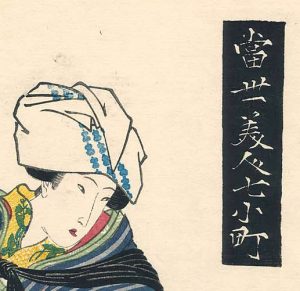
From the title of this print by ukiyo-e master Utagawa Kunisada I, written in white characters on a black background in the top right corner, we learn that the image is one of a series of seven depictions of contemporaneous women (literally, “modern beauties” or tōsei bijin).
The genre of ukiyo-e (literally translatable as “pictures of the floating world”) comprises paintings and prints, though woodblock prints were its main medium. It flourished in the 18th and 19th centuries, supported by Japan’s middle class. Ukiyo-e works were collaborations between painters, publishers, carvers, and printers, with subject matter drawn from the transitory (thus “floating”), but enjoyable worlds of pleasure quarters, the popular theater, and urban life, especially the streets of Edo. Ukiyo-e also featured parodies of classical themes set in contemporaneous circumstances.
Edo, which was renamed Tokyo in 1868, was the most powerful city in Japan from the seventeenth to the nineteenth century.
A legendary poetess
Here, Kunisada, the artist, represents a modern beauty in the guise of ninth-century poetess Ono no Komachi, the only woman amongst the “six poetry immortals” (rokkasen). Each scene in Kunisada’s “Seven Komachi” series relates a story or anecdote associated with Komachi’s life.
The “six poetry immortals” was an idea introduced in the tenth century in one of Japan’s most influential imperial poetry anthologies, the Kokin Wakashū.
In this print, the empty carriage helps us identify that the specific story being illustrated, out of the aforementioned seven, is the one known as “Visiting Komachi” (Kayoi Komachi). According to legend, Komachi, renowned for her beauty and talent, attracted the attention of many suitors, including General Fukakusa, who sought to become her lover. Komachi tested his devotion by asking him to spend 100 nights outside her door, in the garden, irrespective of weather conditions. He agreed and marked each night on the shaft of her carriage, but died on the last night because of the harsh winter. The scene illustrated in Kunisada’s print may be from the very end of the story, when Komachi learns about his death and goes to see the carriage. Other versions of this story circulated orally in Japan over the centuries, and some were used as plotlines for plays in the Japanese Noh tradition of musical drama.
Dating from the Muromachi period (the fourteenth century), Noh is a traditional form of dramatic performance that combines music, spoken word, ritualized movement, elaborate costumes, and character-specific masks, performed on a bare stage that includes a bridge-like passageway. Noh plays featured narratives about gods, famed warriors, elegant women, madwomen, and supernatural creatures, many of which were derived from classical literature.
This image leaves it to the viewer to imagine the inner life of the heroine. Is she remorseful? Is she mourning? However, the print’s title reminds us that the depicted woman is not actually Komachi herself, but someone else, from a later era, who is enacting the role of the poetess. The image refers to the “Visiting Komachi” story through her accoutrements and props (especially the carriage as a stand-in for the missing lover). Considering the multilayered aspect of the subject matter, the gaze of the depicted woman may actually suggest that she is engrossed in thinking about the real Komachi. In providing these references to a larger cultural tradition, Kunisada adds conceptual depth to his portrayal of a beautiful woman.
Pictures within pictures, stories within stories
The artifice of the image is further complicated by the inclusion of a cartouche, or image-within-image (known as gachūga). The gachūga functions like a legend for the “main” image, depicting the “real” Komachi, also clad in outerwear, as well as a poem attributed to her. The choice of color for her outer robe— the same green as the carriage and as the kimono of the “modern beauty”—weaves the two images together and creates a visual rhyme between the historical Komachi and the contemporaneous Komachi. This visual link illustrates the process of channeling the spirit of the poetess.
Placed in the top left corner of the print and framed with floral motifs, the gachūga provides access to another visual realm and calls into question the nature of the space behind the central figure. Is this image-within-image floating in space, as it were, or is it a flat picture affixed to a wall-like surface behind the centrally positioned woman? This ambiguous spatial quality of the image-within-image contributes to the overall richness of the print’s visual message.
A ghostly presence
This form of communication could have also indicated a supernatural dimension, considering the frequent inclusion, in Noh drama, of ghost characters, many of which became subject matter for paintings, prints, and ceramic and lacquer decoration. In the case of Komachi, the ghost character was especially popular because of stories that contrasted her beauty as a young woman with her decaying image in old age; other stories described her as a cold-hearted woman (or “femme fatale”). These characterizations set the stage for plots where Komachi’s ghost returned to the world to act on her inner conflicts. In this print, the inclusion of an image of Komachi and of a woman in the guise of Komachi calls to mind the spectral presence of this legendary character and its plotlines from Noh drama.
In the image-within-image, the figure of Komachi is framed by a waka poem attributed to her. It reads:
iro miede / 色みへて
utsurou mono wa / うつろふものは
yo no naka no / 世の中の
hito no kokoro no / 人のこゝろの
hana ni zo arikeri / 花にぞありけり
I propose the following prose translation as one way of interpreting these lines: “It is by their changing colors that we know the flowers of men’s hearts to fade in this transient world.”
Republished in collections of ancient poems and paired with images of Komachi herself, as in this print, the poem speaks to the connection between the ephemerality of outer appearances and the changes that characterize matters of the heart. This poetic message is at the core of what Komachi came to signify over the centuries in Japanese literary and visual culture.
Layers of legend
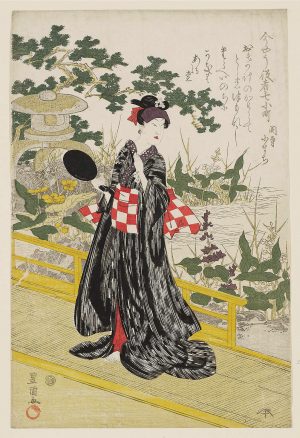
The other stories in the “Seven Komachi” series resonate with this poetic message, too. For example, “Sekidera Komachi ” invokes a story according to which an aged Komachi forgets about her fading beauty by dancing with a child on the occasion of the stars festival (Tanabata). The episode serves as a reminder of the ephemeral and cyclical nature of life, and it was also used by multiple artists, including Kunisada, as a pretext for depicting beautiful women in guise of the poetess.
With no historical evidence to prove the accuracy of any of these narratives, the poems, plays, and images representing Ono no Komachi merged in the Japanese collective imagination, to form a composite legendary character. The Komachi motif occasioned visual representations that playfully combined it with contemporaneous elements, as is the case with Kunisada’s Kayoi Komachi print.
Kunisada’s series is only one of several ukiyo-e series that use Komachi-associated stories in conjunction with some aspect of contemporaneous life and society (for instance, courtesans in guise of Komachi, young theater actors in the role of Komachi, or pairs of beautiful women in landscapes that evoke the seven stories). Such images spanned multiple centuries and media, from folding screens to painted shells to lacquer boxes, epitomizing the wide circulation of staple motifs and the intimate connection between literature and the visual arts in Japanese culture.
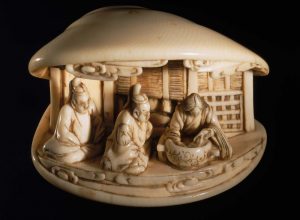
Additional Resources:
This work at the Museum of Fine Arts, Boston
Japanese woodblock prints at Ukiyo-e.org
Other prints in Kunisada’s Modern Beauties as the Seven Komachi series
Biography of Utagawa Kunisada I (Toyokuni III)
Example of another version of the “Visiting Komachi” story
Example of another visual representation of the Kayoi Komachi episode by Suzuki Harunobu
A lacquer inkstone box featuring the Komachi motif
A resource on Noh drama, including synopsis of Komachi-themed play
Hokusai
Hokusai, Under the Wave off Kanagawa (The Great Wave)

Katsushika Hokusai’s Under the Wave off Kanagawa, also called The Great Wave has became one of the most famous works of art in the world—and debatably the most iconic work of Japanese art. Initially, thousands of copies of this print were quickly produced and sold cheaply. Despite the fact that it was created at a time when Japanese trade was heavily restricted, Hokusai’s print displays the influence of Dutch art, and proved to be inspirational for many artists working in Europe later in the nineteenth century.

Under the Wave off Kanagawa is part of a series of prints titled Thirty-six views of Mount Fuji, which Hokusai made between 1830 and 1833. It is a polychrome (multi-colored) woodblock print, made of ink and color on paper that is approximately 10 x 14 inches. All of the images in the series feature a glimpse of the mountain, but as you can see from this example, Mount Fuji does not always dominate the frame. Instead, here, the foreground is filled with a massive cresting wave. The threatening wave is pictured just moments before crashing down on to three fishing boats below. Under the Wave off Kanagawa is full of visual play. The mountain, made tiny by the use of perspective, appears as if it too will be swallowed up by the wave. Hokusai’s optical play can also be lighthearted, and the spray from top of the crashing wave looks like snow falling on the mountain.

Hokusai has arranged the composition to frame Mount Fuji. The curves of the wave and hull of one boat dip down just low enough to allow the base of Mount Fuji to be visible, and the white top of the great wave creates a diagonal line that leads the viewers eye directly to the peak of the mountain top.
Across the thirty-six prints that constitute this series, Hokusai varies his representation of the mountain. In other prints the mountain fills the composition, or is reduced to a small detail in the background of bustling city life.
Hokusai was born in 1760 in Edo (now Tokyo), Japan. During the artist’s lifetime he went by many different names; he began calling himself Hokusai in 1797. Hokusai discovered Western prints that came to Japan by way of Dutch trade. From the Dutch artwork Hokusai became interested in linear perspective. Subsequently, Hokusai created a Japanese variant of linear perspective. The influence of Dutch art can also be seen in the use of a low horizon line and the distinctive European color, Prussian blue.
Hokusai was interested in oblique angles, contrasts of near and far, and contrasts of manmade and the natural. These can be seen in Under the Wave off Kanagawa through the juxtaposition of the large wave in the foreground which dwarfs the small mountain in the distance, as well as the inclusion of the men and boats amidst the powerful waves.

Mount Fuji is the highest mountain in Japan and has long been considered sacred. Hokusai is often described as having a personal fascination with the mountain, which sparked his interest in making this series. However, he was also responding to a boom in domestic travel and the corresponding market for images of Mount Fuji. Japanese woodblock prints were often purchased as souvenirs. The original audience for Hokusai’s prints was ordinary townspeople who were followers of the “Fuji cult” and made pilgrimages to climb the mountain, or tourists visiting the new capital city. Although the skyscrapers in Tokyo obscure the view of Mount Fuji today, for Hokusai’s audience the peak of the mountain would have been visible across the city.
Ukiyo-e is the name for Japanese woodblock prints made during the Edo Period. Ukiyo-e, which originated as a Buddhist term, means “floating world” and refers to the impermanence of the world. The earliest prints were made in only black and white, but later, as is evident from Hokusai’s work, additional colors were added. A separate block of wood was used for each color. Each print is made with a final overlay of black line, which helps to break up the flat colors. Ukiyo-e prints are recognizable for their emphasis on line and pure, bright color, as well as their ability to distill form down to the minimum.
Hokusai moved away from the tradition of making images of courtesans and actors, which was the customary subject of ukiyo-e prints. Instead, his work focused on the daily life of Japanese people from a variety of social levels. Such as the quotidian scene of fishermen battling the sea off the coast of Mount Fuji that we see in The Great Wave. This change of subject matter was a breakthrough in both ukiyo-e prints and in Hokusai’s career.
Beginning in 1640, Japan was largely closed off to the world and only limited interaction with China and Holland was allowed. This changed in the 1850s, when trade was forced open by American naval commodore, Matthew C. Perry. After this, there was a flood of Japanese visual culture into the West. At the 1867 International Exposition in Paris, Hokusai’s work was on view at the Japanese pavilion. This was the first introduction of Japanese culture to mass audiences in the West, and a craze for collecting art called Japonisme ensued. Additionally, Impressionist artists in Paris, such as Claude Monet, were great fans of Japanese prints. The flattening of space, an interest in atmospheric conditions, and the impermanence of modern city life—all visible in Hokusai’s prints—both reaffirmed their own artistic interests and inspired many future works of art.
This print at The Metropolitan Museum of Art
Ukiyo-e Techniques
Japanese woodblock print search
The Floating World of Ukiyo-e, a Library of Congress exhibition site
Beyond the Great Wave — Hokusai at 90
by DR. FRANK FELTENS, FREER GALLERY OF ART and DR. BETH HARRIS
A fisherman and a woodcutter — at age 90, the great Japanese artist Hokusai painted these moving images of contentment.
Video \(\PageIndex{8}\): A conversation with Dr. Frank Feltens, The Japan Foundation Assistant Curator of Japanese Art, Freer Gallery of Art and Dr. Beth Harris, in front of Katsushika Hokusai, Fisherman, 1849, ink and color on silk, 113 x 39.6 cm and Woodcutter, 1849, ink and color on silk, 113.6 × 39.6 cm (Freer Gallery of Art and Arthur M. Sackler Gallery, Smithsonian Institution, gift of Charles Lang Freer in 1920, F1904.181 and 1904.182)
These paintings at the Freer Gallery of Art (the Fisherman and the Woodcutter)
Upcoming exhibition at the Freer Gallery of Art: Hokusai: Mad about Painting
20th century
Mariko Mori, Pure Land
Floating on a lotus blossom
Set within a golden landscape, a female figure serenely floats above a lotus blossom while six alien musicians whirl by on bubbly clouds. Her pink robes mirror the predominantly pale orange, yellow and pink of the water, land and sky—firmly embedding her within the tranquil scene. Pure Land, a photograph set within glass, is the counterpart of Mori’s three-dimensional video installation, Nirvana, 1997. Nirvana animates the imagery we see in Pure Land. Viewed within a darkened room with the aid of three-dimensional glasses, Nirvana’s audience was limited to a group of 20 people at a time. During the seven minute video, the central female figure would hum and whisper echoed rhythms as if meditating, while the little musicians floated around her. At the conclusion, a fan came on and blew cool, scented air into the audience’s faces. Through the integration of sensory elements such as three-dimensional imagery, sound, scent, and the gentle touch of a breeze, combined with the limited viewing audience, Nirvana created an immersive, intimate experience. As its photographic counterpart, Pure Land captures a moment of this experience, enabling the viewer a longer, perhaps more meditative, relationship with the work.
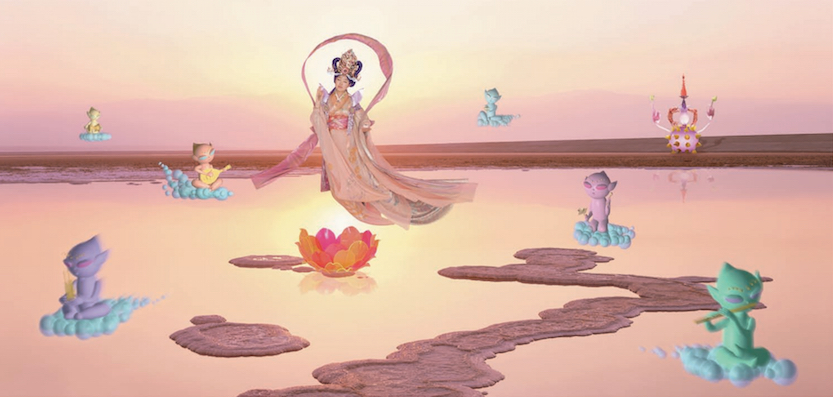

Symbolism and spiritual allusions
Every element we see here has significance that may not be apparent at first glance—the serene landscape, with its golden sky, smooth pink land masses, and perfectly still water, is rich with symbolism. Pure Land is set during sunrise in the landscape of the Dead Sea, the lowest point on earth, called “dead” because the high salinity of its water does not support fish or plant life. In Shinto tradition, salt is used as an agent of purification. Floating in the water is a lotus blossom—symbol of purity and rebirth into paradise. This blossom resembles one in Mori’s 1998 sculptural installation, Enlightenment Capsule (left), which featured a rainbow-colored acrylic lotus blossom set within a space-age capsule illuminated by sunlight. In both Enlightenment Capsule and Pure Land Mori blends traditional symbolism with futuristic elements. On the right hand side of the background of Pure Landis a fantastical object which resembles a playful futuristic spacecraft with arms. This may be a variation of a Tibetan stupa—a sacred Buddhist monument originally used as a burial mound. Through her imaginative reinterpretation of symbols steeped in tradition, the artist creates a timeless setting appropriate for meditation on death, purification, and rebirth.
Immersion
The distant horizon line, combined with the larger island in the foreground that seems to continue into the viewer’s space, create a sense of immersion, as if one were present with these fantastical figures. Perhaps this feeling of personal involvement ties in with the title itself, Pure Land, which is the paradise of Amida (or Amitabha) Buddha who descends to greet devotees at the moment of their death and takes them back to his “Pure Land of Perfect Bliss.”

Beginning with the eleventh century in Japan, several paintings and sculptures were made on this theme, such as the Descent of Amida and the Heavenly Multitude (above). In this type of imagery, Amida Buddha, resting on a lotus blossom and holding his hands in a symbolic gesture known as a mudra, is typically surrounded by celestial attendants in a sea of swirling clouds. These attendants are boddhisattvas, enlightened beings who act out of great compassion to help others achieve enlightenment. In a sculptural example from Byodo-in Temple, 52 boddhisattvas fly on clouds on either side of Amida Buddha (below); some are seated quietly with their hands joined in prayer, some hold a lotus blossom to receive the soul of the deceased, while others are playing musical instruments.

Oneness and universality

In Mori’s version, these celestial attendants are pastel-colored alien figures with large pointy heads and delicate bodies. Each figure plays a different instrument as they float on their light blue bubbly clouds. The two musicians in the foreground are blurred, as if they are flying quickly toward the viewer. These muscians appear again in a later sculptural installation by Mori, Oneness, 2003 (left). In this work, the six aliens are given three-dimensional form, complete with soft, flesh-like material. They stand in a circle facing outward as they hold each other’s hands. The viewer becomes an active participant in the work—when a person hugs one of the figures, its eyes light up and you feel its heartbeat. As in the Nirvana video installation upon which Pure Land is based, Mori seems to want to engage more than just the viewer’s sense of sight and for each participant to have a direct experience with the artwork. Perhaps more significantly, Oneness is a metaphor for bringing in the outsider, achieved through revealing commonalities of experience. The binding together of seemingly disparate realities is a central theme throughout Mori’s work.
Artist as object
Another element typical in Mori’s work is for the artist to cast herself in the principle role, and Pure Land is no exception. The central female figure is the artist herself, wearing an elaborate costume and headdress, both of her own design. Born in Tokyo in 1967, Mori studied design at Tokyo’s Bunka Fashion College and worked part-time as a fashion model, which she originally considered a form of personal creativity. However, she found modeling an inadequate medium in which to express herself fully, so she began to stage elaborate tableaux, taking full creative control of the process, acting as director, producer, set and costume designer, and model. This recalls the practices of other photographers, most notably Cindy Sherman, as well as Yasumasa Morimura, the Japanese photographer notorious for substituting himself for figures in famous paintings throughout art history.
In the Pure Land photograph, Mori’s light blue, pupil-less eyes, gaze serenely somewhere beyond our vision. Like the Amida Buddha, she rests above a lotus blossom and holds her right hand in a mudra of blessing and teaching; the circle formed by the index finger and thumb is the sign of the Wheel of Law. In her left hand she holds a hojyu, or magical wishing jewel, in the shape of a lotus bud. This figure is inspired by Kichijoten, originally the Indian goddess, Shri Lakshmi, who was eventually incorporated into Buddhism, and typically represents fertility, fortune, and beauty. Here Mori bares comparison with a well-known eighth-century painting of Kichijoten from Yukushi-ji Temple in Nara. Similarities include the serene elegance, softly fluttering gown, and wish-granting jewel. The eighth-century painting depicts the clothing and appearance of an elegant lady of the Chinese Tang Dynasty, and it may have been an object of veneration during the annual New Year event when devotees prayed for happiness and fertility. In this manner, a beautiful, elegant woman was seen to embody the ideas of good fortune and prosperity and became an object of worship.

By taking on this ancient persona, Mori dissolves her own identity and is transformed into the elegant Tang lady and goddess of fortune, while simultaneously performing the welcoming role of Amida Buddha. Mori’s enlightened self-representation descends to guide the viewer into a “Pure Land of Perfect Bliss” of her own creation. Perhaps more significantly, the artist seeks to lead the viewer into her immersive paradise. In both formats, the multi-sensory video Nirvana and purely visual Pure Land photograph, the message is clear: enlightenment is for all.
Additional resources:
Mariko Mori at the Tokyo Museum of Contemporary Art
Video—The Artist Project: Mariko Mori (from The Metropolitan Museum of Art)
Visualizing an Endless Universe: Mariko Mori Makes the Cosmos Life-Size


